

How to write a strong one-line biography (with examples!)
As a blogger or content marketer, you’re spreading your content across the internet to build your name as a thought leader and to drive traffic back to your (or your client’s) website.
One of the best ways to do this is via a strong biography, where sites will often allow you to also link back to somewhere. But you need to get their interest to learn more, so you need a strong one-line biography as most sites will only allow a short biography.
Here’s how you write a strong one-line biography for your blog author page:
Write in 3rd person
Highlight your role/profession.
- Keep it short
Include a call to action
Biographies should be written in third person. Instead of “I am a serial entrepreneur…” you should write “John is a serial entrepreneur…”
Some publications may have different guidelines, in which case you should follow them, but as a general guideline always write your bio in 3rd person.
Your bio should tell readers who you are and what you do, so be sure to highlight your role or profession.
“John is a serial entrepreneur and digital marketing veteran who…”
This gives people more information about you, why you are qualified to be talking about the topic you are bylined on, and helps them decide if they want to click your link to learn more.
Don’t be afraid to brag a little bit! In our world of fake humility, finding someone who is willing to state what they’ve done can be refreshing and encourage them to click to learn more about you.
Don’t overdo it though. A quick interesting fact is usually more than enough to get them interested.
For example:
“John is a serial entrepreneur and digital marketing leader who via his company Credo has generated over a quarter billion dollars in leads for agencies since 2015.”
The lead value number is a brag, but it’s also true and lets people know that John knows what he’s doing.
Have some fun!
In today’s social media world, people want to connect with the person behind the account.
So don’t be afraid to use emojis or a bit of humor.
This advice does not carry over to a professional website like LinkedIn where people are more professional and you should present your best face to the world.
Keep it short, but readable
If you’re required to keep your biography to just one sentence, you have just 15 to 20 words on average to get your point across. You need to be succinct and make every word count.
As such, remove superlatives and flowery language that could make it harder to read. This is not the place to be cute or show off – it’s the place to communicate effectively.
Include a backlink/hyperlink
Most websites where you publish will allow you to link back to a site of your choice from your biography. Don’t be spammy and try to link back to multiple places – link to a place where people can find out more about you or your company easily.
Finally, include a call to action (CTA) if you have enough space and can work it in. At minimum, make sure you follow the above advice and include a hyperlink back to your main website where people can learn more about you or your business.
Some examples
Here are some examples of great bios.
Dan Martell (Instagram)
Dan Martell is a coach to software founders, an entrepreneur with 3 business exits, an award-winning angel investor, and a proud dad and husband.
How do we know this? Because he says so in his Instagram bio. Short and effective.

Kimberly Bryant
Kimberly Bryant is the founder of Black Girls Code , a company that “build[s] pathways for young women of color to embrace the current tech marketplace as builders and creators by introducing them to skills in computer programming and technology.” Here is her Twitter biography, which clearly states what she does and gives insight into who she is.
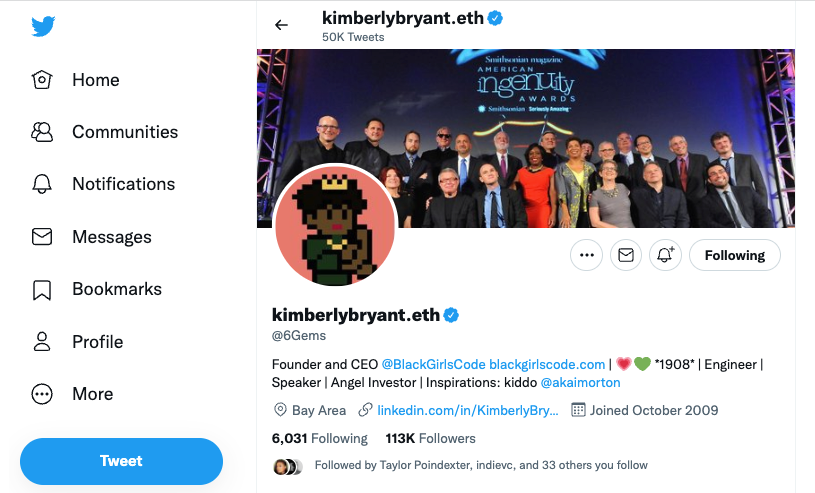
Chris Ducker
Chris Ducker is a UK-based entrepreneur who “helps midlife leaders and entrepreneurs build future proof businesses around their expertise” with his Youpreneur coaching program.
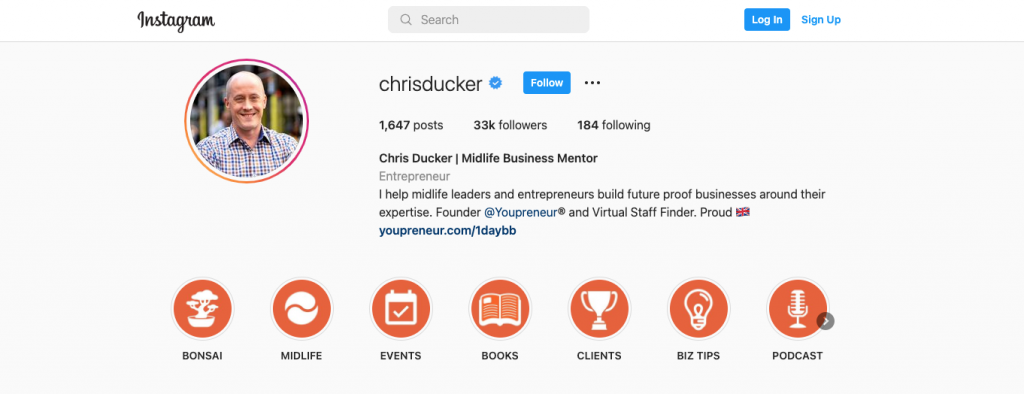
Pat Flynn is a serial entrepreneur, dad, and husband who also has a physical product and a Pokemon card side hustle with over 100,000 YouTube subscribers. Here’s his Instagram profile:
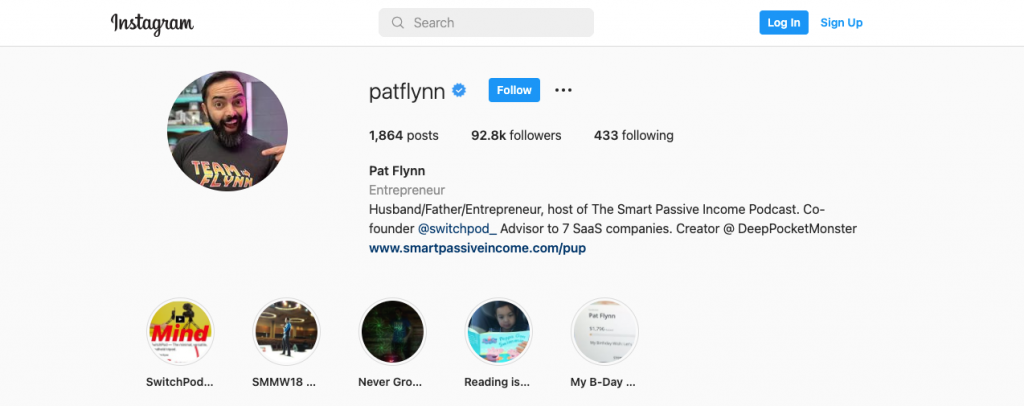
Rand Fishkin
Rand is also a serial entrepreneur and currently the CEO of Sparktoro, an audience insight software tool. He’s formerly the cofounder and CEO of Moz, an SEO software suite. His LinkedIn bio says succinctly what he does, and also adds a bit of personality to let you know what he believes.
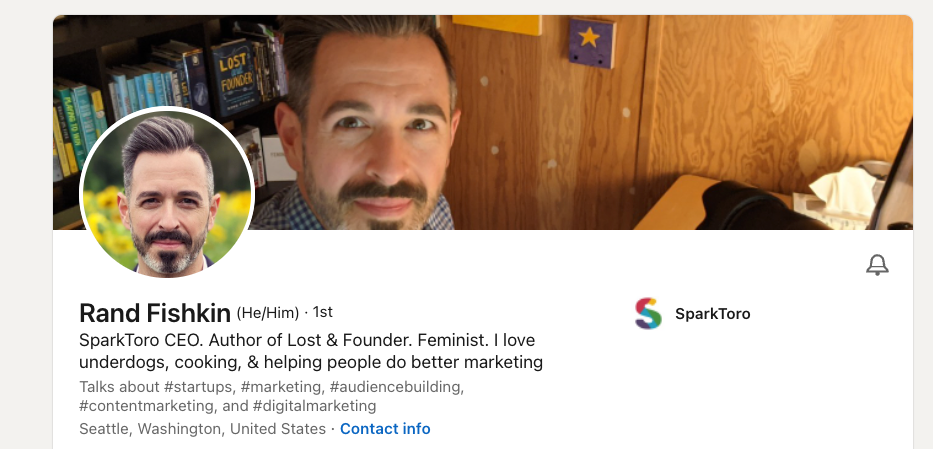
John Doherty
John is the founder and CEO of Credo and EditorNinja. (Hi, I’m John writing this!). His bio tells you what he cares about (his family and Colorado), what he does and the various projects he works on as well as his accomplishments.

Publishing on the internet?
Are you publishing on the internet and care about the correctness and quality of your content?
Click here to schedule a free editorial assesssment to learn about how EditorNinja can solve your copy editing and proofreading problems.
Your Word Balance is Zero!
It looks like you’re making great use of EditorNinja. Nice work!
You have a few options from here:
- Keep adding documents to your account, knowing that they’ll be edited after your next billing cycle begins.
- Add some Anytime Words (one-time purchase, use in the next 12 months) and we’ll start on your overflow documents sooner. Click here to see options .
- You can also increase your monthly subscription. Reach out to your contact on our team about this
Remember, you can always adjust priority on documents if you need specific ones back sooner. Just remember to let your editing team know in Slack.

How to Write a Short Bio: 5 Examples and Templates
By Status.net Editorial Team on June 16, 2023 — 12 minutes to read
- How to Write a Short Bio Part 1
- What to Include in a Short Professional Bio Part 2
- Example of a Formal Short Bio Part 3
- Example of a Casual Short Bio Part 4
- Examples of Well-Written Short Bios Part 5
- Short Bio: Best Templates Part 6
- Tips for Writing a Short Bio Part 7
- Optimizing Your Bio for Different Platforms Part 8
A short bio is a concise and informative summary of your professional background, accomplishments, and personal interests. It’s an opportunity for you to introduce yourself to others, whether it’s for networking, job applications, or social media profiles. By writing a short bio, you allow others to quickly understand your expertise, strengths, and personality.
As you write your short bio, consider your audience and tailor the content accordingly. You might want to have different versions of your bio for varying contexts, such as a professional conference, a job application, or a social media platform. Regardless of the situation, strive to be authentic and maintain a tone that reflects your personality while also adhering to professional standards.
Part 1 How to Write a Short Bio
When writing a short bio, first focus on being concise and relevant. A short bio should be approximately 4-6 sentences or about 150 words. Be sure to highlight your achievements, experience, and expertise with confidence and clarity.
To start, introduce yourself briefly, including your name, title, and current role or profession. Next, mention your most significant accomplishments in your field thus far. This can include awards, certifications, publications, or any other relevant milestones. Discuss your current work and projects, providing the reader with a snapshot of your professional life. Make sure to emphasize your unique strengths and specialties. Then, touch upon your education or any other credentials that showcase your expertise.
“Jeremiah Smith, an award-winning graphic designer, specializes in creating visually stunning websites and marketing materials for a diverse clientele. With over 10 years of experience, Jeremiah has led branding projects for major corporations and small businesses alike, receiving accolades for his innovative design solutions. Currently, he serves as the Creative Director at X Design Studio, where he is dedicated to helping clients grow their digital presence. Jeremiah holds a Bachelor of Fine Arts in Graphic Design from the prestigious Art Institute of Chicago.”
For a stronger impact, customize your short bio by tailoring it to the specific platform, audience, or purpose. By prioritizing information and emphasizing the most relevant points, you can create a brief, engaging bio that showcases your unique skills and accomplishments.
Part 2 What to Include in a Short Professional Bio
- Your job title and current role : Start by mentioning your current role and the industry you’re working in. This helps to establish your expertise and gives readers an immediate understanding of your professional focus.
- Career accomplishments and milestones : Highlight a few significant achievements in your career thus far. These can be successful projects, promotions, or awards you’ve received. Be specific about what you’ve accomplished and how it demonstrates your expertise.
- Skills and qualifications : Briefly mention the key skills and qualifications you possess that make you an expert in your field. This can include technical abilities, soft skills, certifications, or degrees.
- Interests and personal touch : Add a few personal details that showcase your interests and passions outside of work. This can humanize your professional persona and help you connect with readers on a more personal level. However, be careful not to share too much personal information.
- LinkedIn and networking opportunities : Include a link to your LinkedIn profile or other professional social media accounts. This provides readers with an opportunity to connect with you and discover more about your background.
To present this information effectively, write your short professional bio in the third person and maintain a confident, knowledgeable, and clear tone of voice. Keep the content concise and easy to understand by breaking it into paragraphs and using formatting elements such as bullet points and bold text when necessary.
Here is one more example of a well-crafted short professional bio:
“John Smith is a seasoned marketing manager with over 10 years of experience in the tech industry. He currently leads product marketing efforts at X Company, where he has successfully launched new products and significantly increased market share.
John holds a Bachelor’s degree in Business Administration and is certified in digital marketing. His expertise includes strategic planning, content creation, and driving brand awareness through innovative campaigns.
In his free time, John enjoys hiking, photography, and volunteering at the local animal shelter. Connect with him on LinkedIn to learn more about his professional experience and accomplishments.”
Taking Into Account Personal and Professional Aspects
Try to strike a balance between your personal and professional aspects:
- Make sure to mention any relevant professional accomplishments and skills that showcase your expertise in your field. If you are a student or a working professional, add details about your university, current position, or professional experiences that give readers an insight into your capabilities.
- Don’t forget to add a touch of personality to your bio. Including personal details, interests, and hobbies will make you more relatable and create a connection with your audience. However, try to keep these personal elements brief and relevant to your overall bio. For example, if you are writing a bio for a personal website or Twitter, you could mention that you are an avid painter or a dedicated volunteer at a local animal shelter.
When writing in the second person, use short paragraphs to make your bio easy to read and understand. For instance:
- Full name: Briefly mention your full name at the beginning of your bio.
- Professional skills: List your core skills and accomplishments in bullet points or a table format.
- Personal interests: Share some hobbies or interests related to your profession or that showcase your values.
- Personal goals or mission statement: Include a sentence or two about your professional philosophy and core values to give readers a sense of your personal brand.
Related: How to Write a Personal Mission Statement (20 Examples)
Be cautious with the contact information you provide, especially if your bio will be accessible to the public on your personal website or social media profiles. Make sure only the necessary details are included to avoid any privacy concerns.
In summary, your short bio should be a reflection of both your personal and professional self. Showcase your skills and accomplishments while adding personal touches to make it engaging and relatable. Keep the text concise, use appropriate formatting, and remember to maintain a confident, knowledgeable, neutral, and clear tone throughout your bio.
Related: What Are Your Values? How to Discover Your Values
Selecting the Tone for Your Short Bio
Selecting the right tone for your short bio is crucial to portraying yourself in the way you want to be perceived. Consider the context in which the bio will be read and choose a tone accordingly. There are two main tones you can adopt: formal and casual.
Part 3 Example of a Formal Short Bio
Formal Tone : If you’re writing a bio for a professional context, such as a job, conference, or publication, opt for a formal tone. This means using more sophisticated language, avoiding slang, and maintaining a professional vibe throughout the bio. To achieve this, write in complete sentences, utilize proper grammar and punctuation, and highlight your achievements and expertise. Be sure to remain confident and clear in your writing. Example: “Dr. Jane Doe is a renowned expert in the field of molecular biology, with over 15 years of research experience to her credit. As the recipient of several prestigious awards, Dr. Doe’s groundbreaking work has had a significant impact on the scientific community.”
Part 4 Example of a Casual Short Bio
Casual Tone : A casual tone works well for less formal situations, such as bios on personal websites, blogs, or social media profiles. Here, you can use more relaxed language and showcase your personality. However, it’s still important to sound knowledgeable and approachable. Feel free to use contractions, incorporate humor, and speak directly to your audience to create an engaging tone.
“Hey there! I’m John, a travel enthusiast who loves exploring new cultures and tasting exotic dishes. When I’m not backpacking across the globe, you can find me geeking out about the latest tech gadgets or sipping on a well-crafted cocktail.”
In both cases, whether formal or casual, always ensure that your voice is confident, neutral, and clear. Remember to keep it concise, avoid exaggeration or false claims, and maintain a second-person point of view.
Part 5 Examples of Well-Written Short Bios
Short bio example 1.
Jane Smith is a marketing expert with over 10 years of experience in helping brands elevate their online presence. With a passion for storytelling, Jane excels in creating content that engages and inspires. In her free time, she enjoys hiking, photography, and exploring her city’s local coffee shops. Connect with Jane on LinkedIn or follow her on Twitter @JaneSmith.
Short Bio Example 2
John Doe is an experienced software engineer with a knack for developing cutting-edge applications. Specializing in full-stack web development, John’s expertise lies in JavaScript, Python, and Node.js. When he’s not coding, John can be found playing the guitar, tutoring local students in programming, or cheering on his favorite esports team.
Part 6 Short Bio: Best Templates
Short bio template 1.
[Your Name] is a [industry or profession] expert with [number of years] of experience in [specific skills or areas of expertise]. [He/She/They] specializes in [technical skills or industry knowledge] and has a passion for [relevant interests]. In [his/her/their] free time, [your name] enjoys [hobbies or activities]. Connect with [your name] on [social media platforms] or through [his/her/their] website.
Short Bio Template 2
As a [occupation or field], [Your Name] incorporates [unique qualities or skills] to produce [specific type of work]. With a background in [relevant experience], [He/She/They] has been able to [achievement or accomplishment] through [personal path or passion]. When not [working or creating], [Your Name] spends [his/her/their] time [hobbies or activities], always seeking new inspiration.
[Your name] is a [profession or role] with a background in [relevant expertise or industry]. [He/She/They] earned a [degree] in [field] from [institution]. [Your name] has [number of years] experience in [profession/industry], providing [valuable service or skill]. Outside of work, [your name] enjoys [hobbies or personal interests]. Connect with [your name] on [social media platform] or visit [your website or portfolio].
Customize these examples and templates to fit your own unique skills, experiences, and personality. Using a second person point of view, focus on the key aspects you want your audience to know about. Be confident and transparent about your achievements and interests, and let your short bio speak for itself. Happy writing!
Part 7 Tips for Writing a Short Bio
- Know your target audience : Consider the people who will be reading your bio and focus on the information that will be most relevant to them. Tailor your bio to best serve their needs and expectations.
- Highlight your accomplishments : Share information on your achievements, awards, and notable experiences. This will give your audience an understanding of your expertise and success in your field.
- Include your goals and mission statement : Tell your audience what drives you and what you hope to achieve. This can help create a connection with the reader and showcase your dedication to your work.
- Maintain a professional tone : Write in a clear and concise manner, avoiding casual language and slang. A confident and knowledgeable tone will convey your competence in your field.
- Keep personal information to a minimum : While you may choose to mention some personal tidbits, be mindful of what you share. Focus on information that enhances your professional image, rather than oversharing personal details.
- Promote your brand and company : If you represent a business or have a personal brand, mention your company name and mission statement. This can help reinforce your brand identity and make a stronger impression on your audience.
- Prioritize transparency and authenticity : Be honest about your experience and qualifications. Avoid exaggerating or making false claims in order to maintain trust with your audience.
- Limit self-promotion : While it’s important to show off your accomplishments, be sure to keep the focus on meaningful information rather than excessive self-promotion. This will help engage readers and build credibility.
- Use formatting to enhance readability : Break up your bio into paragraphs, use bullet points for lists, and bold text for important details. This will make it easier for your audience to read and understand your bio.
- Include contact information : Provide a way for your audience to get in touch with you, whether it’s an email address, phone number, or a link to your website.
Part 8 Optimizing Your Bio for Different Platforms
On LinkedIn , focus on your professional achievements and skills. Use bullet points or a table to highlight your most significant accomplishments. Feel free to include any relevant certifications, courses, or awards. Remember that LinkedIn is a professional networking platform, so maintaining a professional tone is crucial.
For a resume , your bio should be concise and focus on summarizing your career history and specific expertise. Make it easy for potential employers to grasp your main strengths quickly. Use bold text to emphasize crucial information, such as your job title, years of experience, or industry-specific skills.
On a personal website , you have more freedom to express your personality and showcase unique aspects of your life. Consider adding anecdotes, hobbies, or personal achievements to give visitors a glimpse of who you are outside of your professional life. You can also touch on your professional capabilities but keep it concise.
For Twitter , keep in mind the character limit for bios and make every word count. Capture your profession or industry, and maybe add a touch of your personality or interests through emojis or hashtags. It’s common to see authors and celebrities mention their latest projects, books, or achievements here.
Frequently Asked Questions
What are the essential elements of a short bio.
A short bio should include:
- Your name and current role or profession.
- Brief background information including education and relevant work experience.
- Notable accomplishments or skills relevant to your profession.
- Personal interests or ambitions that showcase your personality.
- A call-to-action, such as directing readers to your portfolio or LinkedIn profile.
How can I create a compelling short professional bio?
To create a compelling short professional bio, follow these steps:
- Start strong with a clear and concise introduction.
- Focus on your most relevant qualifications and experience.
- Highlight key achievements and successes.
- Provide a personal touch that showcases your unique attributes.
- Keep it brief and easy to read, aiming for around 100-150 words.
What are some tips to make my short bio stand out?
- Use vivid language and strong, active verbs.
- Tailor your bio to your audience, emphasizing information that is most relevant to them.
- Share a unique or unexpected personal interest to pique interest.
- Edit and proofread your bio carefully, ensuring it is free of errors and reads smoothly.
How can I tailor my short bio to different contexts?
Adjust your short bio for different contexts by:
- Focusing on relevant skills, experience, or accomplishments for each specific audience.
- Adjusting the tone or language to suit the platform (e.g., more casual for a social media profile or more formal for a conference bio).
- Emphasizing specific personal interests or accomplishments that align with the context or audience.
- Updating your call-to-action as needed to direct readers to relevant content or profiles.
Related: 150+ Awesome Examples of Personal Values
- 20 Inspiring Examples: How to Write a Personal Mission Statement
- 20 Examples of Life Goals
- How to Write Inspiring Core Values? 5 Steps with Examples
- Core Values List: 150+ Awesome Examples of Personal Values
- How to Live By Your Values
- 7 Examples: How to Write a Short Notice Resignation Letter

20 of the Best Short Professional Bio Examples to Inspire You

Every working professional needs a short bio to make a positive statement about their skill set. Whether it’s for a LinkedIn bio, Twitter account, or business website, this bio needs to be brief and striking to captivate readers and invite them to learn more about you.
Everyone needs three types of bios, long, short, and two-liners.
- The long bio can be a page and goes on your website.
- A short bio is about a paragraph and is used as your default bio.
- Your bio should summarize your professional qualification and experience, accomplishments, and skills.
Each of these bios should make you stand out from other professionals. They should explain why people would want to work with you.
With that in mind, here are 20 of the best short professional bio examples. Hopefully, you can use these examples to create your engaging bio.
1. Rebecca Bollwitt
You should include a professional bio on all of your social media accounts and website. Some people craft a single professional bio template. However, each platform is different, and so it’s important to mix it up accordingly.

LinkedIn is a professional network where you can showcase your professional background and qualifications to prospective clients. Facebook is more geared towards personal interactions, while Twitter is more concise and direct. Meanwhile, Medium requires a deeper and more detailed bio.
2. Lena Axelsson
You should use a well-written professional bio if you publish content on industry-relevant websites. Niche websites are a great spot to share your professional experiences with people who work in your sector..

In this example from Lena Axelsson, she begins her bio by first connecting with the readers. She acknowledges the problems that her audience is suffering from and empathizes with them.
She then proceeds to explain how she helps clients and the benefits they can gain from her services. More importantly, she highlights her professional skills and qualifications, how she differs from other practitioners in the field, and why she would be best suited to help the clients and their families.
The final paragraph then showcases her educational background, an important piece of information for readers. Overall, the professional bio is compassionate, empathetic, and understanding– traits that are crucial in counseling clients.
3. Audra Simpson
Another great bio example on the professional website is from Audra Simpson, an Anthropology professor from Columbia University. Here is the bio that she uses on the University website.

Professional bios are often written in the first person to give it a personal touch, but in this example, it’s written in the third person to give it more authority. It also allows the writer to showcase her impressive accomplishments and qualifications without sounding boastful.
In a limited space, the professional bio shares her work experience and interests. It displays Audra’s credentials, specializations, and even her work ethic.
4. Corey Wainwright
Corey Wainwright’s professional bio on HubSpot’s website is the definition of keeping it cute and simple. As mentioned in her bio, she is a content marketer for the company, among other things. With less than 25 words on her bio, she presents a very approachable and friendly vibe to the readers.

Even though it’s written in the third person, the bio has character due to its casual and personal content. It’s almost as if she’s giving readers a piece of her personal life.
This professional bio connects to her social media profiles so people can learn more about Corey. This type of bio doesn’t work in every situation. Some websites require a more serious tone, so it’s important to assess the medium before crafting your professional bio template.
5. Marie Mikhail
When companies look for recruiters, they would want to hire someone passionate and genuinely interested in the field and your product.

Marie Mikhail makes this particularly known to the readers. Not only does she express her love for recruiting, but she also presents a relevant story about it. Telling a story is also a good tactic in professional writing.
Some may not find talent acquisition the most interesting career path out there, but Marie does a good job turning a relatively dull topic into something exciting. This LinkedIn bio from her profile details her professional experiences and her love for the company’s products. She also includes relevant qualifications to build up her profile.
6. Megan Gilmore
Another good example of a professional bio on Instagram is from cookbook and food writer Megan Gilmore.
Most professionals try to establish themselves on one or two platforms first instead of selling themselves short on over five or ten other platforms. Focusing on a few platforms allows you to customize the content for each platform, which means you’ll need two different bios.
You can use these bios to cross-promote your brand on each platform.

Megan does this by highlighting her “no fad” writing style and listing down some books she has written. After this, she uses a pointing emoji to link her LinkedIn profile where readers can access her recipes.
This is a great way to show off her credentials to potential book buyers.
7. Tim Cook
Tim Cook is the CEO of the multinational technology company Apple since 2011. You would think that, with such a massive title, people who visit Apple’s website already have a pretty good idea of who he is.

Nonetheless, Tim’s professional bio on Apple’s website doesn’t assume this. It is professionally written and highlights his position as Apple’s CEO. It also includes the fact that he serves as one of its board of directors.
Moreover, it narrates details about his earlier career and his time as COO of Apple. Even with such an impressive resume, he provides readers all the information they need to know about him.
8. Shaquille O’Neal
Most professional bios, like some of the examples above, are written in the third person. That can make it sound more professional. It also allows people to list their experience and qualifications without sounding like they’re bragging.
Writing in the first person can also be highly effective.

This is exemplified by NBA legend Shaquille O’Neal’s LinkedIn bio. Aside from being a famous athlete, he also has a bachelor’s, a master’s, and a doctorate.
Since it’s something he is most known for, Shaq begins his bio with his greatest achievement as a basketball player. He then proceeds to his accomplishments and credentials outside of basketball by detailing his business ventures with some of the big brands he’s worked with and his speaking events nationwide.
He is a man of many talents, and professional bio writing is one of them.
9. Richard Branson
Richard Branson starts off his professional bio by introducing the Virgin Group, a British company he founded. He is a man known equally for his failures as well as his many successes.

His bio summarizes his career, but the last few sentences are the highlight. He shifts from a professional tone to a more fun and personable one by using the term “tie-loathing adventurer” and referring to himself as “Dr. Yes.”
10. Anthony Gioeli
If not written properly, bios tend to sound boastful, making some professionals hesitant to talk about themselves and their achievements. However, highlighting these achievements and skills is important as it can attract people to do business with you.

Anthony Gioeli holds no stops in boasting his professional accomplishments. Rather than sounding big-headed, he does it confidently and factually. One of the skills he highlights is being an expert negotiator working with multimillion firms like Vodafone.

Notice how his professional bio has good formatting. He does this by using a series of paragraphs and bullet points to present information to readers.
While keeping your professional bio short and concise is effective, you can also be detailed like Anthony– you just need the right format.
11. Katrina O.
Professional bios can sometimes seem repetitive and boring, which is why putting a little spin on it can work wonders. To do this, you will need to arouse curiosity from your readers so that they’ll be encouraged to read further.

Katrina Ortiz does this in her LinkedIn bio. The first sentence alone sparks intrigue by using a line like “caught fire coding.” It’s different and, in turn, intrigues readers. Even her name ‘Katrina O.’ catches your attention.
In just three words, Katrina could captivate readers and give them an idea of her work. As an enthusiastic software developer, she highlights both her professional and personal experiences. She also shares the programming languages she is proficient with.
12. Karen Abbate
We love a good list. Lists are a good way to organize ideas or thoughts in an easier way for readers to grasp. While it’s an unusual method in writing professional bios, it’s probably more unusual than this example from Karen Abbate uses numbers instead of bullet points.

In her list, she presents six important and notable things about her professional and personal details. She uses a confident and professional tone, just enough not to sound boastful. She starts by mentioning impressive brands she’s worked with and discusses her love for everything on the web.
The bio also details her educational background, work experience, and passions. She also shares a personal backstory and relates it to her work. All in all, it is an innovative bio.
13. Gijo Mathew
Another good use of the list on LinkedIn bios is this example from Gijo Mathew. A list can help improve readability and organize information that, if written otherwise, can seem complicated. Appearance-wise, it also makes the bio seem more compelling.

In this bio, Gijo uses bullet points to list information to express why clients should choose to work with him. It makes his LinkedIn profile look more interesting and easy to grasp.
14. Genevieve McKelly
LinkedIn is one of the most important channels for promoting yourself. You will need this perspective when crafting your professional bio on LinkedIn.

A social media marketer’s mission is to instigate engagement or start a conversation among readers or consumers. Genevieve McKelly encourages this conversation by giving readers book and podcast recommendations in the last few sentences of her bio and, in turn, asking the readers for recommendations too. It’s a great ice breaker and makes her sound friendlier.
Aside from asking for great reads and listens, she also throws in an industry-related question. She then ends it with approachable words that welcome discourse.
15. Darrell Evans
Identifying customer pain points is important in setting up marketing campaigns or a business in general. Pain points are specific problems that potential customers may be experiencing.

In this bio by Darrell Evans, he brings up a common pain point that most businesses suffer from: spending money on marketing and not the return on investment. Darrell then gives them a solution by telling readers the kind of work he does and the benefits it offers.

Going further, he introduces who he is and what his company does. He also gives readers some facts and figures to suggest that his professional services are the best and help them solve their marketing predicament.
16. Fernando Silva
Professional bios almost always start with the ‘professional’ aspect rather than the bio. It’s a common formula to showcase your credentials before adding a personal touch to make it seem friendlier and more approachable.

However, Fernando Silva mixes things up with his LinkedIn bio by starting with personal information first. He kicks things off by describing himself as a “city dweller who loves to travel” and then proceeds to more professional details like his experience in SaaS.
Although short, it is a very passionate bio because it showcases things that he loves, like traveling and meeting new people.
17. Nikki Ivey
Being relatable is a great way to connect with potential leads and clients. Nikki Ivey does this by sharing a heartfelt story about the struggles she had to face to become the “sales coach wing-woman” she is today.

Her story shows empathy and allows readers to relate to her. It also encourages conversation among readers who may have experienced a similar situation. With this shared history, readers can get emotionally invested in her and make them open to working with her.

However, this approach can be tricky as it needs to be sincere and relevant enough to attract attention.
18. Raphael Parker
You should include your professional experience in your bio. Raphael Parker shows off his experiences in a very unique, unconventional way. He uses the term ‘ex’ to refer to his work history. He then indirectly discusses his current work by presenting it as a passion instead of a career.

Raphael’s bio leaves a lot to the reader’s imagination but builds him up as an experience career man nonetheless. That is pretty impressive, considering he only uses a few words and sentences.
19. Allison Zia
First impressions count. Having a striking first sentence in your professional bio can hook your readers into learning more about you.

These first sentences are typically a few words long but should have a lasting impact. Allison Zia does this with only five words: “I like to solve problems”. It’s a bold statement that makes you want to read more.
Allison moves on to her work experience, specialities, and skills to sustain her reader’s attention. She also includes relevant examples to relate to readers.
20. Ann Handley
Ann Handley’s bio is a great example of how even a few words can make the best impression. She is an experienced marketer and, although many can claim this to be true, she evokes this kind of credibility with her choice of words.

She encourages readers to read more by clicking a link on her website with little information she provides. Even after clicking the about page of her website, she keeps things short and simple by dividing information with bullet points. If readers are interested to learn more, she provides a few relevant links.
This bio used as her header highlights her achievements as a writer, speaker, and partner in a major marketing company.
A professional bio is your opportunity to attract a potential client, customer, or employer. Some may be short, while some may be detailed. The bottom line is that they should make you stand out in a crowd.
Use these examples as helpful templates you can use in creating your compelling professional bio.
About the author
Nicholas Prins
I'm the founder of Launch Space. We work with global companies helping them scale lead generation through SEO and content marketing. Head over to the homepage to find out more.

25 Most Popular Online Shopping Websites

How To Easily Unblock Adobe Flash On Google Chrome
Explore Jobs
- Jobs Near Me
- Remote Jobs
- Full Time Jobs
- Part Time Jobs
- Entry Level Jobs
- Work From Home Jobs
Find Specific Jobs
- $15 Per Hour Jobs
- $20 Per Hour Jobs
- Hiring Immediately Jobs
- High School Jobs
- H1b Visa Jobs
Explore Careers
- Business And Financial
- Architecture And Engineering
- Computer And Mathematical
Explore Professions
- What They Do
- Certifications
- Demographics
Best Companies
- Health Care
- Fortune 500
Explore Companies
- CEO And Executies
- Resume Builder
- Career Advice
- Explore Majors
- Questions And Answers
- Interview Questions
The Best Short Professional Bios (Examples + Templates)
- Resume Tips
- Best Resume Writing Services
- Things To Avoid On A Resume
- Resume Paper To Use
- What To Include In A Resume
- How To Write A Bio
- How To Write A Personal Statement
- Lied on Your Resume?
- Avoid Age Discrimination
- Words and Phrases You Shouldn't Include in Your Resume
- How Many Skills Should You List On A Resume
- Send A Resume As A Pdf
- Resume Critique
- Make A Resume Stand Out
- Resume Spelling
- Resume Past Or Present Tense
- How To List Projects On A resume
- Best Resume Action Words
- How To Quantify Your Resume
- Resume Bullet Points
- Are Resume Writers Worth It
- How Many Jobs To List On Resume
Summary. To write a short bio you should first make an initial introduction introducing yourself in the first or first person. Your short bio should include your brand, your accomplishments, and your values and goals. Your short bio should be one to three short paragraphs or four to eight sentences long.
Knowing how to write a concise, informative, and interesting biography about yourself can help throughout various parts of the professional process. You can use your bio to capture the attention of potential employers or clients and convince them to choose to employ or work with you.
In this article, you’ll learn more about what goes into a short bio and how to write one, and you’ll also get to see some short bio templates and examples to help you get an idea of what yours should look like.
Key Takeaways
A short bio serves to introduce you, your achievements, and what you offer professionally to potential employers or clients.
It’s important to keep your bio brief so that readers stay engaged and will remember your main points.
You may need to adjust your bio for different audiences, as your clients may want to know different information than a recruiter would.
Talk about your skills and accomplishments in your bio, but don’t exaggerate them.

What Is a Short Bio?
How to write a short bio, what to include in a short professional bio, short bio examples, short bio templates, tips for writing a short bio, writing a short bio faq.
- Sign Up For More Advice and Jobs
A short bio serves as your introduction to the professional world. In terms of finding or expanding on your job, a bio will cover your:
Work history
Achievements
Any other relevant professional information
Think of it as a professional memoir that a hiring manager or consumer can read and understand quickly. It’s usually about one to three paragraphs depending on experience.
There’s an emphasis on being succinct when it comes to writing a professional bio. This is because a bio is supposed to be a preface to attract recruiter attention and incline them to reach out for more information. Many readers will get lost or bored with a lengthy bio.
Using a short bio can be helpful across very different industries, from marketing to accounting, from psychiatry to sales.
You’re probably familiar with providing short bios on social media websites and applications. While the information and skills you include in a professional bio may differ, the general formatting is similar.
There’s a lot of considerations to take into account when writing a short bio, and it can quickly become intimidating. Deciding what information is relevant and how to keep it near 140 characters is no small task.
If you’re having difficulty writing a short bio, follow the outline below to craft an introduction that engages your reader.
Make an initial introduction. You can’t jump right into everything you’ve done and what you want to do in the future before introducing yourself.
Your bio’s first sentence should begin with your full name in the third person or introduce yourself in the first person and continue to briefly outline your most notable skills and accomplishments. It’s a good place to state your current job and employer.
Go deeper with what motivates you. Once you’ve catchily illustrated who you are in your short bio, you can use the second sentence to describe your motivations for your work.
Stating what drives you to do the work you do is essential to employers and customers alike. Whether you work as a physician or fitness consultant , there’s a reason why this is your profession, and you should explain that in your short professional bio.
Describe your accomplishments. Your short bio is for detailing why you’re the ideal candidate to be trusted with handling an employer or consumer’s business. By describing your prior accomplishments, you let them know what you could offer as an employee and how you’ve succeeded in the past.
While you should avoid sounding braggy, the reader is looking for information about what your qualifications are , and your accomplishments generally measure these qualities.
Even though you could probably go on for ages about the details of your accomplishments, save that for an interview . In a short bio, only include the most impressive of your achievements to outline.
Accomplishments relevant to a short bio could include:
Impressive results on a project
Former promotions
Awards received in your field
Certifications received
Include contact information. The purpose of a short bio as either a business or a job seeker is to inspire the reader to reach out. Without contact information, this pursuit becomes futile. Make sure your short bio has some way to contact you at the end.
Relevant contact information may include:
Phone number
Professional networking profile
A short professional bio includes:
Your full name. You can choose to write your bio in the first person (I, me, my) or third person (he, she, they), but either way, you need to include your full name at some point. Branding doesn’t work so well without a brand name (i.e., you!)
Your brand. Of course, if you have an actual brand that you’re trying to market, you should include the brand name as well.
What you do. Summarize what you want the reader to know about what you do in one sentence — tricky, we know.
Your accomplishments. For a short bio, you can stick with just one major accomplishment from your professional life. Or, if you have a string of impressive achievements, try condensing all of them down to one sentence.
Your goals and values. Let the reader know what makes you tick — why do you do what you do and what do you hope to achieve with your work? People are compelled by a story more than anything else, so it’s important to get this part right.
Something personal (optional). If you have a quirky tidbit about yourself you’d like to include, go for it. Just make sure it doesn’t throw off te the tone of the rest of your bio.
Contact info (optional). If your bio is serving as a call-to-action to drum up business or get leads on job opportunities, it makes sense to include your contact information at the end of your bio. It’s not necessary if that information is available elsewhere on the page , though.
Entry-Level Job-Seeker Bio Example
Mitchell Morrison is an upcoming video producer and editor who believes in the art of visual organization. He is a recent graduate from the University of Washington and focused on post-production during his time studying there. He was introduced to the magical world of visual art production by watching his father work on editing commercials growing up and has been working towards his dream of becoming a video editor ever since. During his last year of college, Mitchell participated in a competitive internship with Digital Space Films. He was chosen out of 2,000 applicants based on his academic portfolio and personal statement essay. This internship was an incredible learning experience and resulted in three professional accreditations for music video editing. Mitchell currently lives in Seattle, Washington pursuing freelance opportunities and spending time with his Dog, Pikachu. To get into contact with Mitchell: MitchellMorrisonVideo.com/contact
Working Professional Website Bio Example
Lisa Kennedy is an experienced real estate professional. She knows how important a home is for long-term happiness and has invested her career in putting people in the house they’ve always dreamed of. Lisa was driven to pursue real estate from her passion for helping people during life-altering times, and a keen interest in high-end, luxury homes. She’s been working in the real estate industry for ten years and in that time has assisted over 3,500 people in finding homes. She was educated at the University of Los Angeles with a bachelor’s in business management. She’s worked for some of the most respectable Real Estate companies in Los Angeles and individually under her agency “Kennedy Homes.” Lisa has also been published in Real Estate Quarterly Magazine as the 2017 winner of the “Top Luxury Home Seller” award. Lisa loves the culture of Los Angeles and has been living there with her family of five since she graduated from college. She enjoys spending her free time exploring towns along the West Coast and swimming. If you’d like to get in touch with Lisa: Email: [email protected]
Professional Networking Profile Bio Example
Bianca Jones Marketing Manager Miami, FL The first step towards customer satisfaction is being reached by stellar product marketing, and that’s what I aim to provide. My professional experience as a product marketing manager has allowed me to assist many organizations in improving their sales margins and audience response to emerging products. I’ve brought dedication and positive results to the companies I’ve worked for because I am passionate about product perception, marketing, and business statistics. What drives a product to success interests and inspires me. I specialize in long-term growth strategies and audience outreach. In addition to eight years of experience in professional product marketing, I have also published two books on creating a career as a marketer called “What to Do After Your Bachelor’s” and “A Marketer’s How-To.” If you’re interested in learning more about how to market your business better, or just discuss more, feel free to contact me by email at [email protected].
Your first choice is whether you want your bio to be written in the third person or first person. These short bio templates show both options, and also include different ideas for what to include, and how. Feel free to pick and choose your favorite parts of each of the two.
[Full Name] is a [job title] who [believes/knows] in the power of [what you do]. [He/She/They] began their journey in [field] by [how you got started in the field], and now dreams of [what you hope to accomplish]. [His/Her/Their] biggest accomplishment to date has been [your biggest accomplishment]. [Full Name] lives in [where you live] and participates in [a hobby/interest]. To get in touch with [Full Name], call/email/message me on [how you’d like to be contacted].
I am a [job title] who helps [who you help] [what you help them do]. It’s my belief that [your unique perspective on the field]. In the past [# of years] years, I’ve [major accomplishment #1] through [how you accomplished it]. I have a passion for [your professional passion], but on the side, I also enjoy [personal passion]. Get in touch with me today at [contact info] — I look forward to talking with you about [what you want to talk to your readers about].
You have a firm grasp of the structure of a short bio and what to include. Now, you may need some tips for how to polish your short professional bio and make it stand out from the competition.
Be mindful of length. While you’re probably getting sick of hearing that your bio should be short, it’s good to keep in mind throughout the writing process. It’s easy to go off on a tangent while trying to include everything relevant or rationalize, making your bio too long.
Avoid this impulse. The point of a bio is that it’s limited. You want to intrigue the reader enough to inspire them to seek more information about you or your services.
Tailor your bio to your intended audience. Whether you’re using a short bio to attract a particular customer base or potential employer, tailoring it to fit their wants and needs is crucial. Consider your intended audience base and what they’re looking for in a candidate or service.
Be genuine. Your short bio should be an authentic representation of your traits, experience, and personality. People are repelled by what they interpret as stretching the truth. If you’re being received as disingenuous by the reader, they’ll probably move on.
Proofread. The only way to steer clear of errors in your short bio is by proofreading it. Imagine a hiring manager being completely interested in your bio.
They love what you have to say about yourself and find your prior experience enticing. That is, until they come across a mistake that clearly shows you didn’t do proofread or edit.
Include links to your portfolio, website, or networking profile. One way to circumvent the confining factor of keeping your bio short is by including links to more detailed sources.
This can be in the form of linking your portfolio or website to allow the reader to go deeper into your discussed skills if they please, without taking up more space in your bio.
Implement these links seamlessly into your bio by attaching them to anchor words that describe what clicking will lead them to.
Add some personality. You aren’t the only person who has an impressive list of accomplishments to put on a bio, so you’re going to need to find some additional ways to make an impression.
What should a short bio include?
A short bio should include your name, what you do, and your achievements. You should also include your company or product’s brand, if you have one, and your goals and motivations for doing what you do. This humanizes you and helps you stand out from the rest of the pack.
How long is a short bio?
A short bio is typically one to three paragraphs long. These should be short paragraphs though, as other experts say that between four and eight sentences is the ideal length for a short bio.
What makes a good bio?
A good bio is succinct and memorable. Readers don’t want to spend long reading about your professional and personal life, so go back and cut it down to the important parts multiple times after you draft it. You might be surprised at how little you actually need to include.
What should you avoid putting in a short bio?
You should avoid including anything negative or arrogate. It’s never a good idea to write anything negative about previous jobs or employers. Only include positive things in your professional short bio.
It’s important to include your achievements in a short bio, but there is a fine line between mentioning your achievements and bragging about them. Stick to the facts when talking about your accomplishments.
Fremont University – Building Your Professional Bio
How useful was this post?
Click on a star to rate it!
Average rating / 5. Vote count:
No votes so far! Be the first to rate this post.

Sky Ariella is a professional freelance writer, originally from New York. She has been featured on websites and online magazines covering topics in career, travel, and lifestyle. She received her BA in psychology from Hunter College.
Don Pippin is an executive and HR leader for Fortune 50 and 500 companies and startups. In 2008, Don launched area|Talent with a focus on helping clients identify their brand. As a Certified Professional Resume Writer, Certified Digital Career Strategist, and Certified Personal Branding Strategist, Don guides clients through career transitions.
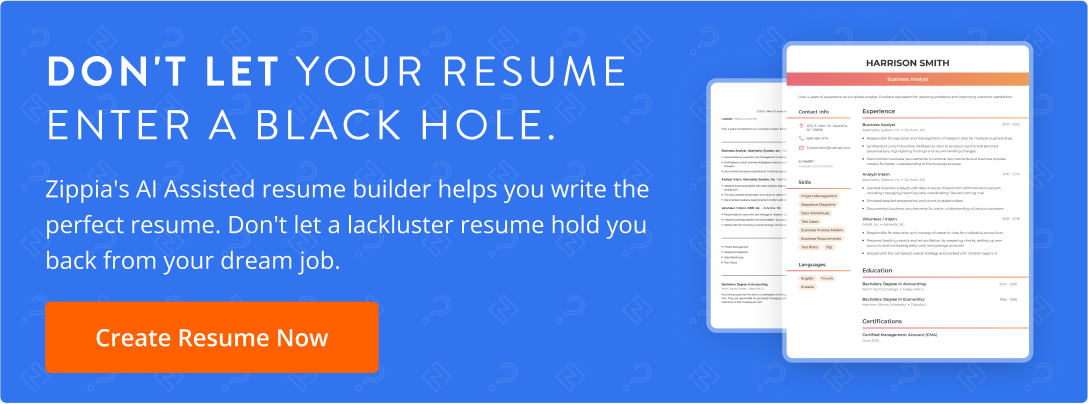
Related posts

Do Men and Women Write Resumes Differently? The Answer May Surprise You

How To Write An American Resume

267 Powerful Resume Action Words

How to Write a Curriculum Vitae (CV) (With Template And Examples)
- Career Advice >
Daring Leadership Institute: a groundbreaking partnership that amplifies Brené Brown's empirically based, courage-building curriculum with BetterUp’s human transformation platform.

What is Coaching?
Types of Coaching
Discover your perfect match : Take our 5-minute assessment and let us pair you with one of our top Coaches tailored just for you.
Find your coach
-1.png)
We're on a mission to help everyone live with clarity, purpose, and passion.
Join us and create impactful change.
Read the buzz about BetterUp.
Meet the leadership that's passionate about empowering your workforce.

For Business
For Individuals

3 stand-out professional bio examples to inspire your own

Jump to section
What’s a professional bio?
How to write a professional bio, professional bio examples to inspire your own, promote with pride.
Opportunities to self-promote can arise when you least expect them. Whether you exchange LinkedIn profiles at a networking event , receive an invite to submit a resume , or share your personal website with a potential client, branded materials that effectively describe you are crucial to making a great first impression .
A professional biography (bio) is more than a simple self-introduction or opportunity to boast — although you should promote your skills and accomplishments with pride . With such little space and so much to say, you may struggle to find the perfect words.
After all, who you are and what you do extends far beyond a couple of sentences. But conciseness is possible — it just requires a little self-reflection and guidance.
Let’s explore different strategies for writing a bio that's engaging, adaptable, and, most importantly, encapsulates your professional values and identity. With these tips and professional bio examples to guide your process, you’ll learn how to write a bio about yourself that shows off your best side.
A professional bio is a brief but impactful blurb that introduces who you are and what you do. Ranging from a few sentences to several paragraphs, it sums up your area of expertise, talents, and professional background.
Think of your professional bio as an opportunity to expand your personal brand statement , which uses marketing strategies like punchy and emotion-provoking language to sell you in a few choice sentences. Your bio includes additional information and personal touches to create a fuller picture of your professional accomplishments and future aspirations .

You never know who scans your social media profiles, company website, or resume. A thoughtful bio is adaptable and provides consistent messaging regardless of the platform and audience. Whether it’s a recruiter , client, or collaborator checking out your branded materials, your professional bio works around the clock to promote your personal brand .
Wherever you network, job search , or show off your work are all great places to include a bio. That may include:
The “About” section on your personal website, YouTube channel, or podcast , giving insight to visitors about the person behind the work
Your LinkedIn profile's summary section , providing a personal touch to the career achievements and skills highlighted in your work experience section
Promotional materials or event programs , like for a workshop, speaking engagement, or training webinar
On the team page of your organization’s website , showcasing your unique role and contributions to your team
In an author bio for blog posts and articles , establishing your trustworthiness and providing context to readers
In the bio sections of social media profiles used to promote your personal brand , adding personality to reflect your professional identity
Within a cover letter , letter of intent , or letter of interest , connecting your unique value to a potential employer’s needs
In a grant or proposal submission , lending credibility when applying for funding or pitching a project
On your online or physical portfolio , helping people connect more deeply with your work as a creative
On a book jacket, author page, or academic journal , highlighting your expertise, background, or focus areas
Adapting your professional bio template to fit different platforms helps you paint a consistent and engaging picture of yourself for varying audiences. You can control the narrative that surrounds your professional identity and reputation.
And clarity across platforms acts as a powerful call to action — the more your target audience understands what you represent, the more likely they’ll want to connect with you.
A great bio shows off your unique value, reflects your goals, and displays your personality . But, despite its highly personalized nature, you can still use templates or follow frameworks to write your own. Here are a few guidelines for writing different bio types.
How to write a short bio
A short professional bio offers your reader a quick snapshot, making it best suited for professional situations requiring brevity, like a cover letter or social media platform with character limits.
And a well-written short bio captures attention and entices your audience to follow through, carefully reading an attached resume or scrolling your LinkedIn profile.
Here are some general guidelines:
- Start with the basics: Explain who you are, what you do, and your current work. Keep it as brief as possible and focus on essential information that reflects your identity and current professional situation.
- Establish credibility: Share valuable professional triumphs to give readers insights about your unique value and credibility. Descriptors like “Award-winning” or “With 10 years of experience” are concise ways to express the breadth of your experience.
- Be personal but appropriate: Add personal touches to make your bio feel more authentic and relatable , remembering to consider context. “Adventure-loving mechanical engineer” may suit an Instagram bio, whereas “ Innovation-seeking mechanical engineer” is better suited for a professional portfolio . Each conveys a sense of personality and aligns with the goals of the medium.

How to write a long bio
A long bio offers your audience a more comprehensive understanding of who you are and what you stand for. They’re best suited for professional situations requiring a more in-depth intro, like an author page, “About Me” section, or funding proposal.
A well-crafted long bio doesn’t just illuminate key experiences and skills. It humanizes you, showing off professional goals and personal interests that capture reader attention and build trust .
Here are some general tips:
Introduce yourself: Just like you do in a short bio, the first sentence should clearly establish who you are and the work that’s most important to you. Consider mentioning your current position and clarifying your responsibilities .
Go in-depth on your values: In a long bio, you can elaborate beyond short descriptors and action verbs . Depending on the medium, tell a fuller story that adds depth to your personal values and professional pursuits.
Mixing the personal with the professional, like mentioning your alma mater and describing your first roles, adds nuance and richness to your character representation. This creates a sense of closeness and understanding with your reader.
Detail your professional journey: While the focus should be on your current job title and area of expertise, readers can build a deeper connection when they learn more about your professional story.
Consider highlighting career milestones, including certifications, notable successes, and work experience. But describe yourself with humility . Bragging about your skills and accomplishments may come off as arrogant instead of confident , a misunderstanding that might put the reader off.
General guidelines
Regardless of format, a successful professional bio follows a few basic rules, like:
Keep it fresh: Your career is never stagnant, and your personal bio shouldn’t be, either. Regularly update your bio to include new achievements, professional skills , and shifts in your career focus.
Keeping your LinkedIn bio, portfolio website, and other materials current ensures that potential employers and collaborators have access to the most relevant information about you, avoiding misunderstandings and missed opportunities.
Provide a call-to-action: You’ve captured your target audience's attention — now what? Invite readers to connect, engage, and start a conversation . Clarity can help direct the kind of engagement you want.
Something like “For consulting inquiries or collaborations, contact me at [email]. For copyright requests, contact my publisher at [email].” is appropriately clear and direct.
Proofread for consistency: Like any professional communication, always double-check for grammar and spelling mistakes. Hiring managers and clients may interpret poor writing skills as a lack of clear thinking or attention to detail , discouraging them from following up with you.
And choose a point of view (first person “I” or third person full name), staying consistent to ensure a better reading experience. You want your reader to focus on the content without bad mechanics distracting them.

Now that you have the basic rules down, here are some bio examples to help you write yours. Pay attention to flow and content, and edit them to meet your needs.
Short bio examples
Here’s a short bio for an events brochure for a graphic designer leading a workshop:
[name] is a speaker, graphic designer, and UX engineer who builds performant branding strategies with an eye for accessibility. [name] helps brands of all sorts, from startups to multinationals, transform how they tell stories through visual design and cutting-edge technologies that focus on sustainable, inclusive engagement.
And here’s a data analyst’s work bio example for LinkedIn:
I’m a certified data analyst with a natural curiosity for transforming complex data into action. With more than 10 years of experience, I’ve developed expertise in statistical modeling and predictive analysis.
Currently, I’m a project manager at TechBiz focused on enhancing business strategies through data optimization. I’ve been instrumental in driving growth for several Fortune 500 companies and was recognized in 2022 as one of “America’s Innovators” by Women in Data.
Why they work: Both bios concisely illustrate current job roles, career focus, and unique character traits. Small details like “eye for accessibility” and “natural curiosity” show personality and professional values, illustrating what they’ll be like to work with.
Long bio example
Here’s a freelance writer example for their portfolio website:
I’m a Mexico City-based freelance writer by way of Louisville, Kentucky. My weekly newsletter on sustainability, policy, and culture — Sustainability Now — has been mentioned by the LA Times, The Nation, and Vogue London and has over 20,000 subscribers.
My work recently appeared in Foreign Policy, the New York Times, and Mother Jones, where I’ve written about sustainability in cities, business, and consumption. And I’ve also contributed to Politico and Dissent and won an award for my story on the history of natural wine for MOLD.
I’m a firm believer that positive environmental change is powered by conscientious consumption. Since 2018, I’ve consulted content marketing teams of startups and branding agencies to transform how their businesses and consumers engage with our planet through storytelling.
I have a bachelor’s degree in environmental science with a minor in journalism from Boston University. I also have completed Google’s SEO Fundamentals and UC Davis’ Content Marketing Strategy course.
In my spare time, you can find me hiking through the national parks surrounding CDMX with my dog, Mole, when we aren’t looking for the city’s perfect vegan taco.
For business consulting, please contact me at [name]@gmail.com. For editorial inquiries and media work, please contact my agent at [name]@talentcorp.com.
Why it works: This bio is comprehensive and focused on professional goals while listing key achievements, recognitions, and core principles to establish credibility and align the reader with her values.
And personal details and a touch of humor add warmth and authenticity that resonate and illustrate a well-rounded individual.
A successful professional bio covers all the bases, letting your reader know what you’re about and what it’d be like to work with you. Clarity and conciseness require nuance and careful curation, but the extra work pays off.
With these tips, professional bio examples, and a little self-reflection about your accomplishments and aspirations, you’ll soon write a bio like a natural wordsmith.
Understand Yourself Better:
Big 5 Personality Test
Elizabeth Perry, ACC
Elizabeth Perry is a Coach Community Manager at BetterUp. She uses strategic engagement strategies to cultivate a learning community across a global network of Coaches through in-person and virtual experiences, technology-enabled platforms, and strategic coaching industry partnerships. With over 3 years of coaching experience and a certification in transformative leadership and life coaching from Sofia University, Elizabeth leverages transpersonal psychology expertise to help coaches and clients gain awareness of their behavioral and thought patterns, discover their purpose and passions, and elevate their potential. She is a lifelong student of psychology, personal growth, and human potential as well as an ICF-certified ACC transpersonal life and leadership Coach.
Writing an elevator pitch about yourself: a how-to plus tips
How to make a presentation interactive and exciting, 6 presentation skills and how to improve them, reading the room gives you an edge — no matter who you're talking to, how to give a good presentation that captivates any audience, 10 personal brand statements to put all eyes on you, how to write a speech that your audience remembers, 18 effective strategies to improve your communication skills, what is networking and why is it so important, personal branding 101: how to showcase your unique value, the significance of written communication in the workplace, 7 tips to make your resume stand out and get that job, tips for how to write a linkedin summary and examples, heat up your networking with a better cold connect (try these examples), answer “what’s your greatest accomplishment” with ease, 3 essential traits for leaders in turbulent times, how to write a memo: 8 steps with examples, stay connected with betterup, get our newsletter, event invites, plus product insights and research..
3100 E 5th Street, Suite 350 Austin, TX 78702
- Platform overview
- Integrations
- Powered by AI
- BetterUp Lead™
- BetterUp Manage™
- BetterUp Care®
- Sales Performance
- Diversity & Inclusion
- Case studies
- ROI of BetterUp
- What is coaching?
- About Coaching
- Find your Coach
- Career Coaching
- Communication Coaching
- Personal Coaching
- News and Press
- Leadership Team
- Become a BetterUp Coach
- BetterUp Briefing
- Center for Purpose & Performance
- Leadership Training
- Business Coaching
- Contact Support
- Contact Sales
- Privacy Policy
- Acceptable Use Policy
- Trust & Security
- Cookie Preferences
How to Write a Short Professional Bio (With Examples and Templates)

3 key takeaways
- What a short professional bio is and why you need one
- What to include in a professional short bio to make it stand out and relevant to your audience
- Short professional bio examples, templates, and a faster way to write your biography with Teal's Professional Bio Generator
In a world where just about everyone is represented online, your short professional bio often serves as a first introduction.
Often, it's what employers or other professionals will use to form their initial impression. And how you present yourself can help influence whether someone invites you to connect, interview you, or simply move on.
Below, you'll learn what you need to write your bio and how to actually write one. You'll also find templates and some short professional bio examples to use as a guide.
Looking for a quicker way to a polished bio? Sign up for Teal for free and try the Professional Bio Generator.
What is a short professional bio?
A short professional bio is exactly what it sounds like—a short professional biography that introduces yourself and gives a brief overview of your career and accomplishments. It gives future employees, colleagues, and anyone else you're networking with a more well-rounded picture of who you are.
While "short" can be subjective, length often depends on the platform and the audience you're sharing your bio with. There's no one-size-fits-all, and you'll tailor the length based on where it's being shared—whether that’s on your personal website, LinkedIn profile, Twitter bio, or your resume.
What’s the difference between a professional bio and short professional bio?
A professional bio and a short professional bio both summarize your career, qualifications, and achievements, but each caters to different contexts and needs.
A professional bio is a detailed account—that can span several paragraphs—and covers your:
- Career background
- Most noteworthy achievements and impact or results
- Skills you've developed or are developing
- Some personal insights
This version is appropriate for professional websites, long-form pitch documents, or networking platforms (like in your LinkedIn About Me section) where a more thorough introduction is valuable.
On the other hand, a short professional bio is a concise version that filters the most important information from your professional bio into key takeaways. A short bio:
- Communicates your core qualifications
- Briefly touches on your professional persona
- Is ideal for your resume, author bio, or speaking engagements
- Can be used across social media profiles like Twitter and Instagram
What to include in a short bio
Your short bio should summarize the key takeaways from a longer, more rounded-out professional bio. Think of it as kind of an elevator pitch that highlights what you'd want your target audience (who doesn't know much—if anything—about you) to understand about your career so far.
Here are some things you'll want to address.
- Level of education, if relevant to the audience
- Years of experience in your field, if relevant to the audience
- Your current or former career title
- Major professional accomplishments with impact or goals
- Professional experience, skills, and area(s) of expertise
Now, if you're a student or making a pivot, like transitioning into a new field where you might not have relevant work experience, you'll focus more on your educational achievements (think relevant awards, projects, or volunteer experience) and the skills and knowledge you're developing.

What to include in a short bio if you’re a student
Even if you're still in school, there's plenty of information you can include in your bio, like:
- Where you're from
- What university, trade school, or boot camp you're attending
- Your area of study or intended major
- Any clubs, teams, volunteering, or other extracurriculars you're a part of
- Any internships you've completed
- Your career goals
- Your availability
Generate your professional bio with AI
Want to save time? You can also use the Teal to generate multiple versions of your short professional bio.
How to write a short bio
There's no right or wrong way to write your own short bio. Think of this next section as a guide, and remember: short professional bios are unique to each person.
Here are the things you might want to consider if you're ready to write your professional bio:
1. Choose your voice
You have the option to write your short bio from either a first or third-person POV.
In the first person, you'll use "I, me, and my." In the third person, you'll refer to yourself using your name and preferred pronouns.
As a general rule, using the third person is typically considered more formal, while using the first person is more casual and personal.
First-person example : "I'm a bestselling author. My work has been published in The New York Times."
Third-person example: "Zane Smith is a bestselling author. His work has been published in The New York Times."
If you want to write and store multiple versions of your short professional bio in different tones or even with different information, use Teal to write and save as many versions as you need for free.
2. Choose your tone
Language can convey different moods. Depending on the context and your personal brand , your bio can sound more buttoned-up or more relaxed and conversational.
These two sentences describe the same person but showcase very different tones and writing styles:
Example 1: “A recent graduate of the University of Pennsylvania, Sally is currently a consultant at XYZ Consulting based out of their New York office.”
Example 2: “A recent UPenn grad, Sally swore off econ after years of hard classes only to end up as a consultant at a major firm — but don't worry, she loves it.”
3. Start with your name and a current or recent role
This isn't a hard and fast rule, but to get your bio started, it's usually easiest to start with your name and current professional title or role.
Example: “Zane Smith is currently the Demand Generation Manager at ABC Tech Company.”
If you're pivoting careers , you can list your most recent role and use your first sentence to say what you're looking to do next.
Example 1: “Previously the Demand Generation Manager at ABC Tech Company, Zane Smith is actively pursuing new opportunities in marketing management.”
Example 2 : “Previously the Demand Generation Manager at ABC Tech Company, Zane Smith is now an aspiring 2nd grade teacher.”
4. Share your accomplishments and achievements
Once you've introduced yourself and your current title, you can flow into your professional background, former job titles, and what you've done or aspire to do. Together, the first two sentences of your bio could read something like this:
Example: “Zane Smith is currently the Demand Generation Manager at ABC Tech Company. Previously, he was a Marketing Specialist at FGH Tech Company, where he grew paid traffic to their website by 500% year over year.”
Pro Tip: Not sure where to start? Try generating your content in the AI Resume Builder . With Teal's AI, you can write individual achievement-based bullet points using a job description, keywords, or a custom prompt to articulate your accomplishments effectively and confidently.
.png)
5. Share your philosophy or “why”
Self-promotion can feel incredibly uncomfortable, but it's important to make sure you don't undermine your value. Your “why,” the reason you do what you do every day, can be powerful and meaningful. Adding what gives you the spark to start each workday can set your own professional bio apart from others.
Example: “Claire was inspired to pursue a career in elder law after volunteering in a nursing home throughout high school and college.”
6. Add your personal touch
Even though your bio will be used in a professional capacity, it's okay to list a few personal details. We're more than just our jobs, and adding a few personal facts can help illustrate who you are outside of the office.
Example: “When he's not working, Martin can be found tending to his spice garden and going on nature walks with his golden retriever.”
Short professional bio examples
Examples of professional bios are invaluable because they provide a clear framework and inspiration for writing your own. They can also help you see how to condense years of experience into a few compelling sentences so you communicate the right details clearly, briefly, and full of impact.
Short professional bio example for a personal website

"AUDREE KATE LOPEZ IS A FASHION STYLIST, EDITOR, INDUSTRY EXPERT AND INFLUENCER BASED IN NEW YORK. Audree began her professional career in the fashion departments at Glamour, O, the Oprah Magazine, Editorialist and Redbook magazines. She launched Audree Kate Studios in 2017 and worked on freelance projects at Marc Jacobs, Alice + Olivia, J.Crew and Club Monaco, joined the styling team at Alice + Olivia and became a contributing fashion editor for StyleCaster.com. Over the past few years Audree has styled for various publications, celebrities and retail brands. In 2016, Audree founded a digital course and community for fashion students called Fashion Fundamentals and has hosted workshops and classes around the country, and wrote an ebook titled Fashion Fundamentals."
Why it works: Audrey's bio immediately establishes her as a multifaceted professional within the fashion industry. It outlines her career trajectory and showcases broad experience and evolution, demonstrating growth and adaptability. The mention of initiatives and workshops adds a layer of approachability and commitment to education in her field, improving her appeal as an influencer and mentor.
Short professional bio example on LinkedIn

"Latina creator. Speaker. Tech Mentor. Christen is the Founder of the newly launched app Clara, a community that empowers creators through transparency, brand reviews, and discoverability. An industry vet, Christen has almost a decade of experience working with top content creators at social networking companies such as Instagram, TikTok, and Pinterest. She is a motivational speaker and mentor in the tech space who is passionate about helping people break into the industry through career advice and actionable content."
Why it works: This professional bio online is punchy and concise. It opens by noting Christen's titles and includes years of experience, giving her credibility while underscoring her heritage (which can resonate strongly with a diverse audience on LinkedIn). By focusing on her app, she not only showcases initiative but also aligns herself with trends in tech innovation. Rounding out her short bio are details of working with top content creators, establishing her as a seasoned industry pro.
Short professional bio example on social media

"Founder of Makelane, a private community for female DTC founders. 70K followers on TikTok where I analyze consumer brands"
Why it works: With only 160 characters to work with, Dulma’s Twitter bio is an example of brevity. It clearly outlines her two main pursuits: managing an online community and producing content for TikTok, making it easy for readers to gauge her interests and activities at a glance.
Company website short bio examples

"Meet our wonderful team We're a tight-knit group of curious creatures, always learning, and constantly seeking out new perspectives and ideas. Get to know our team—they're what makes Teachable, well, Teachable."
Why it works: "Meet our wonderful team" feels like a personal invitation to get to know the group, which can make visitors more inclined to engage. Describing them as "tight-knit" and "curious creatures" adds character and illustrates a vibrant and collaborative work environment. Highlighting that the team is "always learning" and "constantly seeking out new perspectives" positions Teachable as a dynamic and innovative company—committed to growth and evolution.
Tips for writing a short professional bio
Even though there aren't official rules for writing a bio, there are still some things you should strive for as well as steer clear of if you want to make the best possible impression.
1. Tailor your professional bio to your audience
Whether it's potential employers, LinkedIn connections, Twitter followers, or visitors to your website, each platform and audience has its own expectations. Keep your information relevant and concise, focusing on what matters most to that intended audience.
2. Be authentic
Your bio is not the place to fudge the truth about who you are. Be honest about what you've done and where you're heading. Not telling the truth could bar you from achieving your goals and land you in hot water.
3. Prioritize relevant information
We really hate to be the one to tell you this, but unfortunately, most people do not have the time or patience to read a five-paragraph essay about your life story. Sorry to break it to you!
4. Be relatable
No matter how lofty your accomplishments are, staying grounded may help you establish stronger connections with others. This is where adding personal details and highlighting your personal brand can serve you well. Whether that's with a hobby, interest , or other role outside of work, being relatable can let others understand and get to know you better and determine if you would be a good fit for a company.
5. Be professional
It's appropriate and expected for you to talk about your professional skills and accomplishments in your short bio. That said, there's a fine line between talking about your achievements and sounding arrogant. These two examples talk about the same accomplishment but come across differently:
Example 1: “An accomplished pianist, Ryan was selected out of nearly 7,000 applicants to perform at the annual New York State School Music Association festival last spring.”
Example 2: “An accomplished pianist, Ryan was the obvious choice to perform at the annual New York State School Music Association festival last spring (because he's the best).”
Also, if you're revising your bio after a lay-off or termination, avoid sounding spiteful. As tempting as it might be, don't make negative statements or accusations in your short bio. Positivity and a good attitude will get you much further.
Short professional bio templates
If you prefer to plug and play or need a short bio in a pinch, don't worry; here are three short bio templates to get you started:
Short professional bio template for working professionals
[First name last name] is [currently/formerly] a [insert most recent job title] at [most recent company name] . A proud graduate of [school or university] , they were inspired to pursue a career in [field] after [explain what led to your decision to work in your industry] . Prior to working at [most recent job title], they were the [previous title] at [previous company], where they were responsible for [insert professional accomplishments here] . In their free time, they can be found [insert your favorite hobbies] .
Short professional biography template for students
[First name last name] is a current [year] at [institution] majoring in [area(s) of study] . On campus, [First name] is actively involved in [activity name] , for which they [insert details about what you do for the activity you're involved in] . They most recently [interned/worked] at [organization name] , where they had the opportunity to [insert details about what you did on the job] . They intend to work in the [insert field name or industry] after graduation to follow their passion of [insert what you are passionate about] . In their spare time, they can be found [insert your favorite hobbies] .
Short professional bio template for a gap in employment
[First name last name] is a [position/job title] with [number] years of experience in [specific skills or industry] . Following [briefly mention the reason for the employment gap] , [he/she/they] took some time off to focus on [briefly mention what they did during the gap, e.g., personal development, family obligations, health reasons] . During this time, [he/she/they] also [briefly mention any relevant skills or achievements acquired during the gap] . [Name] is now eager to return to the workforce and is excited to bring [specific skills/accomplishments] to [his/her/their] next role. With a proven track record of [list specific achievements or skills] , [Name] is confident in [his/her/their] ability to contribute to [specific industry/profession] and make an impact in [his/her/their] next position.
If you decide to use any of these biography templates, tweak it ever-so-slightly. Once you've finished entering your details, try adding a bit of personal flair.
Swap adjectives, remove anything that doesn't quite fit with your vibe or experiences, or append some more personal details as you see fit. Feel free to work off of any one of the bios from these resume examples to get a feel for how different styles can be used across roles.
Create your short professional bio with Teal
In a digital world where your online presence often speaks before you do, writing a good, short professional bio is more important than ever. It's the first glimpse potential employers, clients, or colleagues get of your professional life and persona, and the right presentation can open doors to new opportunities and connections.
Teal's Professional Bio Generator saves time by speeding up the writing process with AI. Whether you're trying to impress potential employers, clients, or peers, Teal's generator adapts to your needs and experience, allowing you to create a unique short bio for any audience with one click.
Ready to write a professional bio with maximum impact in less time?
Frequently Asked Questions
What is an example of a short professional bio.
An example of a short professional bio is: "Katie is a seasoned marketing professional with over 10 years of experience in digital advertising strategies. She has helped numerous brands achieve their online marketing goals, leading to increased visibility and 3x revenue YoY."
How do you write an impressive short bio?
To write an impressive short bio, focus on your most significant achievements, relevant skills, and experiences that set you apart. Keep it concise and tailored to your audience to engage and leave a memorable impression. You can also use the Teal AI Resume Builder Generative AI to craft a bio that highlights your unique professional journey and skills in an engaging way.
What is a short biography about yourself?
A short biography about yourself should concisely summarize your professional background, major accomplishments, and skills. For example, "I'm an innovative software developer with 5 years of experience in creating scalable applications, known for my ability to troubleshoot complex issues and my commitment to delivering high-quality software solutions."

Emily Polner
Related articles.

How to Add Relevant Coursework on a Resume [Examples + Tips]

LazyApply Reviews: Ratings & User Feedback [+ Alternative]

Resume Worksheet: Downloadable PDF & How-To Guide

How Teal Helped Travis Realize He Was Looking for the Wrong Job (and Find the Right One)
We help you find the career dream..
| Subtotal | $0.00 |
How to write a bio about yourself for work: 6 short professional bio templates
Short professional bios can be just as effective as long ones that detail your accomplishments. Whether you need to work within Twitter’s character count or you’re making career moves on LinkedIn, a well-written short professional bio gives you the chance to make an excellent first impression. Here’s how to turn this brief text into a powerful introduction to your greatest strengths and accomplishments.
What is a short professional bio?
A short professional biography is a brief summary of your career accomplishments. It provides an overview of your most relevant professional experiences, qualifications, and achievements.
Short professional bios are usually written in the third person and are limited to a few sentences or concise paragraphs. The shorter length works well as a quick introduction for resumes, professional profiles, employer websites, social media accounts, author descriptions, and speaking engagements.
Short professional bio templates for copy and paste
Wondering how to write a professional biography? Start by looking at some helpful bio samples. We’ve put together a collection of templates for some of the most popular careers to help you get started and demonstrate common bio formats.
It’s easy to copy and paste any of these bio templates into a CV, cover letter, or social media profile and customize it with your personal experiences and achievements. This bio will be an effective way to introduce yourself to potential employers, clients, and contacts.
Below, you’ll find short bio examples for Instagram users, real estate agents, artists, and teachers. But first up, here’s a general short bio template for those who don’t fall into one of those categories:
“ [Your name] is a [professional title] at [current employer] with [length of experience] helping [target audience] with [audience’s problems] . Specializing in [area of expertise] , [first name] uses that experience to [describe most important aspects of the job] .
By focusing on [branding statement about what matters professionally] , [first name] has been able to put the [degree(s)] they earned at [college or university attended] to good use. Over the years, [first name’s or pronoun] strengths at [employer or project] have garnered some recognition for/by [major accomplishments] . [First name] may spend their days at [employer or employer location] , but it’s the [one or two aspects of the job that they’re passionate about] that gets them up in the morning.
When they’re not at [employer] , [first name] is an avid [hobby] and loves spending time [another hobby or interest] .”
Instagram bio template
Instagram bios have a 150-character maximum, so be sure to keep your description as concise as possible. Sum up your personal brand in a few key phrases to make sure it fits within the limits of a social media bio profile:
“ [Professional title] with [length of experience] . Specializing in [key skills ] to help [target audience] with [audience’s problems] . [Optional: Mention professional awards/recognition] .”
Real estate agent bio template
Real estate clients tend to choose agents they relate to and trust. That’s why this professional bio example features a balance of career accomplishments and personal details:
“ [Your name] is a [professional title] at [current employer] with [length of experience] . [First name] is known for their extensive knowledge of the [location] market, and is passionate about helping their clients find the perfect home.
While attending [college or university] , [first name] earned a degree in [field of study] . Over the years, they have earned recognition from [major accomplishments/awards] .
[First name] lives in [city] with their [family or pets] . Outside of real estate, they are an avid [hobby] and love spending time [another hobby or interest] .”
Artist bio template
As an artist, your bio description should do more than just detail your experience. It should also express the point of view and motivations behind your work:
“ [Your name] is a [type of artist] known for [type of artwork, such as performances or photography] . They use [materials or inspiration] to create works which [purpose, motivation, or intended effects] .
[First name] graduated from [college or university] with a degree in [field of study] . Their work has been featured in [shows or galleries] and recognized through [awards and accomplishments] .”
Teacher bio template
When creating a bio as a teacher, try to clearly communicate the essential elements of your teaching philosophy. The following bio example for work in education combines professional qualifications with a few personal details:
“ [Your name] has been teaching [grade/subject] for [length of experience] . They are thrilled to be a member of the staff at [current employer] and are passionate about inspiring students through [teaching philosophy] .
[First name] has a degree in [field of study] from [college or university] and has completed [professional development courses] . Their professional honors include [awards or recognition] .
When not in the classroom, you can find [first name] enjoying [hobbies] or spending quality time with [family or pets] .”
What to include in a short bio
Now that you know how effective a short bio can be, you’re getting closer to putting the proverbial pen to paper and letting the world know more about you. Before you get started on your bio ideas, it’s important that you consider each element you want to mention in it. A correct representation of your professional work experience may become an ace up your sleeve, especially if it's narrow and global at the same time, such as bringing technical innovations to the market, proving new hypotheses in science, or digitization of processes in the healthcare industry . A good professional bio should include the following bits of information, regardless of your writing style or your goals:
- Start with who you are and what you do. The basics of a bio include your name and a brief summary of your professional endeavors and goals.
- Describe what you’re currently doing. Include quantifiable information that can show how effective you are in your most recent position.
- Share a couple of professional triumphs. If you’ve enjoyed a level of professional excellence that resulted in special recognition, share those results. This is your moment to showcase two or three key moments in your career, such as awards, special recognition, or significant accomplishments. Approach this like you would a cover letter for a job application.
- Create a branding statement . Consider your values as a professional and take some space to outline them. Think of this as an easy way to help people quickly determine what matters to you.
- Include some personal details that showcase your personality. At the end of the day, your career doesn’t completely define you. Feel free to include interests and hobbies in your bio to make you more relatable.
- Mention how to reach you. Add social media links or an email address to your bio. This one is more optional and context-dependent, but a smart idea nonetheless.
How to write a professional short bio: 5 steps
You’ve seen how to write a bio for different careers based on our templates. In addition, you’ve reviewed the list of key details to include in your short professional bio. With all that in mind, here are the five steps for how to write a professional bio:
1. Identify the bio’s purpose and gather information. Good news — if you followed along in the previous section, then you’ve already arrived at this step. Knowing why you’re writing the bio, who you expect to read it, and how you want to present yourself to that reader is important to the bio writing process.
2. Choose either a first- or third-person perspective. Do you want to use first-person “I” and “me” language, or do you want to talk about yourself in the third person? Third person sounds as though someone else wrote your bio for you, giving it an air of objectivity. However, if you’re posting this on your own portfolio page and the rest of your content is written in first person, then you may want to stick with that style for consistency.
3. Write for the platform. Depending on where you’re posting this bio, you may have a short character limit or as much digital real estate as you want. A Twitter bio will naturally be much shorter than your website. Consider writing bios of different lengths to fit each situation.
4. Begin writing. Your bio should contain everything you collected earlier. It should start with a broad overview of who you are and what you do before ultimately diving into your background and what makes you unique. Have fun with it, but remain professional. Be thorough, but don’t overstay your welcome.
5. Proofread, proofread, proofread. Before posting your professional bio online, walk away from the finished product and then return to it with fresh eyes. Reread it and make edits. When you’re good with your edits, share your bio with a friend you trust to look it over. Once this process is complete, your short professional bio is ready for prime time.
6 catchy professional bio examples by real people
While the professional work bio examples provided above can serve as a good starting point for your own biography, it may help to check out some real bios from successful individuals in their fields. Reading through these biography examples can give you a better idea of how our templates can be customized for any career path. It’s especially helpful to see the way in which these personal bio examples create a strong impression in just a few sentences or paragraphs.
The bio : Tim Cook is the CEO of Apple and serves on its board of directors.
Before being named CEO in August 2011, Tim was Apple’s chief operating officer and was responsible for all of the company’s worldwide sales and operations, including end-to-end management of Apple’s supply chain, sales activities, and service and support in all markets and countries. He also headed Apple’s Macintosh division and played a key role in the continued development of strategic reseller and supplier relationships, ensuring flexibility in response to an increasingly demanding marketplace.
Prior to joining Apple, Tim was vice president of Corporate Materials for Compaq and was responsible for procuring and managing all of Compaq’s product inventory.
Previous to his work at Compaq, Tim was the chief operating officer of the Reseller Division at Intelligent Electronics.
Tim also spent 12 years with IBM, most recently as director of North American Fulfillment where he led manufacturing and distribution functions for IBM’s Personal Computer Company in North and Latin America.
Tim earned an MBA from Duke University, where he was a Fuqua Scholar, and a Bachelor of Science degree in Industrial Engineering from Auburn University.
Why it’s good: Featured on a corporate about page and focused on one of the most important people in tech, Tim Cook’s professional bio speaks directly to his impressive professional history. This bio is a great example for someone with significant experience in their field.
Richard Branson
The bio : Founder of the Virgin Group, which has gone on to grow successful businesses in sectors including mobile telephony, travel and transportation, financial services, leisure and entertainment and health and wellness. Virgin is a leading international investment group and one of the world's most recognised and respected brands. Since starting youth culture magazine “Student” at aged 16, I have tried to find entrepreneurial ways to drive positive change in the world. In 2004 we established Virgin Unite, the non-profit foundation of the Virgin Group, which unites people and entrepreneurial ideas to create opportunities for a better world. Most of my time is now spent building businesses that will make a positive difference in the world and working with Virgin Unite and organisations it has incubated, such as The Elders, The Carbon War Room, The B Team and Ocean Unite. I also serve on the Global Commission on Drug Policy and supports ocean conservation with the Ocean Elders. I'm a tie-loathing adventurer, philanthropist and troublemaker, who believes in turning ideas into reality. Otherwise known as Dr Yes!
Why it’s good: Richard Branson’s LinkedIn professional bio just exudes his personality. Seen as an eccentric billionaire with a penchant for space travel, the Virgin Group founder meshes his professional accomplishments with the many value-driven, philanthropic passion projects he’s undertaken over the years.
Ann Handley
The bio : Ann Handley is a writer, digital marketing pioneer, and Wall Street Journal best-selling author who inspires and empowers you to create marketing that your customers will love, igniting real results for your business.
Ann Handley writes and speaks about how businesses can escape marketing mediocrity to achieve tangible results.
And she will inspire you to do work you’re proud of.
Why it’s good: Marketing guru Ann Handley's profile is short, sweet, and to the point. Perfect for most venues, such as the personal website this is posted on, Handley's bio explains what her strengths are and how she can best help you and your business.
Joaquin Duato
The bio : Joaquin Duato is the Chief Executive Officer of Johnson & Johnson and serves on its Board of Directors. As CEO of the world’s largest healthcare company, Joaquin leads a global workforce of 135,000 employees in developing and delivering transformational and innovative healthcare solutions in Pharmaceuticals, MedTech, and Consumer Health.
From his early days in Spain, Joaquin found inspiration by focusing on how healthcare improved patients’ lives. Over the course of three decades with the company, he developed a deep understanding of what’s possible at Johnson & Johnson by working in all business sectors and across multiple geographies and functions. Before being named CEO, Joaquin served as the Vice Chairman of the Executive Committee, where he provided strategic direction for the Pharmaceutical and Consumer Health sectors and oversaw both Information Technology and the Global Supply Chain.
Joaquin’s many accomplishments include driving the transformation of the company’s pharmaceutical business into a global powerhouse by refocusing strategy and investment around core therapeutic areas and areas of greatest unmet need during his tenure as the sector’s Worldwide Chairman. More recently, he oversaw the company’s rapid response to the COVID-19 pandemic and drove coordination of global initiatives to safeguard the health of employees and ensure business and supply chain continuity, so the company’s life-saving medicines and products reached patients and communities in need.
A believer in the power of technology to accelerate progress in healthcare, Joaquin is leading Johnson & Johnson to harness data science and intelligent automation for insight generation so that teams work as a united front, with expertise and purpose, to solve the world’s toughest health challenges.
A dual citizen of Spain and the United States, Joaquin’s international perspective gives him a deep appreciation of diversity in all its forms. He is committed to building an inclusive workforce that reflects the patients J&J serves, evidenced by nearly a decade acting as Executive Sponsor for the African Ancestry Leadership Council ERG.
Joaquin earned an MBA from ESADE in Barcelona, Spain, and a Master of International Management from Thunderbird School of Global Management in Phoenix, Arizona. He lives in Pennsylvania with his wife and two college-aged children.
Why it’s good: Joaquin Duato, an executive at pharmaceutical company Johnson & Johnson, shares an extensive profile. Not only does this corporate professional bio outline his impressive career, but the long-form entry backs up his status as someone at the top of his game by listing past accomplishments.
Anne T. Madden
The bio : Anne T. Madden is Senior Vice President and General Counsel for Honeywell.
She is responsible for managing legal affairs, Government Relations, health, safety, environment, product stewardship and environmental sustainability. Anne is also responsible for Honeywell’s global M&A efforts.
Prior to taking this role in 2017, Anne was Vice President, Corporate Development and Global Head of M&A, leading acquisition and divestiture activities for 16 years. During her tenure, Honeywell made around 100 acquisitions, representing approximately $15 billion in revenues and divested about 70 businesses, representing close to $9 billion of non-core revenues.
Anne joined Honeywell’s predecessor AlliedSignal in 1996 as General Counsel of Fluorine Products. Later that year she became Vice President and General Counsel of Specialty Chemicals and then Vice President and Deputy General Counsel of Performance Materials and Technologies (PMT).
Prior to that, Anne worked at Shearman & Sterling and KPMG Peat Marwick.
Anne earned an A.B. in English and American literature from Brown University, an M.S. in accounting and MBA in finance from the NYU Stern School of Business, and a J.D. from the Fordham University School of Law, where she was Managing Editor of the Law Review.
Why it’s good: Anne Madden's corporate bio is shorter than Joaquin Duato's, but it still manages to detail her career's trajectory in a comprehensive way. Additionally, it offers quantifiable data to show how proficient she is in her field.
Ethan Klei n
The bio : Host of @TheH3Podcast
(Podcast Booking Inquiries: [email protected]) (Business Inquiries: [email protected])
Why it’s good: Not all professional bios need to be lengthy descriptions of a person's career, passions, and hobbies. Ethan Klein's Twitter bio not only highlights his current role as the host of the H3H3 Podcast, but also provides potential connections and partners with ways to get in touch. It gets straight to the point in a way that’s atypical for most professional bios, but it certainly meets the definition for short without missing any key information.
Get started on your bio
Anyone can write their own professional bio. Whether you’re looking to book additional side gigs, trying to promote past work, or currently seeking full-time employment, crafting the right professional bio for your needs can give you a leg up in achieving your goals. Through the use of tools like Namecheap Site Maker , you can put together a personal or professional site that highlights your work and showcases who you are as a person by broadcasting your bio to the internet. Likewise, if you’re looking for tips on crafting a professional bio for networking purposes, you may want to check out Namecheap’s Business Card Maker , which can help you make a great first impression with a well-designed calling card.
Ready to get your name out there and build your professional brand? It’s time to write your professional bio and use Namecheap as your source for a website and professional identity.
1. What is bio short for?
“Bio” is short for “biography,” referring to a history of someone’s life. A professional bio focuses primarily on career history, though it sometimes includes a few personal details as well.
2. What should a short bio include?
A good bio for work should include details about your professional credentials and career experience, such as relevant education and qualifications, positions at past or current employers, and awards or recognition in your field.
Other things to put in your bio, if space allows, include key skills and proficiencies and a few personal details about your location, family, and hobbies.
3. How long should a short bio be?
Short bios shouldn’t exceed around 150 to 200 words. This is typically the equivalent of 2 or 3 short paragraphs.
In cases where you’re limited on space, such as social media profiles and article bylines, you may need to create an even shorter summary of your professional experience that is only 2 to 3 sentences long.
4. Why do I need a professional bio?
Professional bios can help advance your career. Unlike a detailed resume, a short bio allows you to showcase your experience and qualifications in a succinct and easy-to-digest way. Your bio can serve as a great icebreaker for networking events and help you attract attention on platforms like LinkedIn. You can also write a bio about yourself for work to share important awards, honors, and career milestones.
If written properly, your professional bio will make you more attractive to potential employers and clients by highlighting exactly what makes you a unique and worthwhile addition to any team or project.
Thank you for your feedback
More content by Nick A.
For standing out online
From voice to visuals, here’s how to create branding that everyone will recognize.
Stay inspired
Get all the latest offers, articles, and industry news straight to your mailbox every month.
Need help? We're always here for you.
How to Write a Biography: A Step-by-Step Guide

By Hannah Yang

Table of Contents
What is a biography, a step-by-step guide to writing a biography, tips for how to write a great biography, conclusion on how to write a biography.
Writing a biography can be a rewarding endeavor, but it can also feel a bit daunting if you’ve never written one before.
Whether you’re capturing the life story of a famous person, a family member, or even yourself, creating a compelling biography involves a mix of thorough research, narrative skill, and a personal touch.
So, how exactly do you write a successful biography?
In this guide, we’ll break down the essentials to help you craft a biography that’s both informative and engaging, as well as our top tips for how to make it truly shine.
A biography is a detailed account of someone’s life.
A well-written biography needs to be objective and accurate. At the same time, it needs to depict more than just the basic facts like birth, education, work, relationships, and death—it should also portray the subject’s personal experience of those events.
So, in addition to being a good researcher, a good biographer also needs to be a good storyteller. You should provide insights into the subject’s personality, motivations, and impact on the world around them.
What’s the Difference Between a Biography, a Memoir, and an Autobiography?

Understanding the distinctions between different genres of life writing is crucial for both writers and readers. Here’s a quick breakdown of the key differences between a biography and other related genres.
Biography: a detailed account of a person’s life, usually written in the third-person POV and supported by extensive research
Autobiography: a self-written account of the author’s own life, usually written in the first person POV and following a chronological order
Memoir: a collection of memories that an individual writes about moments or events that took place in their life, usually in the first person POV and in an introspective and personal way
Narrative nonfiction: a book that tells true stories using the techniques of fiction writing, such as character development, narrative arc, and detailed settings
Best Biography Examples to Study
The best way to learn how to write well is to read other successful books within the genre you’re writing.
Here are five great biographies to add to your reading list. For a longer list, check out our article on the 20 best biographies to read .
Unbroken: A World War II Story of Survival, Resilience, and Redemption by Laura Hillenbrand: the incredible true story of Louis Zamperini, an Olympian and World War II hero.
Steve Jobs by Walter Isaacson: a comprehensive and engaging account of the Apple co-founder’s life.
Alexander Hamilton by Ron Chernow: the biography that inspired the hit musical, providing a deep dive into Hamilton ’ s life and legacy.
Savage Beauty: The Life of Edna St. Vincent Millay by Nancy Milford: a nuanced story that uncovers the family connection between the three Millay sisters and their mother.
Barracoon by Zora Neale Hurston: the story of Cudjo Lewis, one of the last-known survivors of the Atlantic slave trade.
As with writing any book, writing a biography is a marathon, not a sprint. It’s easier to think of it as a series of smaller steps than as one big challenge to tackle.
Let’s break down the process step by step.
1. Choose Your Subject
Decide who you want to write about. It could be a well-known celebrity, a historical figure, or someone close to you.
In addition to figuring out who you’re writing about, this is also the step where you figure out why you want to write about them. Why is this a story worth telling, and what makes you interested in it?
Maybe the subject of your biography overcame major hardships in life to achieve success, and that story will inspire others facing similar struggles. Or maybe they made a really unique contribution to the world that not enough people know about, and you want to shine a bigger spotlight on that impact.
Knowing why you’re telling this story will help you make the right decisions about how to research, outline, draft, and edit your biography.
2. Identify Your Target Audience
Understanding your target audience is a crucial step in writing a good biography. You should tailor your biography to the interests and knowledge level of your audience.
A biography for a general audience will differ from one written for experts in a particular field. For example, two biographies about Emily Dickinson would be vastly different if one is written for young children and the other is written for adult poets.
3. Conduct Research

Dive deep into your research. Use a variety of sources to get a well-rounded view of your subject’s life. Take detailed notes and organize your findings.
Gather as much information as you can about your subject. This includes primary sources like interviews, letters, and diaries, as well as secondary sources such as books, articles, and documentaries.
Here are some primary sources to look for:
Letters and diaries: These provide intimate insights into the subject’s thoughts, feelings, and daily life, and can often be found in family archives, libraries, and historical societies.
Birth, marriage, and death certificates: These documents can provide crucial dates and familial relationships.
Census data: Census records can provide demographic information and track changes over time.
Property records: These can reveal where the subject lived and owned property.
Employment and school records: These records offer formalized insights into the subject’s education and career.
Military records: If applicable, military records can provide information on service, ranks, and honors.
Photos and videos: Look for photographs and videos in public libraries, historical societies, online databases like the Library of Congress, and family photo albums.
Historical newspapers: Access archives of local and national newspapers for articles, interviews, and obituaries related to the subject.
Digital archives: Use online resources like ProQuest, Chronicling America, and newspaper databases available through public libraries.
You can also look for secondary sources, which provide more context and perspective, such as:
Existing biographies: Search for existing biographies and books about the subject or their era. How does your project stand out from the crowd?
Academic articles and papers: Access journals through university libraries, which often have extensive collections of scholarly articles.
Documentaries and biographical films: You can often find these on streaming services or public television archives.
Websites and blogs: Look for reputable websites and blogs dedicated to the subject or related fields.
Social media platforms: The things people say on social media can offer insights into public perception about your subject.
Finally, you can also conduct your own interviews. Talk to the subject if they’re still alive, as well as their friends, family, and colleagues. You can ask them for personal anecdotes to add more color to your book, or more information to fill in any gaps in your knowledge.
4. Ask Engaging Questions

Great biographers start from a place of curiosity. Before you start writing, you should know the answers to the following questions:
What makes your subject’s story worth telling?
What was your subject’s childhood like?
What were your subject’s early interests and hobbies?
What level of education did your subject achieve and where did they study?
What was your subject’s personality like?
What were their beliefs and values?
How did your subject’s personality and beliefs change over time?
What were the major turning points in your subject’s life?
How was your subject affected by the major political, cultural, and societal events that occurred throughout their life?
What did their career path look like?
What were their major accomplishments?
What were their major failures?
How did they contribute to their field, their country, or their community?
Were they involved in any major controversies or scandals?
Who were the most important people in the subject’s life, such as friends, partners, or mentors?
If the subject is no longer living, how did they pass away?
What lasting impact did the subject leave behind?
5. Create an Outline
An outline helps you structure your biography. You can write an extensive outline that includes every scene you need to write, or you can keep it simple and just make a list of high-level bullet points—whatever works best for your writing process.
The best structure to use will depend on the shape of the story you’re trying to tell. Think about what your subject’s life looked like and what core messages you’re trying to leave the reader with.
If you want to keep things simple, you can simply go in chronological order. Tell the story from the birth of your subject to the death of your subject, or to the present day if this person is still living.
You can also use a more thematically organized structure, similar to what you would find on a Wikipedia page. You could break your book down into sections such as major life events, personal relationships, core accomplishments, challenges, and legacy.
Or, if you want to be more creative, you can use a nonlinear story structure, jumping between recent events and older flashbacks based on which events feel thematically tied together.
6. Write Your First Draft
Now that you have an outline, it’s time to sit down and write your first draft.
Your opening chapters should hook the reader and give a preview of what’s to come. Highlight a compelling aspect of the subject’s life to draw readers in.
In your middle chapters, cover all the key events you need to include about your subject’s life and weave in themes and anecdotes that reveal their personality and impact.
In your final chapters, wrap up your biography by summarizing the subject’s legacy and reflecting on their overall significance. This provides closure and leaves the reader with a lasting impression.
Remember that it’s okay if your first draft isn’t perfect. Your goal is simply to get words down on the page so you have something to edit.
7. Make Developmental Revisions
Now that you’re done with your first draft, it’s time to make big-picture revisions.
Review your biography for coherence and organization. Does the overall structure make sense? Are there any arcs or themes that aren’t given enough attention? Are there scenes or chapters that don’t need to be included?
8. Make Line Edits
Once you’ve completed your developmental edits, it’s time to make smaller line edits. This is your time to edit for grammar, punctuation, and style.
Make sure you keep a consistent voice throughout the book. Some biographies feel more conversational and humorous, while others are serious and sophisticated.
To get through your editing faster, you can run your manuscript through ProWritingAid , which will automatically catch errors, point out stylistic inconsistencies, and help you rephrase confusing sentences.
Don’t be afraid to ask others for feedback. No good book is written in a vacuum, and you can ask critique partners and beta readers to help you improve your work.
What makes a great biography stand out from the rest? Here are our best tips for how to take your manuscript to the next level.
Tip 1: Focus on Key Themes
Identify the central themes or patterns in the subject’s life—the ones that will really make readers keep thinking about your book. These could be related to the subject’s struggles, achievements, relationships, or values.
Tip 2: Balance Facts and Narrative
A good biography should read like a story, not a list of facts.
Use narrative techniques like imagery, character development, and dialogue to create a compelling and coherent story.
Tip 3: Add Your Own Perspective
Biographies need to be objective, but that doesn’t mean the author has to be entirely invisible. Including your own perspective can make the biography relatable and engaging.
Letting your voice shine can help illustrate the subject ’ s character and bring their story to life. It will also help make your biography stand out from the crowd.
Tip 4: Create a Timeline
Organize the key events of the subject’s life in chronological order. This will help you see the bigger picture and ensure you cover all important aspects.
Tip 5: Be Considerate
Because biographies are about real people, you should be mindful of who will be impacted by the story you’re telling, especially if your subject is still alive or still has living family members.
If the subject is still alive, ask them for permission to tell their story before you start writing. This also helps ensure that you don’t get sued.
Writing a biography is a journey of discovery, not just about the subject, but also about the craft of storytelling.
By combining thorough research, a clear structure, and engaging narrative techniques, you can create a biography that not only informs but also inspires and captivates your readers.
Don’t forget to run your manuscript through ProWritingAid so you can make sure your prose is as polished as possible.
Now, pick your subject, gather your resources, and start writing—there’s a fascinating story waiting to be told.
Good luck, and happy writing!

Write like a bestselling author
Love writing? ProWritingAid will help you improve the style, strength, and clarity of your stories.
Hannah Yang
Hannah Yang is a speculative fiction writer who writes about all things strange and surreal. Her work has appeared in Analog Science Fiction, Apex Magazine, The Dark, and elsewhere, and two of her stories have been finalists for the Locus Award. Her favorite hobbies include watercolor painting, playing guitar, and rock climbing. You can follow her work on hannahyang.com, or subscribe to her newsletter for publication updates.
Get started with ProWritingAid
Drop us a line or let's stay in touch via:
- Skip to primary navigation
- Skip to main content
- Skip to footer
Enchanting Marketing
Writing advice for small business
How to Make a Rip-Roaring First Impression, With Only a Few Words
by Henneke | 95 enchanting opinions, add yours? :)
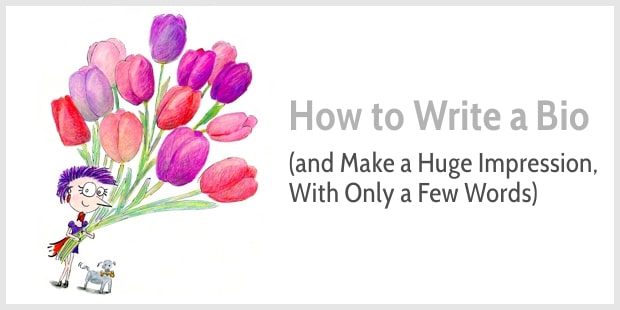
Even if you don’t need a short bio right now, writing one is a great exercise. You learn how to say more with fewer words. You learn how to position yourself and how to make a big impression from the get go.
But last week, when I started preparing this post, I made a big mistake.
I looked for inspiration on Twitter.
I scrolled through hundreds of Twitter bios, and I almost gave up on this post because most Twitter bios are utterly dull. And they say almost nothing, like this:
If you try to explain a lot about yourself in a few words, you end up saying nothing. No personality. No big impression. No sense of connection. You sound the same as everyone else.
So, I decided to look for inspiration elsewhere. How do fiction writers introduce their characters in a few words?
4 examples of saying a lot with a few words
I skimmed through the books I’ve read recently to look for powerful descriptions of people.
For instance, here’s how William Kent Krueger typifies an FBI agent in “Boundary Waters:”
How powerful is that comparison to a pit bull! In only 11 words, Krueger gives us a picture of an aggressive guy who’s persistent, too.
It made me wonder, if I were a dog, what dog would I be?
Here’s a longer example by the same author, from “Iron Lake:”
Why is this description powerful? Because the author focuses on one aspect of the person and he gives specific examples. The description is visual, so we can picture this guy sparking fires, tying knots and shooting arrows.
The description may be a little long, but you can cut it easily by 50% and still make a strong first impression.
Here’s a shorter character description from “Force of Nature” by Jane Harper:
Three specific details (jogging, yoga, deep-conditioning her hair) help us visualize Breanne, and we can imagine how she glows even in the unflattering office light.
And here’s one last example, from “The Keeper of Lost Things” by Ruth Hogan:
Again, three specific details express a lot: Prozac, Pinot Grigio, and pretending things weren’t happening. The words even alliterate for extra flair.
When you focus on one character trait or skill, you make a strong first impression and you invite readers to learn more. In contrast, if you try to say too much too quickly, a description of a person falls flat and nobody gets a feel of who they really are.
Choose what to tell in your professional bio
Of course, the fiction examples above are different—you wouldn’t write about Prozac in a professional bio.
But the principles of what makes a good bio remain the same. Choose what to tell and, even more importantly, what to leave out. You can’t cram your whole resume into one sentence. You have to be ruthless.
Twitter bios, for instance, are so short, you can only communicate one or two things. That’s it.
The Twitter bio of Unbounce’s Twitter bio explains what their software can do for you plus invites you to try it for free:
Casa Collective’ s bio is similar:
If you Tweet as a person rather than a company, I like bios that show personality, like this one from Haemin Sunim :
Or this bio from John Espirian :
Or this bio from Kitty Kilian is one of my favorites (the original is in Dutch, I’ve translated it):
A Twitter bio is super short, and you can only make a strong impression if you choose carefully what to write.
The 3-step professional bio
If you have three sentences, for instance for an author bio, then you can say a little more. But be careful, the same rule applies as with the one-sentence Twitter bio. Keep it short to make a strong first impression.
For a three-sentence bio, consider these three objectives:
- Tell readers who you are and what you do
- Reveal a glimpse of your personality
- Encourage readers to find out more
For instance, my author bio is:
In three sentences, I explain what I do (writing), what I’m passionate about (stamping out gobbledygook), and I invite you to join my course so you can learn how to write more persuasively.
Jessica Blanchard’s bio follows a similar pattern:
And Ry Schwartz’ bio:
Ry’s call to action isn’t very strong, but “More reclusive than J D Salinger on a rainy day” is a superb way to sketch a personality in a few words.
How to write a short professional bio
Want to make a big impression with only a few words?
Communicate less instead of more:
- Start with answering the question “What do you do for your clients?” or even better, finish this sentence suggestion from Mark Schaefer : “Only I …”
- Think about an adjective describing you well; Ry Schwartz uses “reclusive,” John Espirian uses “relentlessly helpful” and I use “irreverent” to present a quick glimpse of who we are
- Consider a metaphor to communicate more with fewer words, such as the “pit bull” or “delicate as a hand grenade”
- If you have space, have a clear call to action
In short, communicate what makes you different, and tell clients what you can do for them.
Because a professional bio is not only about you.
It’s about your clients, too.
Books mentioned in this post:
Recommended reading on writing about yourself:
Enjoyed this get my fortnightly newsletter in your inbox > > >, get my best writing tips in your inbox ....
Success! Now check your email to confirm your subscription.
There was an error submitting your subscription. Please try again.
Reader Interactions
Leave a comment and join the conversation cancel reply.
October 31, 2022 at 6:47 am
I love the way you gave perspective from books you read. Very relative and helpful. You keep giving me hope. Thanks.
October 31, 2022 at 11:56 am
Thank you, Andrea. Happy writing!
April 12, 2022 at 4:47 pm
Thank you! You helped me make mince-meat out of a project I always dread – writing about myself. I did a quick search for “how-to write a short bio” and found my favorite writing coach.
April 12, 2022 at 4:52 pm
Wow. So, great when Google delivers exactly what you need 🙂
And thank you also for your lovely compliment, Amy.
April 28, 2021 at 6:50 am
Yet another comment, after reading close to a couple of your blogs. l was asked for a CV today.
Definitely l had to make a search. These days whether its something about writing or not, l first input the search topic with Enchanting marketing.
Sometimes , l don’t really get anything but when l do like today, l get so thrilled like a 5 yr old with a favourite toy.
Let me stop gaping at your writing talent and get on with this CV. Thank you & Cheers Henneke.
April 28, 2021 at 3:14 pm
Thank you so much for your lovely comment, Emily. I’m happy to read that Enchanting Marketing has become your #1 source for writing advice. Good luck with your CV!
April 18, 2021 at 2:34 am
I just landed a new job and it asked or a bio. Google search presented me this page. What an inspiration… I am awestruck with all the wisdom in such a simple article, yet as mentioned in several of the conversations below, writing something in a couple of sentences is far from easy. I admire your patience in responding to every individual comments. I have to get to work in crafting something, which is creative and succinct.
April 18, 2021 at 2:40 pm
I’d say clarity is more important for a bio than being creative. Being creative is a bonus but not a requirement. Have fun!
September 17, 2020 at 4:17 pm
Thanks so kindly, Henneke. This is quite helpful. How does this sound? …a necessity entrepreneur, an avid supporter of women entrepreneurs, helping small business owners fall in love with their business.
September 17, 2020 at 6:38 pm
I don’t know what a necessity entrepreneur is. But maybe your potential clients know what it means? That’s more important than that I understand it.
Also, it’s unclear whether you help women entrepreneurs or all small business owners. Better to focus on one option instead of risking confusion.
May 23, 2020 at 2:17 pm
If you are guest posting, and the host allows for a much larger word count, do you include more information about yourself? Or do you include more about your results? Or maybe 50/50? Or do you keep with the short version and resist the temptation to change it any? I’ve revisited all mine and realize how many I’ve written, each one different. I did not even notice until now, so thanks for that! Also, I totally missed this post when it first came out and I love the tulips! 🙂
May 25, 2020 at 5:54 pm
I’m glad you enjoyed the tulips!
The bio I used for guest posts is the one I’ve quoted above—it’s relatively short: Henneke Duistermaat is an irreverent writer on a mission to stamp out gobbledygook. Get your free 16-Part Snackable Writing Course for Busy People and learn how to enchant your readers and win more business.
Even if the host allowed a longer word count, I haven’t made the bio longer because I was always afraid people might lose interest. Also, they’ve already read a whole blog post so I’ve already built up some credibility with the advice shared in the blog post. But this is not something I’ve tested. It’s mainly based on gut feeling.
May 26, 2020 at 2:20 pm
Thanks! I think you’re right!
January 24, 2020 at 7:46 am
Am still kind of confused but am sure I will get the hang of it. And thanks a lot.
January 24, 2020 at 10:54 am
What are you confused about?
January 9, 2020 at 1:28 am
Wow! I stumbled upon this article and you have successfully provided the unique kind of ideas I was looking for : ) Thank you Henneke
January 9, 2020 at 7:17 pm
Great 🙂 That makes me happy. Have fun writing your bio!
November 29, 2019 at 5:40 am
Oh my goodness! marvellous bio! Thanks.
Thank you so much, Henneke.
November 29, 2019 at 10:02 am
Thank you, Abhinav. Happy writing!
November 12, 2019 at 3:01 pm
You play a dangerous game when you automatically assume the author who used the pit bull reference intended to self describe as aggressive. Pit bulls are smart, loyal, and most of all affectionate. People like you spread bullshit and add fuel to the stereotype of pit bulls being aggressive. I highly suggest you educate yourself before making a blanket statement about an entire breed of animal. Do better.
November 13, 2019 at 12:24 pm
The example you refer to is from the book Boundary Waters, a thriller, in which the author describes one of the characters as a pit bull. He’s an FBI agent who comes as aggressive in the remainder of the book—a fighter.
April 2, 2019 at 8:06 pm
Hey, Henneke
Really amazing content. You’re right a bio define a person and about their profession. So, it’s really important to write an awesome bio.
I will surely use your tips to write a bio of my social media accounts.
March 11, 2019 at 4:15 am
Marketer ExtraOrdinaire, like a stick of dynamite, I blow up old ways of doing things, bringing fresh ideas. The pink bunny can’t keep up with me.
September 13, 2018 at 2:21 pm
Indeed, First impression last. Making an impressive bio needs to convey both professional status and personality in just one or two sentences which creates a great impact to the clients. I sometimes say or write too much and with no idea where I was going or how to make the points I wanted to make. It felt like I was writing in circles, as a result, I was saying nothing. Now I know what to do. Great tips, Henneke.
September 16, 2018 at 1:10 pm
I sometimes write in circles, too, as I don’t always know exactly what I want to say. The writing (even when it seems to lack purpose at first) somehow brings clarity.
Thank you for stopping by to leave a comment, Rebecca 🙂
September 4, 2018 at 11:12 am
September 4, 2018 at 11:33 am
My pleasure 🙂
September 1, 2018 at 10:08 am
I like this. Always playing around with my Short bio for social platforms. What do you think of my twitter bio? @davidgcant Could be improved? Give it your best shot..
A risk savvy health and safety consultant extraordinaire. Cuts through the red tape (with a safety blade of course).
September 2, 2018 at 10:09 am
I like it! I’d be tempted to shorten it a little: A health and safety consultant who cuts through the red tape (with a safety blade of course).
(To me the phrase “risk savvy” doesn’t add a lot as it feels kind of obvious that a health and safety consultant would be risk savvy; that’s what the job is about.)
September 2, 2018 at 4:04 pm
That reads much better. I was thinking of replacing risk savvy with refreshingly practical. What do you think? Or is that too much?
September 2, 2018 at 7:06 pm
The idea of cutting through the red tape already indicates that you’re a practical person rather than a rigid you-must-follow-the-health-and-safety-bible type of person. So, I’d say adding “refreshingly practical” doesn’t really add anything new as you’re already telling me you’re practical—you understand client’s objections to health and safety, plus you have a sense of humor.
August 30, 2018 at 11:44 pm
Succinct and thereby excellent, Henneke. Have to say that I’ve read words of many copywriters down through the years – some good, some not so, even if near-legendary. In my view your writing surpasses most. Please keep it up because I’ve learned more from your posts than I have from anyone else’s. Thanks.
August 31, 2018 at 6:27 pm
Thank you for your lovely compliment, Paul. I appreciate it! 🙂
August 25, 2018 at 5:37 am
Helpful post, as always, but I really just wanted to say I love that drawing of Henrietta with the tulips, on a grey cold day like this it warms the brain. Not that I can complain about the greyness, NSW where I live is 100% in drought. I hope the clouds are not just teasing. Best wishes.
August 26, 2018 at 6:09 pm
Thank you for your lovely compliment on my drawing, Susan. That means a lot to me! I hope the rain will soon ease the drought.
August 22, 2018 at 11:16 pm
Hi Henneke, Thank you for a great article. I remember when I first came across your website (last year, I think), I was impressed with your bio and made a note to myself to use that as inspiration for mine. Of course that mental note was long forgotten! This time I’ve already made a first attempt for my social media profiles. I’ve been a longtime lurker, this is my first comment and is well overdue. Thank you, I can hands down say I learn and apply something useful from each of your articles.
August 23, 2018 at 9:27 pm
That is a lovely compliment. Thank you so much, Sonna.
My own default position is also as a lurker. I appreciate you stepped out of the shadows to leave a comment. Have fun with writing your bio! 🙂
August 22, 2018 at 5:19 pm
Insightful and incisive Love the bonus recommended reading 😉
August 22, 2018 at 5:59 pm
Thank you, Hendel. I started adding the bonus reading recommendations recently as I was asked so often 😉
August 22, 2018 at 9:54 pm
Henneke: Few weeks back, I came across your blog and book.. I not only like the content and but also the presentation style… I really enjoyed reading this article and response to the many comments. I drafted by first short Bio.. could you please review.
Chandra is a Meditation teacher who conducts group meditation sessions in-person and on-line. Her Smile and her energy is contagious. Her mission is to encourage many human beings e discover their SacredSpace with in them through powerful meditations. To know more about her journey visiti https://cvelpula.wixsite.com/mysite/blog/journey-of-discover-sacredspace-within-you
August 23, 2018 at 9:05 pm
I’m glad you enjoyed this blog post, Chandra.
Great start on your bio! You may want to consider tightening it a little as you use the phrase “meditation” three times which is usually a sign that you can make it more concise. Also, what is the ultimate aim of your clients? Do they want to discover their SacredSpace or is their a deeper purpose? This depends on who you’re targeting.
August 22, 2018 at 4:07 pm
Henneke, this was very helpful. I always have trouble writing shorter than longer. Thanks.
August 22, 2018 at 4:19 pm
I find it hard, too. And it takes more time than writing longer!
Thank you for stopping by, Anita. It’s always good to see you 🙂
August 22, 2018 at 11:38 am
Now this is powerful stuff Henneke and thanks to Lisa for sharing.
My bio is not more than 2 sentences but this post just gives me a lot of meat.
I hope you are having a great week
August 22, 2018 at 1:46 pm
I’m glad you found it useful, Enstine! Thank you for stopping by.
August 22, 2018 at 11:12 am
Hi Henneke – I hadn’t thought about writing my bio until I read your article. I’ll certainly follow your excellent advice when the time comes. All the best from sunny Sydney
I hope you’ll have fun writing your bio, Paul!
Still cloudy here 🙂
August 22, 2018 at 1:43 am
Ooh! Henneke, I love this post. And who is Henrietta’s new friend? (or did I miss a post?) I love these smart, smooth, silky, bio’s and would love to add my own. I dream♡ This is my first attempt. Your comments would be sooooo valued. Thanks for all your gorgeous posts Henneke.
Like Columbo shelling his morning egg Joan reveals you to yourself; then helps you delete what no longer serves you and install what does. Joan is an NLP Master Practitioner and Professional Coach working with coaches and service professionals. …… this would be followed with a short CTA
August 22, 2018 at 1:43 pm
Henrietta’s puppy is called Arthur. He’s been around for ages, but often I’m too lazy to draw him! 🙂
You can probably take one step further with your bio, by defining the real benefit of what you do. You can find the real benefit by finishing the sentence: she helps you delete what no longer serves you and install what does, so ….. What is it your clients really want to achieve?
August 23, 2018 at 2:20 am
Thanks, Henneke, that helps. I did add that initially but thought it made it too long – I wrote – “so that you can make a difference and make money as you grow your Lifestyle-Biz.”
I’ll keep playing with it. Now I’m thinking the Columbo piece sounds a bit ‘cheesy’.
August 23, 2018 at 9:33 pm
I’m not sure the Columbo reference adds a lot. I do like the phrase “reveal you to yourself.” I also like “make money as you grow your Lifestyle-Biz” as it’s a true benefit and it’s also specific to your audience. “Making a difference” is a little abstract. So, I’d be tempted to leave that out, or to make it more specific (but that might make it even longer).
August 23, 2018 at 11:26 pm
Terrific, just leave that Columbo piece out. I’ll play with the rest of it. Thanks for the extra input Henneke. ♡
August 21, 2018 at 11:28 pm
The short takes are never easy. How to sum up Hetty in 3 sentenceso ha! So…. Easy going until taken for granted. Lover of stationery, determined to be a success in business. Express your thoughts in our Ankara Fabric Covered Notebooks
August 22, 2018 at 1:41 pm
Great start on your bio, Hetty. It makes me wonder what’s special about your notebooks and why are you passionate about them?
August 21, 2018 at 6:14 pm
Brilliant and enchanting as usual! Thanks for confirming how difficult it can be to engagingly summarize one’s life in two sentences. I get to put a short bio on most of the articles I write for magazines and I am so disappointed in the various versions I have come up with over the years. Now I see why, I conveniently left out my real personality. Shoot.
August 21, 2018 at 8:58 pm
Don’t beat yourself up over it, Thea. Most people leave their personality out of their bios. It IS a tough challenge.
Thank you for your lovely comment. I appreciate it! 🙂
August 21, 2018 at 5:33 pm
To be honest, I skimmed your initial email the first time and, because my day is the usual crazy, didn’t click through initially. But I’m so glad I made the time to do it now. This was an absolutely genius post—and the examples were outstanding! I’ve added a note to do some brainstorming on my bio next week. As always, thank you for the inspiration and the easily digestible and actionable advice!
August 21, 2018 at 8:56 pm
You know, it really humbles me when you make time on a crazy busy day to not only read my post but also leave a comment. You’re a star. Thank you 🙂
August 21, 2018 at 4:41 pm
Thank you for the valuable insights.
August 21, 2018 at 4:47 pm
Thank you, Mohsin. Was there anything in particular you found valuable?
August 21, 2018 at 3:43 pm
Hi Henneke:
For me the fight to find the perfect bio is unending…seems like I’m forever tweaking. Also, in my constant state of evolving (or is it experimenting?) I’ve taken to changing my bio for different places I publish! Oh Henneke, why can’t I just do one perfect one like you and it’s everywhere!!! Geez. P.S. But, don’t forget you need to add “illustrator” to yours!!! Bi Oh My!! Take care, Sue-Ann
August 21, 2018 at 4:43 pm
I don’t have one perfect bio either. I don’t think the perfect bio exist. Unless you’re Andy Murray whose Twitter bio simply says: “I play tennis.” How brilliant is that? Unfortunately, that doesn’t work for mere mortals like you and me.
And you see … you already mention “illustrator,” but somehow it didn’t feel right. Also, I have a different bio on Instagram because I mainly share my drawings there. My Insta bio is: I play with words and colored pencils.
Perfection doesn’t exist. Experimentation is what life is about, isn’t it?
August 22, 2018 at 8:34 am
Ha ha! I always laugh at Murray’s twitter bio as it’s so deceptively simple yet at the same time understated. I like how he doesn’t feel the need to list out all his achievements. By the way, I missed my flight home from NYC in 2012 to see him win the US Open, which was amazing.
Anyway, back on topic, trying to do a short About section for my new “personal branding photography” landing page. Trying to work in something like my “hobbit-like stature and tenacity”, along with being eco-friendly and helping businesses save time by creating images for their online content. It’s still a work in progress.
August 22, 2018 at 1:45 pm
Murray’s bio is brilliant. I love how understated it is. And lucky you for seeing him play (and win!) live!
I like “hobbit-like tenacity” 🙂
August 21, 2018 at 3:02 pm
Thanks, Henneke. I’m honoured to get a mention here – much appreciated!
I hate it when all those letters, spaces and punctuation marks don’t amount to anything meaningful.
August 21, 2018 at 4:51 pm
It was rather demotivating to read through all those Twitter bios!
Thank you for stopping by, John.
August 21, 2018 at 2:33 pm
Great post and I loved the examples you gave.
I find writing bios very hard. I have this instinct to look at what others in my field are writing and try to find something that would work for me. It’s insane! I know it’s wrong, I know it’s useless and yet, I’m attracted to it.
What’s with the copycatting? I have a strong identity, I know what I want and who I am. Why does it all go to smoke when writing things like bios on social media?
I’m going to get to work in a dark room with no phones or internet and write away. Well, scratch the dark room part. You know what I mean. 😀
August 21, 2018 at 4:38 pm
I think most of us look at what others in our niche are doing, and there’s nothing wrong with trying to learn from others. I’ve found it’s often easier to look outside our own niche for inspiration.
And out of all the different writing tasks, writing a bio is probably one of the most difficult. Play for a while, then let it simmer for a while, and then play a little more. Have fun!
Thank you for stopping by, Elfin!
August 21, 2018 at 2:16 pm
You’re inspired me! Awesome post – and glad you said it took weeks to come up with your bio. These examples make it look easy.
August 21, 2018 at 4:36 pm
Writing so often looks easy, but we don’t see how much effort has gone into it. For me, the biggest challenge was to decide what I wanted to say. I was just starting out and I hadn’t figured out my positioning yet.
Thank you for stopping by, Cathy. I appreciate it 🙂
August 21, 2018 at 2:08 pm
Great advice Henneke! I took notes and will check out some of your examples!
August 21, 2018 at 4:34 pm
Yay! Happy bio writing, Kim 🙂
August 21, 2018 at 1:59 pm
Hi Henneke,
Thank you for this post. It came just in time as I am currently trying to re-do my website about page and social profiles.
Here’s what I came up with after reading your post. What do you think? Storytelling is my superpower, so I thought to highlight that. So how’s this for a try:
Enamored with writing. I spin engaging stories about your brand so your clients don’t have to shop elsewhere. Just call me your Fairy Wordmother.
August 21, 2018 at 4:45 pm
I’m glad this post came at the right time, Zika 🙂
Using a positive is often stronger rather than a negative. So, for instance, instead of “so your clients don’t have to shop elsewhere,” you could have: “so your clients fall in love with your brand.”
August 21, 2018 at 4:57 pm
Thank you so so much, Henneke.
August 21, 2018 at 1:38 pm
I read your post not for my own bio actually but because I need help writing one and two sentence introductions for 40 – 50 historical puzzle pages. And it works for that! Where yesterday I was plodding through it like an elephant in quick sand this morning I’m inspired to have more fun with my project. Especially love the suggestion to use metaphors. That would make a whole blog on its own. Maybe you already have?
August 21, 2018 at 4:33 pm
Yay! I’m so glad you feel inspired, Patty 🙂
I wrote about metaphors here and here . But I could probably write another one 🙂
August 21, 2018 at 1:37 pm
Brilliant and not boring bios. That draw you in.
Excellent article Henneke.
August 21, 2018 at 4:31 pm
Thank you, Ray. I appreciate your comment 🙂
August 21, 2018 at 1:26 pm
I’ve rewritten my Twitter bio using this post as inspiration! It originally said;
#Blogger & #copywriter for #software & #tech (esp #IoT). Loves #design, productivity & mindfulness. Newcastle upon Tyne. Ravenclaw. INTP. Chocoholic.
I was clearly so very guilty of trying to say as much as possible in a short space of time. Now it says this;
Chocoholic copywriter LJ enjoys making tech sound fun, not scary. She’s also as subtle as a sledgehammer and wants to help startups build brilliant blogs. Start here; http://eepurl.com/cS8g99
My dad is the one who describes me as being as subtle as a sledgehammer 😉
I love the changes you’ve made! 🙂
I wonder whether you can connect “subtle as a sledgehammer” somehow to building blogs. Something like: Subtle as a sledgehammer, she helps startups build blogs that rip through online noise. Maybe not quite, but it’d be great if you could show the advantage of being like a sledgehammer 🙂
What do you think?
August 21, 2018 at 1:23 pm
One of your best Henneke!
I’ve long felt the same about “elevator speeches” — the reason they don’t work is we try to jam too much information into what should be a single thought-provoking nugget.
August 21, 2018 at 4:27 pm
Yep, I agree with you. The idea of elevator speeches makes me roll my eyes. But that’s silly because a good elevator speech is fab. As you say, you need just one thought-provoking nugget, something to connect with your audience.
August 21, 2018 at 1:16 pm
Great tips and examples Henneke!! It’s awesome to see examples that are different from the norm. Love the visuals.
You’ve inspired me to improve my byline. What do you reckon?
Cynthia is a copywriter powered by chai lattes, rockclimbing, and remedial massages. She’s on a mission to draw out personable, reputable, small health and fitness businesses from the shadows. Grab her free guide on how to sound intelligent by writing in plain English.
August 21, 2018 at 4:25 pm
I like it. You can probably still improve the second sentence a little more. Try to find a stronger phrase than “draw out from the shadows”—something that sounds more positive, and reduce the number of adjectives as “personable, reputable, small health and fitness businesses” is quite a mouthful.
I love the idea of a free guide on sounding more intelligent 🙂
September 11, 2018 at 5:38 am
Thanks for the feedback. I find it tough to keep it simple sometimes! 🙂
How about this version? Cynthia is a copywriter powered by chai lattes, rockclimbing, and remedial massages. She’s on a mission to help small health and fitness businesses connect with clients through writing that sticks in their reader’s minds. Grab her free guide on how to sound intelligent by writing in plain English.
September 12, 2018 at 2:09 pm
Yes, I like it. If you like, you can consider making your mission more specific to your audience. For instance: help small health and fitness businesses inspire their clients to lead a more healthy lifestyle.
August 22, 2018 at 1:53 am
I like it! And Henneke’s suggestions.
August 21, 2018 at 12:27 pm
Hi Henneke, Another great of your posts here. The goal of every writer is to have their target audience read through to the last word. That said, it is genius to be artistic if a writer has to stand out of the crowd. This is where you have touched best ~ Use of a BIO ~ and a captivating bio for that matter. Most of the time readers will look at the bio of an author before they could dedicate their time to read the author’s article. You nailed it as always. I always read your articles to enrich my knowledge Keep doing what you do BEST 🙂
August 21, 2018 at 12:43 pm
Thank you for your lovely comment, Tony. A dash of creativity can definitely make a bio more captivating.
August 21, 2018 at 12:23 pm
‘More reclusive than J D Salinger on a rainy day,’ >> yes! Jealous of that.
And thanks for including me 😉 Interesting that the second sentence translates from 6 words in Dutch to 11 in English – usually it’s the other way round.
August 21, 2018 at 12:42 pm
Yes, I found it also weird that I ended up with more words. I somehow couldn’t make it shorter and it doesn’t feel as good as the Dutch version (probably because that one is shorter).
I love “delicate as a hand grenade,” too! 🙂
August 21, 2018 at 12:18 pm
Henneke, I love this one: “Because a professional bio is not only about you. It’s about your clients, too.” We have to think more like our own client to help us create a catchy bio that will work and answer “what’s in it for me?” Thanks for the info and the great examples here Henneke. I’ll be playing around with mine in the coming days.
August 21, 2018 at 12:40 pm
“Playing around” is a good phrase for writing a bio!
I can’t remember how long I played around with mine, but it was weeks rather than days (and writing this post makes me wonder whether I have to revisit my Twitter bio again!).
Happy playing, Lisa, and thank you for stopping by.
August 22, 2018 at 10:48 am
Oh yes, I try to update my Twitter bio every month or so. Things change, you know? You are most welcome. Love your mugs by the way as I’ve seen them via Sue-Ann.

Books and courses
Follow proven templates for specific writing tasks, practice your skills, and get professional feedback so you become a confident business writer. Take on any writing project with gusto. Learn more about books and courses

About Henneke
I never saw myself as a writer, but in my early forties, I learned how to write and discovered the joy of writing. Now, I’d like to empower you to find your voice, share your ideas and inspire your audience. Learn how I can help you
Popular topics
Sales copywriting
Blog writing for business
Your writing voice
Tips for beginning writers
The writing process
Improve your writing skills
Writing examples
Popular blog posts
Recent blog posts
Free Snackable Writing Course
Get 16 concise emails and learn how to write more persuasive content.
27 of the Best Professional Bio Examples I've Ever Seen [+ Templates]
Updated: December 20, 2023
Published: June 07, 2016
As a writer, I have to let readers and potential clients know my expertise, my skills, and why they should work with me or be interested in what I say. So, a professional bio is a must in my industry.

Though I'm definitely familiar with professional bios, I can admit they can be challenging. What do I include? What do readers need to know?
As daunting as writing a professional bio can be, professional bios are crucial when applying for jobs, seeking new clients, or networking. A professional bio also gives the world a brief snapshot of you and your professional ideals.
If you‘re at a loss for how to write a professional bio that packs a punch, I’ve got you covered. In this journey, tools like HubSpot’s user-friendly drag-and-drop website builder can be instrumental in showcasing your professional bio online with ease and style.
I will walk you through how to write a professional bio that you can proudly publish, provide professional bio templates, and show you the best professional bio examples you can get inspiration from.
![biography one sentence → Download Now: 80 Professional Bio Examples [Free Templates]](https://no-cache.hubspot.com/cta/default/53/4eb63650-d315-42e5-9ac7-8d0fcba29324.png)
What is a professional bio?
Professional bio templates, how to write a professional bio, best professional bio examples, how to write a short bio.
.webp)
80+ Professional Bio Templates & Examples
Create a compelling professional narrative for a proper, attention-grabbing introduction.
- LinkedIn Summaries
- Speaker Intros
- Website Bios
- Professional Profile
Download Free
All fields are required.
You're all set!
Click this link to access this resource at any time.
Tell us a little about yourself below to gain access today:
A professional bio or biography is a short overview of your experience. Professional bios usually include details about education, employment, achievements, and relevant skills.
Purpose of Professional Bios
A bio tells an audience about who you are, what you've done, and what you can do. It can help potential employers, fans, or customers understand your personality and what you stand for.
Writing a bio without a clear starting point is challenging — believe me, I've tried. To ease the process, here are some templates I put together to get you started.
I‘ve found it’s best to keep your professional bio honest and to the point. Too long of a bio, and you risk losing your audience's attention. After all, audiences will only read a web page for less than a minute before clicking elsewhere.
And honesty is key because most consumers and clients won‘t invest in someone or something if it doesn’t seem trustworthy. In fact, 67% of consumers say they must trust a brand before investing in its products or services.
Download free, editable short and long professional bio templates.
What should a professional bio say?
No one wants to work with a clone — your professional bio should be as unique as you.
When writing your bio, include important professional roles and achievements. Add your passions, interests, and how you bring your values to your work. Finally, your bio should let readers know you and reflect your personality.
Here are the elements I recommend including when writing a professional bio:
Professional Roles and Achievements
It's essential to highlight your career roles and achievements in your bio. This can include your current position, previous roles, and notable accomplishments. It will help establish your expertise and credibility and start your bio on the right note.
Passions and Interests
This might be less essential, but it will help humanize you. Remember: Bios are shared via an impersonal medium, like a screen, and can sometimes feel distant if we don't take the proper steps.
Share your passions and interests, whether or not they relate to your work or industry. That way, you can show enthusiasm and dedication outside your professional life.
Plus, you could find common ground with readers — which is always beneficial.
Take a look at this short bio by HubSpot staff writer Erica Santiago.
"Plus," she adds, "I'm always happy to talk about my cats at any given moment. You never know when a fellow cat mom could be reading."

Values and Work Approach
Your values can sometimes show your work ethic more effectively than your career path. It can also help you endear yourself to employers and colleagues who want to work with people with similar values.
So don‘t be shy: Share how you incorporate your values into your work. Whether it’s a commitment to innovation, customer satisfaction, or ethical decision-making, explain what drives you and be enthusiastic about it.
Your Personality
Remember: Your bio should always include a taste of your personality! Your sense of humor, creativity, or collaborative nature could all give readers a sense of who you are. This helps readers connect with you on a more personal level.
Remember to tailor your bio for different platforms and audiences. Also, keep it concise and impactful while highlighting the most relevant information in each context.
First-Person Bio vs. Third-Person Bio
While first-person bios are common, third-person bios can be more effective in formal situations.
Your decision to write your professional bio in the first or third person depends on your desire to leave a more personable or assertive impression.
Both approaches work, provided you tailor them to your goals and audience. What’s important is to be clear and tell your story in a way that connects with your reader.
How to Write a First-Person Bio
Writing in the first person can be a great way to connect with your audience when building a personal brand. When you write a first-person bio, use "I" or "me" to make yourself relatable and approachable.
Here's one way I’d write a first-person bio:
"I'm a freelance writer specializing in small business content. I've worked with companies in a variety of industries like home care to fine leather goods."
Speaking in the first person here connects you with a client or brand based on your experience and opinions. Put another way, writing a first-person bio is like telling your story to your audience.
Here are a few tips to make your first-person bio great:
Don’t start every sentence with "I."
Showing instead of telling is a great approach.
Let’s say you’re a writer who wants to create a short professional bio. Instead of saying, "I love to write," you can say, "Writer. Bad but enthusiastic dancer."
This portrays your writing skill, shows your personality outside of writing as a dancer, and includes a little sense of humor, which is essential for a writer.
Remember, you know yourself better than anyone.
Adding a back story to your bio helps create context for the roles and successes you write about. Think of it like a case study about who you were, what you are now, and the process that got you to your current position.
Focus on valuable details.
Quick facts about you can showcase your identity and values. For example, if you're writing a bio for LinkedIn, think about how to tie your hobby into what you do.
Let's say Animal Crossing is your hobby. Does it align with your career aspirations? It can be a great addition to your bio if you want to pursue a video game career.
However, if your interests lie elsewhere, including a more relevant hobby is better.
How to Write a Third-Person Bio
Third-person bios sound more authoritative and objective. So, if you’re job searching in a formal industry, applying for grants, or trying to get published, you may want to stick to the third person.
For instance, when you write a third-person bio, you may start with:
"Jasmine Montgomery is a Senior Hiring Manager at L’Oreal based in New York. She recruits across several business units to connect with the brightest talent from around the globe."
By only using your name and pronouns to speak about yourself here, you are letting your title and skill set speak for themselves.
These bios create distance between the subject of the bio (you) and the reader through a third person. This person could be anyone, but they usually speak in a tone emphasizing their expertise.
This makes third-person bios feel aloof or overly formal sometimes.
Ideally, your third-person bio should sound friendly but polished, like a message from a close colleague at work. Here are a few tips on how to write a great third-person bio.
Write from the perspective of someone you know and trust.
It can be challenging to write about yourself, so try to see yourself from the perspective of your favorite person at work or a mentor you trust. This can help you write from a position of authority without feeling self-conscious.
Show the reader why they should trust your opinion.
A professional bio often reflects a specific industry or niche. With this in mind, your text should include relevant details that professionals in your industry know. Avoid jargon whenever you can.
Remember, you're telling a story.
If you want a third-person bio, but you're used to writing in first-person, it may help to write it the most comfortable way for you.
Your professional bio is an essential piece of writing, so edit it carefully. Edit your writing from both points of view and see which works best for your target audience.
Here's how to write a professional bio, step by step.
- Create an 'About' page for your website or profile.
- Begin writing your bio with your first and last name.
- Mention any associated brand name you might use.
- State your current position and what you do.
- Include at least one professional accomplishment.
- Describe your values and how they inform your career.
- Briefly tell your readers who you are outside of work.
- Use humor or a personal story to add flavor to your professional bio.
If you’re anything like me, you probably don't think about your professional bio until you’re asked to "send one over via email."
You have one afternoon to come up with it, so you scramble together a bio that ends up reading like this:
"Rodney Erickson is a content marketing professional at HubSpot, a CRM platform that helps companies attract visitors, convert leads, and close customers.
Previously, Rodney worked as a marketing manager for a tech software startup. He graduated with honors from Columbia University with a dual degree in Business Administration and Creative Writing."
To be fair, in certain contexts, your professional bio needs to be more formal, like Mr. Erickson's up there. But there are also cases where writing a personable and conversational bio is good.
Whether you choose the formal or casual route, use the following steps to create a perfect bio.
1. Create an 'About' page for your website or profile.
You need an online space to keep your professional bio. Here are a few to consider (some of these you might already have in place):
- Facebook Business page .
- Industry blog byline .
- Instagram account .
- Personal website .
- LinkedIn profile .
- Industry website .
- Personal blog .
As you'll see in the professional bio examples below, the length and tone of your bio will differ depending on the platforms you use.
Instagram, for example, allows only 150 characters of bio space, whereas you can write as much as you want on your website or Facebook Business page.
2. Begin writing your bio with your first and last name.
If your readers remember nothing else about your bio, they should remember your name. Therefore, it's a good idea for your first and last name to be the first two words of your professional bio.
Even if your name is printed above this bio (hint: it should), this is a rare moment where it's okay to be redundant.
For example, if I were writing my bio, I might start it like this:
Lindsay Kolowich
Lindsay Kolowich is a Senior Marketing Manager at HubSpot.
3. Mention any associated brand name you might use.
Will your professional bio represent you or a business you work for? Ensure you mention the brand you associate with in your bio. If you're a freelancer, you may have a personal business name or pseudonym you advertise to your clients.
Here are a few examples:
- Lindsay Kolowich Marketing.
- SEO Lindsay.
- Kolowich Consulting.
- Content by Kolowich (what do you think ... too cheesy?).
Maybe you founded your own company and want its name to be separate from your real name. Keep it simple like this: "Lindsay Kolowich is the founder and CEO of Kolowich Consulting."
4. State your current position and what you do.
Whether you're the author of a novel or a mid-level specialist, use the following few lines of your bio to describe what you do in that position. Refrain from assuming your audience knows what your job title entails.
Make your primary responsibilities known so readers can know you and understand what you offer to your industry.
5. Include at least one professional accomplishment.
Just as a business touts its client successes through case studies, your professional bio should let your audience know what you've achieved.
What have you done for yourself — as well as for others — that makes you a valuable player in your industry?
6. Describe your values and how they inform your career.
Why do you do what you do? What might make your contribution to the market different from your colleagues? What are the values that make your business a worthwhile investment to others?
Create a professional bio that answers these questions.
7. Briefly tell your readers who you are outside of work.
Transition from describing your values in work to defining who you are outside of work. This may include:
- Your family.
- Your hometown.
- Sports you play.
- Hobbies and interests.
- Favorite music and travel destinations.
- Side hustles you're working on.
People like connecting with other people. The more transparent you are about who you are personally, the more likable you'll be to people reading about you.
8. Use humor or a personal story to add flavor to your professional bio.
End your professional bio on a good or, more specifically, a funny note. By leaving your audience with something quirky or unique, you can ensure they'll leave your website with a pleasant impression of you.
Following the steps above when writing your bio is important, but take your time with one section. People consume lots of information daily. So ensure your bio hooks 'em in the first line, and you won’t lose them.
(P.S. Want to boost your professional brand? Take one of HubSpot Academy's free certification courses . In just one weekend, you can add a line to your resume and bio that over 60,000 marketers covet.)
Why Good Bios Are Important for a Professional
You may think, "How many people read professional bios, anyway?"
The answer: A lot. Though there's no way to tell who is reading it, you want it catchy. Your professional bio will delight the right people coming across it on multiple platforms.
Professional bios can live on your LinkedIn profile , company website, guest posts, speaker profiles, Twitter bio , Instagram bio , and many other places.
And most importantly, it‘s the tool you can leverage most when you’re networking.
Bottom line? People will read your professional bio. Whether they remember it or it makes them care about you is a matter of how well you present yourself to your intended audience.
So, what does a top-notch professional bio look like? Let‘s review a few sample bios for professionals like you and me. Then, we’ll cover bio examples from some of the best people in the industry.
Short Sample Bios
Your bio doesn't have to be complicated. Here are five samples to glean inspiration from.
Example 1: Friendly Sample Bio
"Hey! My name is Ryan, and I'm a marketing specialist passionate about digital advertising. I have five years of experience managing various online campaigns and improving brand visibility for clients across multiple verticals. I love analyzing consumer behavior and leveraging data-driven strategies to maximize ROI. Outside work, I enjoy traveling, taking funny photos, and exploring new hiking trails."
Example 2: Mid-Career Sample Bio
"Jennifer Patel is a versatile graphic designer known for her creative approach and attention to detail. With a background in visual arts and eight years of experience, Jennifer has worked on diverse projects ranging from logo designs to website layouts. Her ability to understand and translate client needs into visually striking designs sets her apart. Jennifer finds inspiration in nature, music, and pop culture."
Example 3: Sales Sample Bio
"I'm a seasoned sales executive with a track record of exceeding targets and building strong client relationships. With a background in B2B sales, I've built a natural ability to understand customer needs and consistently exceed quota every month. I pride myself in my communication skills and strategic approaches, which have helped me thrive in highly competitive markets such as SaaS sales. Outside work, I enjoy playing basketball and volunteering at local charities."
Example 4: HR Sample Bio
"I am a dedicated human resources professional with a passion for fostering a positive workplace culture and facilitating employee development. With eight years of experience in talent acquisition and HR operations, I've played a key role in building high-performing teams. I'm known for my strong interpersonal skills and ability to create inclusive and supportive work environments. In my free time, I enjoy practicing yoga and exploring new culinary experiences."
Example 5: Software Engineer Sample Bio
"David Chang is a senior software engineer specializing in backend development. With a strong background in computer science and six years of experience, David has successfully built scalable and efficient solutions for complex technical challenges. He is well-versed in various programming languages and frameworks like C++, Java, and Ruby on Rails. In his spare time, David enjoys reading science fiction novels and playing the guitar."
Below, we've curated some of the best professional bio examples we've ever seen on Twitter, Instagram, Facebook, LinkedIn, and the various places you might describe yourself.
Check 'em out and use them as inspiration when crafting your own.
- Chimamanda Ngozi Adichie: Author
- Chima Mmeje: SEO Content Writer
- DJ Nexus: DJ
- Lena Axelsson: Marriage & Family Therapist
- Mark Levy: Branding Firm Founder
- Audra Simpson: Political Anthropologist
- Marie Mikhail: Professional Recruiter
- Wonbo Woo: Executive Producer
- Chris Burkard: Freelance Photographer
- Lisa Quine: Creative Consultant
- Nancy Twine: Hair Care Founder
- Trinity Mouzon: Wellness Brand Founder
- Alberto Perez: Co-Founder of Zumba Fitness
- Ann Handley: Writer and Marketer
1. Chimamanda Ngozi Adichie : Author
Bio platform: personal website.
Chimamanda Ngozi Adichie begins her professional bio with an invitation to her roots.
In a few paragraphs, she describes when and where she was born, her family, her education, her honorary degrees, and the depth of her work, which has been translated into 30 languages and several publications.
She can keep readers engaged by leading with a powerful hook that aligns with her target audience’s marketing needs.
- There’s clarity about who Chima serves.
- The hook is bold, catchy, and compels anyone to read further.
- Including client results makes clients visualize what they can expect.
3. DJ Nexus : DJ
Bio platform: facebook.
This New England-based DJ has single-handedly captured the Likes of over 2,000 people in and beyond Boston, MA. And even if you don‘t listen to the type of music he produces, it’s hard not to read his compelling Facebook bio.
For instance, consider his tagline, under "About" — " Quiet during the day. QUITE LOUD at night! " DJ Nexus tells you when he works awesomely. I got goosebumps just imagining a dance club where he might play music.
The second is the "long version," which is even more interesting than the first. Why? It reads like a story — a compelling one, at that. In fact, it gets hilarious in some parts.
The second sentence of the bio reads: "He was frightened of public school, loved playing baseball and football, ran home to watch ape films on the 4:30 Movie, listened to The Jam and The Buzzcocks, and read magic trick books."
Here's another excerpt from the middle:
It's a well-put value proposition that sets her apart from the rest of the HR industry.
Marie concludes her bio with a smooth mix of professional skills, like her Spanish fluency, and personal interests, such as podcasting and Star Wars (she mentions the latter with just the right amount of humor).
- Straight off the bat, Marie uses a story to share her experiences of how she began as a recruiter.
- It provides a subtle pitch for readers to check out her podcast.
- The bio exudes Maries approachable, fun, and playful personality.
8. Wonbo Woo : Executive Producer
Wonbo Woo is the executive producer of WIRED's video content and has several impressive credits to his name. What does this mean for his professional bio? He has to prioritize.
With this in mind, Wonbo opens his bio with the most eye-catching details first (if the image below is hard to read, click it to see the full copy ).
I wouldn‘t necessarily be inclined to follow Chris if his bio had simply read, "I post beautiful images." But images that inspire me to travel? Now that’s something I can get behind.
Last, he ends on a humble, sweet note: "He is happiest with his wife Breanne raising their two sons." So inject personal information into your bio — it makes you seem approachable.
- It highlights Chris’s achievement without bragging.
- The last sentence portrays Chris as a responsible man who loves his family.
- The well-written bio speaks to nature lovers who like the outdoors, surfing, and more. This gives them reasons to follow Chris.
10. Lisa Quine : Creative Consultant
Bio platform: portfolio website.
Creative professionals who specialize in visual art may find it challenging to balance the writing of their bio and displaying of their portfolio. Not Lisa Quine. Lisa has an exceptional balance of her professional bio and creative work.
Throughout her bio, you'll notice the number of murals she's completed and a brief timeline of her career. This helps her paint the picture of who she is as a professional.
The rest of her bio similarly focuses on Twine's strengths as someone who’s able to take hair care "back to basics."
Mouzon effectively grips the reader's attention with this introduction and then dives into some of her impressive accomplishments — including a brand now sold at Urban Outfitters and Target.
The language used throughout Mouzon's bio is authentic, real, and honest.
For instance, in the second paragraph, she admits:
"While building a brand may have looked effortless from the outside, starting a business at age 23 with no resources or funding quickly forced me to realize that early-stage entrepreneurship was anything but transparent."
As an avid Zumba fan, I was excited to include this one. Perez styles his LinkedIn bio as a short story, starting with his background as a hard-working teen who held three jobs by age 14.
His bio tells the fun and fascinating origin story of Zumba, in which Perez, an aerobics teacher in Florida at the time, forgot his music for class and used a Latin music cassette tape instead ... "And it was an instant hit!"
His bio continues:
"Shortly after he was connected to Alberto Periman and Alberto Aghion, and Zumba was officially created ... What started as a dream now has 15 million people in more than 200,000 locations in 186 countries who take Zumba classes every week."
There's something in there for everyone.
- The last section of the bio shows Ann’s warm personality — "Ann lives in Boston, where she is Mom to creatures two- and four-legged."
- Written in the third person, this bio has lots of proof (like followers), which shows Ann is a terrific marketing leader.
If you're posting a bio on a social media account or sending a quick blurb to a client, you want to keep it short and sweet while showcasing your accomplishments.
To get started, use these best practices for writing your short professional bio:
- Introduce yourself.
- State what you do.
- Add key skills or areas of expertise.
- Include a personal mission statement
- Celebrate your wins.
- Provide your contact information.
- Show them your personality.
1. Introduce yourself.
Your introduction is your first impression, so always begin by telling people who you are. You may start with a greeting like, "Hello, my name is" or "Hi! Let me first introduce myself …" when sending your bio as a message.
If you’re writing a bio for an online platform, stating your name at the beginning works as well.
Leading with your name — even as a question — is important for recognition and building relationships.
2. State what you do.
Give people an idea of what you do daily and where you work. Your job title is how the people put you into context and consider whether your profession relates to their industry.
So detail your most relevant work in your short bios, like CEO, professor, and author.
Take a cue from Angela Duckworth , who specifies what she does in her LinkedIn bio:
3. Add key skills or areas of expertise.
If you send a bio to a client or potential employer, highlight your most valuable skills. For instance, if your expertise is in social media marketing and content creation, like Ivanka Dekoning , list these skills.
- A joke. "Some mistakes are too much fun to only make once. At least that’s what I learned when I created…"
- Mention a hobby. "I’ll be honest: for me, tennis is life — Go Nadal!"
- A fun fact. "Every year, I watch 100 new films! I’m a cinephile and love every movie genre."
- A few emojis related to your interests. "🎶🤖🎾🎬🎭"
Whichever way you choose to get personal, give people a glimpse into who you are as an individual.
When writing a short bio, it can be tempting to pack in as much relevant information about yourself as possible — but this isn’t the most effective approach.
Instead, focus on including the details that you and your audience care about most and leave out the fluff.
Let's dive into a few examples of short professional bios.
Short Professional Bio Examples
- Tristen Taylor: Marketing Manager
- Lianna Patch: Copywriter
- Precious Oboidhe: Content Strategist and Writer
- Rebecca Bollwitt: Writer
- Megan Gilmore: Cookbook Author
- Bea Dixon: Feminine Care Founder
- Tammy Hembrow: Instagram Influencer
- Dr. Cody: Chiropractor
- Larry Kim: Founder
- Dharmesh Shah: Founder and CTO
- Lily Ugbaja: Content Strategist
- Ian Anderson Gray: Marketer
- Van Jones: Political Commentator, Author, and Lawyer
1. Tristen Taylor: Marketing Manager
Bio platform: blog byline.
Tristen Taylor is a Marketing Manager here at HubSpot. She's written content for HubSpot's Marketing, Sales, and Customer Service blogs; her blog author bio is one of my favorites.
What I love most about Tristen's bio is that it’s a great example of how to deliver information about yourself that is relevant to your work while also sharing fun details that audiences will find relatable.
Her bio reads:
"Building from her experience with GoCo.io and Southwest Airlines, Tristen's work has been recognized by Marketing Brew and BLACK@INBOUND. She lives in Washington, DC, attending anime conventions and painting in her free time."
Gilmore further includes a CTA link within her Instagram bio that leads followers to free, ready-to-use recipes. You might think, " Why would she do that since it discourages people from buying her book?"
But that couldn't be further from the truth.
By giving her followers the chance to try out her recipes, she's slowly turning leads into customers. After I tried a few of her Instagram recipes and loved them, I bought her book, knowing I'd like more of what she offered.
- The bio is short and direct.
- The CTA link includes an invitation for people to join her newsletter. Meaning, she can build her email list.
6. Bea Dixon : Feminine Care Founder
Bea Dixon, Founder and CEO of The Honey Pot Company, efficiently uses the space on her Instagram profile to highlight who she is as a well-rounded human — not just a businesswoman.
For instance, while she highlights her girl boss attitude with a tiara emoji, she equally calls attention to her fashion interests (Free People), her pets, Boss and Sadie, and her love for ramen noodles.
What more do you need to know?
Ian doesn't take his bio too seriously but uses every character to highlight everything about him.
He includes his skills as a marketer and podcast host, who he is outside work as a dad, and what he can help you do. His smiles also give the bio a sense of humor and realness.
The 17 Best Free Resume Builders We've Ever Discovered

40 Free Resume Templates for Microsoft Word (& How to Make Your Own)

Portfolios vs. Resumes — The Complete Guide

40 Interests That Deserve a Place on Your Resume

Making the Most of Electronic Resumes (Pro Tips and Tricks)

How to Write a Simple, Effective Resume (+20 Examples)

How to Write the Perfect Project Manager Resume

How to Write the Perfect Resume for Internships

Maximize Your Impact: 205 Action Verbs to Use on Your Resume
Create a compelling professional narrative for your summary, bio, or introduction.
Marketing software that helps you drive revenue, save time and resources, and measure and optimize your investments — all on one easy-to-use platform

Build my resume
- Build a better resume in minutes
- Resume examples
- 2,000+ examples that work in 2024
- Resume templates
- Free templates for all levels
- Cover letters
- Cover letter generator
- It's like magic, we promise
- Cover letter examples
- Free downloads in Word & Docs
How to Write Short Professional Bios with Examples
- What is a Short Professional Bio
Preparing to Write Your Professional Bio
Crafting your professional bio, examples of short professional bios, short professional bio faqs.
A key aspect of growing your career is knowing how to showcase your strengths, experiences, and the value you offer a company. That includes using resume checkers , resume builders , and cover letter generators to write a top-notch professional bio and stand out in the hiring process.
The bio can be tricky when you’re only given a short space to work with and feel the need to stand out amongst others in your industry. So, where do you begin, and how do you optimize it?
We’ll guide you through the whole process in this article, covering the purpose of a professional bio, do’s and don’ts in the process, and short professional bio examples you can use as templates.
What Is a Short Professional Bio ?

Before you start writing, it’s important to understand what a short professional bio is and its purpose. If you’re wondering, “What is a bio?” or “What should a bio include?” here’s a quick breakdown of the key components and objectives.
Definition and objectives
A professional bio briefly describes your skills, education, and accomplishments. It shows your value as an employee, professional, or businessperson.
A bio’s overall intent and structure can vary depending on where it’s going. For example, a professional social media bio may need to be more compact, whereas something on a company website may provide a slightly longer description of your professional experience.
Some of the most common places to put a short professional bio will be:
- Social media: There’s a growing need for professionals to have a presence on platforms like LinkedIn or Twitter. Due to the fast-paced nature of these platforms, bios are usually pretty short and to the point, and you’ll typically be given a character limit for how long they can be.
- Company “About” or “Meet the Team” pages: If you’re employed at a company that wants to have an online presence, they may need a bio for you on their About or Meet the Team page. These bios may be a bit longer than those on social media and would be focused on the value you’ll bring while assisting the company’s clients or customers.
- Resume bio: This is similar to a resume summary but will focus more on your top accomplishments and accolades. It’ll typically be a short two to three sentence description of your professional skills, achievements, and career goals.
- Professional website: Those who are self-employed or business owners may have their portfolio or services posted on a professional website. You’d want to have a brief bio explaining your skills, experiences, and the products or services you offer.
Key components
Now that you have the use cases down let’s look at the primary components that every professional biography should have.
- Your job title or the title you’re seeking: Your listed job title is a key indicator that your skills are right for a company or client’s needs. You’ll want to list your current job title to show your primary abilities. Additionally, entry-level job seekers or those wanting to advance their careers may also want to add a goal job title.
- Top skills: Listing some top industry skills is a great way to make your bio stand out. For example, accountants may want to list skills in software like QuickBooks and Excel and essential tasks like expense reporting. Or, if you lack experience, your bio could focus on transferable skills like customer service or inventory management.
- Accomplishments: Your notable accomplishments show what you’re capable of on the job. For instance, you could include some great sales numbers you achieved or how you helped boost client retention rates. Inexperienced applicants could also write about educational achievements or non-traditional work experience , such as attaining funding goals while volunteering with a non-profit.
- Your passion: What makes you passionate about your job or the industry you want to work in? Sharing aspects like how your desire to help people made you want to become a nurse will help you connect with organizations and hiring managers when they see your bio.

Before writing a bio, you’ll want to gather the correct information to present a well-rounded overview of your skills. Determining the appropriate tone and style to satisfy your intent will also be essential.
Information gathering
So, what information do you need for a top-notch professional bio?
First, you’ll want to understand your target audience and the purpose of your bio.
For example, if you’ve recently re-entered the job market and are trying to craft a great LinkedIn bio that could grab a hiring manager’s attention, you’ll want to understand the characteristics of your ideal employer and how you can show you’re a match for their needs.
It’s often helpful to research companies hiring for your job title and write down some common characteristics you notice in job posts.
Someone looking for a role as a social media manager may notice many companies want to develop a more customer-focused approach. You could tailor your bio to emphasize how your social strategy and posting style help companies connect with their customers and make them feel valued.
The next step is determining the right skills to include. In many ways, this will be similar to selecting the right resume skills . Again, looking at job descriptions for your title will be helpful. When you see trends like many companies requiring social media manager skills in Sprout Social and the Adobe Suite, take note of that to reference those abilities in your bio.
Lastly, you’ll want to find numbers you can include to specify your accomplishments. In the example of a social media manager, that could be things like how your user-generated content strategies boosted follower counts by 32% and average click-through rates by 43%.
You can tailor this process to different use cases. For instance, if you’re writing a bio for an about page on a professional website, you could tailor it to how your skills will fit your prospective customer’s primary pain points. Or, if you’re trying to gain more followers on social media, you could detail why your professional expertise makes your posts valuable for a specific audience.
Selecting tone and style
The tone of your bio will depend on its purpose and the platform you’re posting it to.
For work or resume bios, you’d often want to tailor your tone to the company. If you’re crafting a work bio for a company website where the tone is lighthearted and fun, you’d likely want to match that. The same goes if you’re crafting a resume bio for a company that uses a very formal tone in the job description. It’s a good idea to match that to show how you’ll fit their professional workplace culture.
When your bio is more personal, such as on social media or a professional website that hosts your portfolio, you can use a tone that reflects your personality while still keeping it professional or aim for a tone that you believe would connect with your target audience.
You’ll also want to consider whether you should write your bio in first-person or third-person.
Generally, the best practice is to write your bio in the third person if it’s in a more formal context or where you wouldn’t be introducing yourself. That would be when it’s for a website you don’t own (such as the company you work for), when you’ll be a speaker at a conference, or for a book or other literature.
Using the first person will be a better fit when the context is more personal or when you’re introducing yourself, such as on social media or a professional website that you own.

Now that you know the information you’ll need, let’s get into the essentials of how to write a bio and structure it appropriately. We’ll go over the introduction, how to highlight your achievements, and ways you can personalize so it stands out.
Introduction techniques
When introducing yourself in a bio, you should know if you’ll write in the first or third person since how you start will differ slightly between the two.
When writing in the third person, you should lead with your first and last name, such as “Denise Sampson is a graphic designer with over seven years of experience crafting engaging visuals for social media content.”
On the other hand, a first-person introduction would be a little different. If your name is displayed prominently elsewhere on the website or profile where your bio is hosted, you could begin it with words like “I” or “my,” such as “I’m a software developer who is passionate about helping others learn Python.”
Otherwise, if you still need to introduce your name, you could begin with something like, “My name is Todd Labowski. I’m an architect who has been leveraging 3D-printed materials in my commercial building designs for the last five years.”
As you introduce yourself, it’ll be important to emphasize your role and professional identity right away so others know what you do. This should include your current job title, any education that makes you stand out, and potentially your current employer.
Entry-level professionals like recent college graduates may also want to include a goal job title here. For example, you could say, “I’m a recent graduate from Oklahoma University with a bachelor’s degree in exercise science, aiming to get into a role as a sports trainer to help athletes improve their performance.”
Highlighting achievements
Once you’ve effectively introduced your name and professional identity, it’ll be time to highlight achievements that grab a reader’s attention.
Remember who your target audience is when thinking about the accomplishments you want to highlight. You’ll likely want to choose things that are as relevant as possible to your job title, industry, or the career you’re striving to get into. For example, a teacher may want to highlight how their project-focused lesson plans led to higher test scores from students.
As you’ll notice in our resume templates and resume examples , we always recommend using numbers to describe your work experience . It’s a good idea to do so here as well to showcase the exact impact you had. In the example of a teacher, you could say, “I’ve always been a big advocate of using projects to reinforce learning since I’ve seen great results from project-focused lesson plans where they increased my students’ test scores by an average of 33%.”
Also, make sure these accomplishments tie into the overall message you want your bio to convey. If this were on a school’s website introducing staff members, the goal might be to reassure parents that your teaching skills will help their children get the best possible education. So, providing results like test scores or learning retention would be ideal for that purpose.
When you don’t have as much experience, you may need to get creative with the achievements you reference. However, you’ll still have many things to choose from, like educational accomplishments, volunteer work, or relevant hobbies and interests .
For instance, you could reference time volunteering as a youth baseball coach, where you used visual learning techniques to help players improve their batting percentages by 28%. Using an achievement like that would still showcase abilities that would make you an effective teacher.
Personalizing your bio
Just like in cover letters or letters of interest where you’d want to personalize your message to better connect with a hiring manager, you should take a similar approach when writing a professional bio.
Consider why you’re passionate about your job or the field you want to get into, and try to tie that into your overall message.
For example, let’s say you’re a personal trainer. A big part of your story and why you pursued that career path is that when you started working out, you lost 30 pounds, which helped you gain confidence and a better outlook on life. So, you want to do the same for your clients.
You could phrase that in your bio by saying, “Jack’s passion for the gym started after he lost 30 pounds and noticed himself having more energy and confidence in his daily life. When he sees clients smile after beating a personal best on an exercise or start walking into the gym with more confidence, it reinforces why he works hard to set up proper programming and diet plans to help others achieve the same results he did.”
Some other ways you could personalize a professional bio are:
- Sharing your values and how they impact your career. For example, your desire for accountability in business could show why you value a role as a quality control advisor.
- Briefly describe who you are outside of work, such as detailing your favorite hobbies and interests . Maybe you’re a big chess player, which will show why you’re a great strategic manager.
- Share your personal insights. What have you noticed while working in your field that others don’t always mention? What things have led to your personal success?
Professional Bio Do’s and Dont’s

You have the basic structure down. Now, let’s review some best practices and common pitfalls to ensure your short bio is as successful as possible.
Best practices
Some best practices when writing a professional bio are:
- Keep it concise: Your bio should be a quick summary of who you are and your professional expertise. This will be between three to five sentences or 100 words or less in most cases unless otherwise specified by the organization that’ll be posting your bio.
- Include the most relevant information: Consider your intent and the audience reading your bio, such as if it’s for a job application, professional networking site, or conference. Then, include the most relevant details, such as why your expertise in agile methodologies will make your speech at a conference valuable for project managers.
- Highlight achievements over responsibilities: Listing responsibilities sounds too bland and won’t grab attention. So, rather than saying you’ve been in charge of quality assurance for the last seven years, you should emphasize key accomplishments, such as using failure testing to identify 58% more product errors before launch.
- Update regularly: Just like you should refresh your resume as you advance your career, do the same with your bio. Regularly add new expertise you gain that’ll be more relevant, especially as technology changes with updates to the software you use or more efficient techniques are developed. Plus, update your job title and any other relevant information as it changes.
Common pitfalls
Some common pitfalls professionals run into with bios are:
- Sharing too many details: You don’t need to list all the top skills you put on your resume or every notable achievement you’ve had in your bio. Instead, focus on a couple of skills and one or two achievements that will relate to the audience reading it.
- Being too vague: Many professionals end up with bios that sound too generic when they don’t list specific skills or achievements. Rather than saying, “Beth Lancaster has extensive experience in the business world,” try for something like, “Beth Lancaster has been managing mergers and acquisitions for 12 years, using change management strategies to make new policy development 57% more efficient and effective.”
- Overloading with jargon: While you want to share your expertise, using too many technical terms that only someone in your role will understand will confuse an audience that doesn’t have the same knowledge. This is especially common when you’re in a highly technical field like a software engineer or medical researcher. So, aim for simple explanations with impacts that anyone can understand.
- Grammar errors: A bio full of grammatical errors will detract from your professional image. So, always proofread before you post or submit it.

To help you put it all together, here are some short bio examples for different platforms and professions. You can use these examples as a professional bio template that you customize with your own details.
Bios across platforms
When learning how to write a bio about yourself, you must consider the platform on which it will be posted. Here are some biography examples for the most popular places where you might post one.
LinkedIn Bio Example
In your “About” section on LinkedIn, you’ll be given a maximum character limit of 2,600 to write your bio. That comes out to a maximum of about 400-500 words. However, you’ll generally want it shorter than that to ensure those who come across your profile read your entire bio. Somewhere between 75-150 words is a good range on LinkedIn.
Generally, writing in the first person will be best for LinkedIn since it’s less formal, and you usually don’t need to introduce your name since it’s displayed prominently on your profile.
Here’s an example:
“I’m a driven software engineer at CodeCraft with over 13 years of experience using Javascript to create interactive webpage designs.
The main reason I started learning Javascript is I noticed that a company’s website can make or break my feelings about them and whether I’ll make a purchase. This made me want to create designs that bring a business owner’s vision to life.
My techniques have yielded great results. Using dynamic content, animation, and progressive web apps tailored to each page visitor, I’ve increased consumer engagement by an average of 55% and repeat visitors by 39% for our clients at CodeCraft.
I’m eager to connect with others in the tech industry and share how we can use software design to level up business performance.”
Twitter Professional Bio Examples
Your bio on Twitter will need to be very concise since you’ll have a 160-character maximum on that platform. You’ll need to quickly introduce yourself and show why someone should trust your expertise, look through your profile, and follow you.
Here are a couple of examples:
Twitter Bio Example #1:
“Developmental editor who has reviewed over 2 million words, including working on 3 NYT bestselling novels. Follow for tips to make your writing shine.”
Twitter Bio Example #2:
“Ex hairstylist turned beauty brand manager. You can call me the brand stylist. I’ll show you how I use design and messaging to increase sales.”
Personal Website Bio Example
When you own a business or are self-employed, you may have a personal website where you need a bio about yourself. You’d typically have a short personal bio introducing yourself on your website’s homepage or in a dedicated “About Me” section.
“I’m Kim Li, a dedicated real estate agent passionate about helping clients sell their homes and get into their dream property. I’ve always enjoyed presenting elements that turn a house into a home for the right buyer, and I know just how important it is to come home to a property you love after a long day of work.
With my 97% positive customer satisfaction score and track record of selling properties an average of eight days faster than industry standards, I’m confident my property marketing and negotiation skills will get you the results you’re seeking.”
Example of a Work Bio for a Company Website
When writing a work bio for your employer’s “Meet the Team” page, you’ll typically want to ensure it’s formal and in the third person. Usually, these will be 100 words or less, but make sure you tailor it to the specific guidelines your employer gives you.
“Jessica Martin is the junior financial account manager at Peak Performance. As a recent grad from Colorado State University with a bachelor’s degree in finance, she’s ready to apply up-to-date loss prevention strategies, like internal cost control, to ensure businesses remain profitable. Accountability is one of the biggest things she values. That value has especially grown over the three years she managed the finances as a volunteer for Pet Support, a local animal shelter. She quickly realized how expenses rack up for an organization and the importance of proper management. You can trust Jessica will put forth the same detailed effort for your business.”
Bios across professions
Now, let’s look at how you can tailor your bio based on your industry’s needs. Here are some short professional bio examples across industries.
Example Bio for IT/Tech
Creating a bio in information technology presents unique challenges due to the highly technical nature of many of your daily tasks. You’ll often need to simplify your bio to make it easy to understand for a wide audience with different levels of expertise.
Here’s an example of a cybersecurity engineer bio that makes the impact of complex tasks like cryptography easier to understand:
“Connor Blake is a cybersecurity engineer with five years of experience in external threat prevention. His passion for digital security started at age 16 when his mom’s bank account was hacked, and he saw the hardships it caused. Since then, he’s been growing his skills, having received his master’s degree in computer science from Michigan State University and working on a specialization in cryptography techniques that mask business passwords and data access points so only internal employees can access them. His efforts have reduced company data leaks by an average of 67%.”
Example Bio for Construction/Trades
Construction and trade resumes must be updated often, as modern techniques and materials are continuously evolving, such as the growing use of raised access flooring. You’ll need to make it understandable for any customer or client seeking help on a project.
Here’s an example of a commercial flooring installer bio:
“Sam Peterson is a commercial flooring installer with Elite Flooring Solutions. She’s passionate about helping businesses achieve the right flooring aesthetics and sturdy installations to ensure a standout experience for all customers who frequent local stores in our community. With four years of experience installing raised access flooring to reduce installation costs by 35% and 98% satisfaction from our clients, you can trust that her expertise will result in an accurate job that gets done right the first time.”
Example Bio for Culinary
Foodservice has many health codes and standards you must uphold, so it’s essential for culinary pros to show their responsible expertise in professional bios.
Here’s an example of how a restaurant manager could do this effectively:
“Jake Kensington is the restaurant manager for Bella Cucina Ristorante. He’s always appreciated how a high-quality dining experience can help others connect and enjoy some of life’s biggest moments. Not to mention his love of pasta and risotto, which brought him to Bella Cucina Ristorante to serve up some of the best Italian dishes in New York. Using his seven-step quality assurance process and employee health training protocols, he’s helped maintain grade-A health code ratings and reviews averaging 4.9 stars out of 5 throughout his eight-year tenure.”
Example Bio for Sales/Marketing
Every sales pitch that you want to stand out needs to be relevant to your target audience. Do the same with your bio by listing some top industry skills and accomplishments showing your sales expertise.
“Bella Richardson is a sales lead with New Marketing Solutions. Having always had an entrepreneurial mindset, she’s had a growing interest in helping startups succeed and finding intricacies that make businesses stand out amongst the competition. She’s been using a solution-selling approach for the last five years at New Marketing Solutions to better connect with prospective clients’ needs and lead an average annual growth in sales of 27%.”
Example Bio for Health
Presenting expert knowledge and the ability to comply with regulations is essential in fast-paced health jobs. Whether you’re new to the field or have advanced experience, you’ll want to present those relevant abilities in your bio.
“Matt Keyser is a recent grad of the Medical College of Washington. Matt received his MD after completing his residency at Seattle Memorial Hospital and is now aiming to get into the geriatric care sector. He decided to pursue a career in medicine after working as a resident assistant at a nursing home in high school and seeing the diligent work the medical care team did to provide a better quality of life. He aims to use his patient care and diagnostic evaluation skills to do the same for every patient he works with.”

The best ways to make a bio stand out are to include personal elements and ensure the skills and achievements you list are relevant to your audience. For example, someone seeking a job as a police officer could detail how they want to use their crisis management and community awareness skills to provide a safer community for everyone. This will stand out to police precincts seeking skilled and compassionate candidates.
When you don’t have much professional experience, you may need to get creative with how you present skills and accomplishments in your bio. Things like educational achievements, volunteer work, participating in school clubs, or your hobbies and interests can all provide relevant information. For instance, you could detail how your time in your school’s math club has given you precise abilities that will translate into jobs like data entry.
If you aren’t sure whether your bio should be in the first or third person, try reviewing the website where it’ll be posted to get an idea of how others have structured theirs. After that, if you’re still unsure, you can always ask your employer or the organization you’re writing the bio for to clarify.
Your professional bio should include your name, job title, relevant education, top skills, and an accomplishment or two that will stand out. You may also want to include your current employer’s name to give readers a better idea of who you are. Try to research things like top industry skills beforehand to narrow in on the most important details to write about.
In general, around 100 words or less is a good length for short professional bios. Typically, you’ll want it to be about three to five sentences to keep it concise and highly relevant to your audience. However, the right length can differ depending on the platform. For example, Twitter bios are restricted to a max of 160 characters. If it’s a work bio for your employer, you may also want to ask how long it should be.
Related articles
- Letter of Interest
- Letter of Introduction
- Counter Offer Letter
- How Many Bullet Points per Job
- How to Accept a Job Offer

TRY OUR FREE APP
Write your book in Reedsy Studio. Try the beloved writing app for free today.
Craft your masterpiece in Reedsy Studio
Plan, write, edit, and format your book in our free app made for authors.

Blog • Perfecting your Craft
Posted on Jun 30, 2023
How to Write a Biography: A 7-Step Guide [+Template]
About the author.
Reedsy's editorial team is a diverse group of industry experts devoted to helping authors write and publish beautiful books.
About Dario Villirilli
Editor-in-Chief of the Reedsy blog, Dario is a graduate of Mälardalen University. As a freelance writer, he has written for many esteemed outlets aimed at writers. A traveler at heart, he can be found roaming the world and working from his laptop.
From time to time, nonfiction authors become so captivated by a particular figure from either the present or the past, that they feel compelled to write an entire book about their life. Whether casting them as heroes or villains, there is an interesting quality in their humanity that compels these authors to revisit their life paths and write their story.
However, portraying someone’s life on paper in a comprehensive and engaging way requires solid preparation. If you’re looking to write a biography yourself, in this post we’ll share a step-by-step blueprint that you can follow.
How to write a biography:
1. Seek permission when possible
2. research your subject thoroughly, 3. do interviews and visit locations, 4. organize your findings, 5. identify a central thesis, 6. write it using narrative elements, 7. get feedback and polish the text.
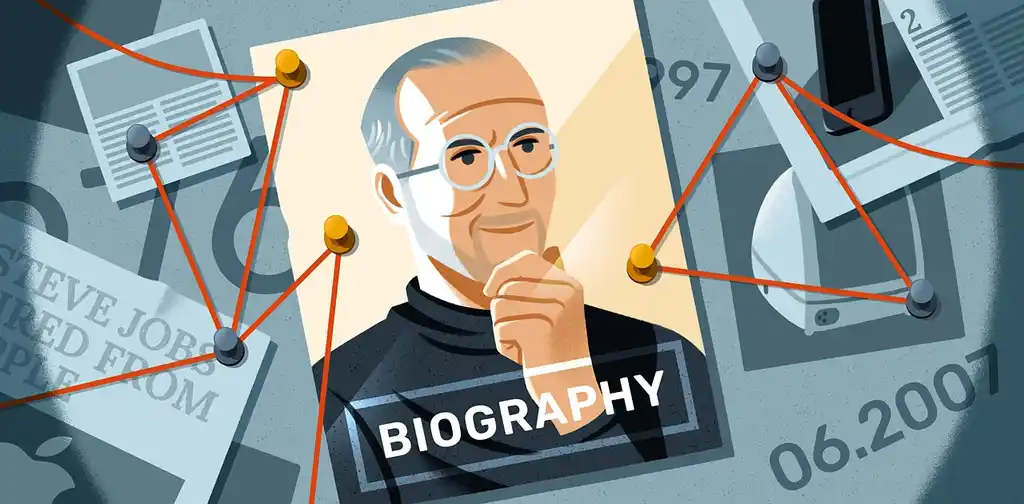
FREE RESOURCE
Biography Outline Template
Craft a satisfying story arc for your biography with our free template.
While you technically don’t need permission to write about public figures (or deceased ones), that doesn't guarantee their legal team won't pursue legal action against you. Author Kitty Kelley was sued by Frank Sinatra before she even started to write His Way , a biography that paints Ol Blue Eyes in a controversial light. (Kelley ended up winning the lawsuit, however).

Whenever feasible, advise the subject’s representatives of your intentions. If all goes according to plan, you’ll get a green light to proceed, or potentially an offer to collaborate. It's a matter of common sense; if someone were to write a book about you, you would likely want to know about it well prior to publication. So, make a sincere effort to reach out to their PR staff to negotiate an agreement or at least a mutual understanding of the scope of your project.
At the same time, make sure that you still retain editorial control over the project, and not end up writing a puff piece that treats its protagonist like a saint or hero. No biography can ever be entirely objective, but you should always strive for a portrayal that closely aligns with facts and reality.
If you can’t get an answer from your subject, or you’re asked not to proceed forward, you can still accept the potential repercussions and write an unauthorized biography . The “rebellious act” of publishing without consent indeed makes for great marketing, though it’ll likely bring more headaches with it too.
✋ Please note that, like other nonfiction books, if you intend to release your biography with a publishing house , you can put together a book proposal to send to them before you even write the book. If they like it enough, they might pay you an advance to write it.

Book Proposal Template
Craft a professional pitch for your nonfiction book with our handy template.
Once you’ve settled (or not) the permission part, it’s time to dive deep into your character’s story.
Deep and thorough research skills are the cornerstone of every biographer worth their salt. To paint a vivid and accurate portrait of someone's life, you’ll have to gather qualitative information from a wide range of reliable sources.
Start with the information already available, from books on your subject to archival documents, then collect new ones firsthand by interviewing people or traveling to locations.
Browse the web and library archives

Put your researcher hat on and start consuming any piece on your subject you can find, from their Wikipedia page to news articles, interviews, TV and radio appearances, YouTube videos, podcasts, books, magazines, and any other media outlets they may have been featured in.
Establish a system to orderly collect the information you find 一 even seemingly insignificant details can prove valuable during the writing process, so be sure to save them.
Depending on their era, you may find most of the information readily available online, or you may need to search through university libraries for older references.
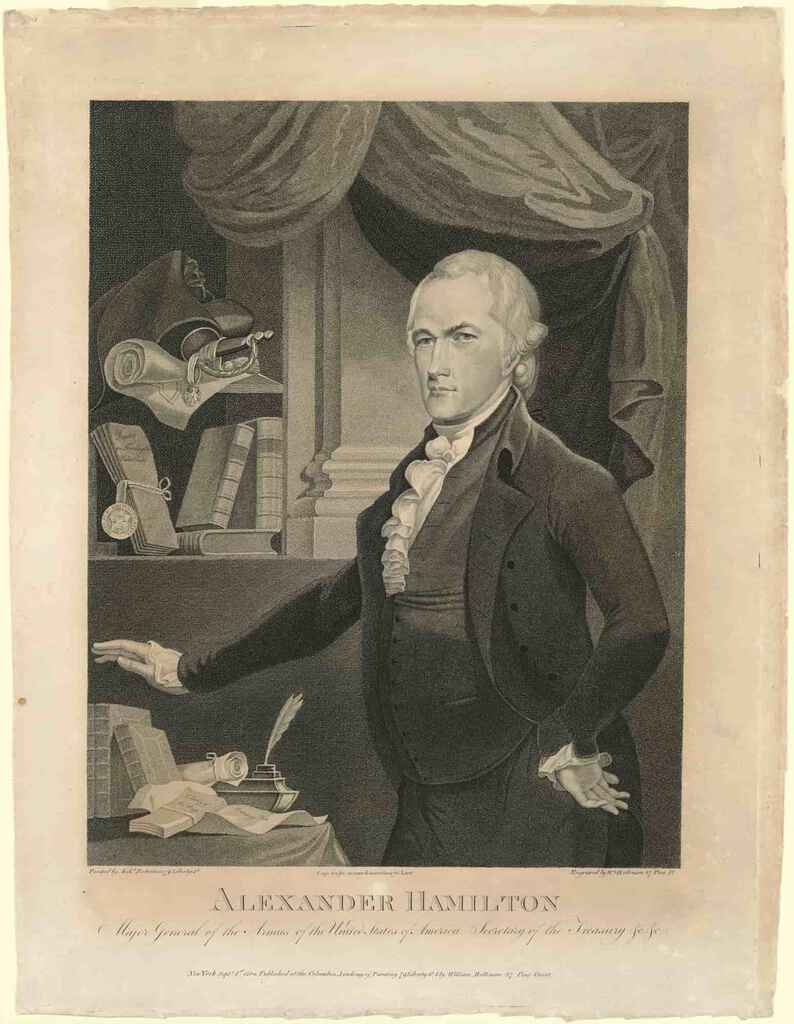
For his landmark biography of Alexander Hamilton, Ron Chernow spent untold hours at Columbia University’s library , reading through the Hamilton family papers, visiting the New York Historical Society, as well as interviewing the archivist of the New York Stock Exchange, and so on. The research process took years, but it certainly paid off. Chernow discovered that Hamilton created the first five securities originally traded on Wall Street. This finding, among others, revealed his significant contributions to shaping the current American financial and political systems, a legacy previously often overshadowed by other founding fathers. Today Alexander Hamilton is one of the best-selling biographies of all time, and it has become a cultural phenomenon with its own dedicated musical.
Besides reading documents about your subject, research can help you understand the world that your subject lived in.
Try to understand their time and social environment
Many biographies show how their protagonists have had a profound impact on society through their philosophical, artistic, or scientific contributions. But at the same time, it’s worth it as a biographer to make an effort to understand how their societal and historical context influenced their life’s path and work.
An interesting example is Stephen Greenblatt’s Will in the World . Finding himself limited by a lack of verified detail surrounding William Shakespeare's personal life, Greenblatt, instead, employs literary interpretation and imaginative reenactments to transport readers back to the Elizabethan era. The result is a vivid (though speculative) depiction of the playwright's life, enriching our understanding of his world.

Many readers enjoy biographies that transport them to a time and place, so exploring a historical period through the lens of a character can be entertaining in its own right. The Diary of Samuel Pepys became a classic not because people were enthralled by his life as an administrator, but rather from his meticulous and vivid documentation of everyday existence during the Restoration period.
Once you’ve gotten your hands on as many secondary sources as you can find, you’ll want to go hunting for stories first-hand from people who are (or were) close to your subject.
With all the material you’ve been through, by now you should already have a pretty good picture of your protagonist. But you’ll surely have some curiosities and missing dots in their character development to figure out, which you can only get by interviewing primary sources.
Interview friends and associates
This part is more relevant if your subject is contemporary, and you can actually meet up or call with relatives, friends, colleagues, business partners, neighbors, or any other person related to them.
In writing the popular biography of Steve Jobs, Walter Isaacson interviewed more than one hundred people, including Jobs’s family, colleagues, former college mates, business rivals, and the man himself.
🔍 Read other biographies to get a sense of what makes a great one. Check out our list of the 30 best biographies of all time , or take our 30-second quiz below for tips on which one you should read next.
Which biography should you read next?
Discover the perfect biography for you. Takes 30 seconds!
When you conduct your interviews, make sure to record them with high quality audio you can revisit later. Then use tools like Otter.ai or Descript to transcribe them 一 it’ll save you countless hours.
You can approach the interview with a specific set of questions, or follow your curiosity blindly, trying to uncover revealing stories and anecdotes about your subject. Whatever your method, author and biography editor Tom Bromley suggests that every interviewer arrives prepared, "Show that you’ve done your work. This will help to put the interviewee at ease, and get their best answers.”
Bromley also places emphasis on the order in which you conduct interviews. “You may want to interview different members of the family or friends first, to get their perspective on something, and then go directly to the main interviewee. You'll be able to use that knowledge to ask sharper, more specific questions.”
Finally, consider how much time you have with each interviewee. If you only have a 30-minute phone call with an important person, make it count by asking directly the most pressing questions you have. And, if you find a reliable source who is also particularly willing to help, conduct several interviews and ask them, if appropriate, to write a foreword as part of the book’s front matter .
Sometimes an important part of the process is packing your bags, getting on a plane, and personally visiting significant places in your character’s journey.
Visit significant places in their life
A place, whether that’s a city, a rural house, or a bodhi tree, can carry a particular energy that you can only truly experience by being there. In putting the pieces together about someone’s life, it may be useful to go visit where they grew up, or where other significant events of their lives happened. It will be easier to imagine what they experienced, and better tell their story.
In researching The Lost City of Z , author David Grann embarked on a trek through the Amazon, retracing the steps of British explorer Percy Fawcett. This led Grann to develop new theories about the circumstances surrounding the explorer's disappearance.

Hopefully, you won’t have to deal with jaguars and anacondas to better understand your subject’s environment, but try to walk into their shoes as much as possible.
Once you’ve researched your character enough, it’s time to put together all the puzzle pieces you collected so far.
Take the bulk of notes, media, and other documents you’ve collected, and start to give them some order and structure. A simple way to do this is by creating a timeline.
Create a chronological timeline
It helps to organize your notes chronologically 一 from childhood to the senior years, line up the most significant events of your subject’s life, including dates, places, names and other relevant bits.
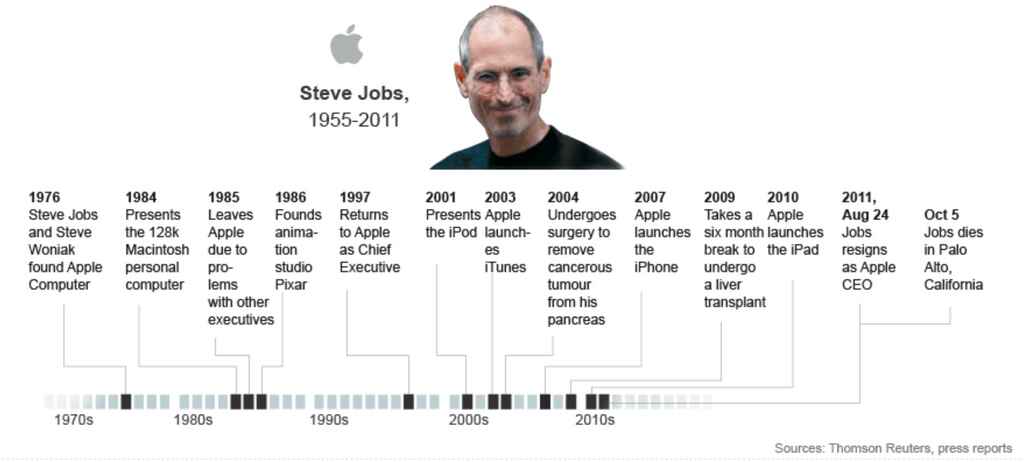
You should be able to divide their life into distinct periods, each with their unique events and significance. Based on that, you can start drafting an outline of the narrative you want to create.
Draft a story outline
Since a biography entails writing about a person’s entire life, it will have a beginning, a middle, and an end. You can pick where you want to end the story, depending on how consequential the last years of your subject were. But the nature of the work will give you a starting character arc to work with.
To outline the story then, you could turn to the popular Three-Act Structure , which divides the narrative in three main parts. In a nutshell, you’ll want to make sure to have the following:
- Act 1. Setup : Introduce the protagonist's background and the turning points that set them on a path to achieve a goal.
- Act 2. Confrontation : Describe the challenges they encounter, both internal and external, and how they rise to them. Then..
- Act 3. Resolution : Reach a climactic point in their story in which they succeed (or fail), showing how they (and the world around them) have changed as a result.
Only one question remains before you begin writing: what will be the main focus of your biography?
Think about why you’re so drawn to your subject to dedicate years of your life to recounting their own. What aspect of their life do you want to highlight? Is it their evil nature, artistic genius, or visionary mindset? And what evidence have you got to back that up? Find a central thesis or focus to weave as the main thread throughout your narrative.
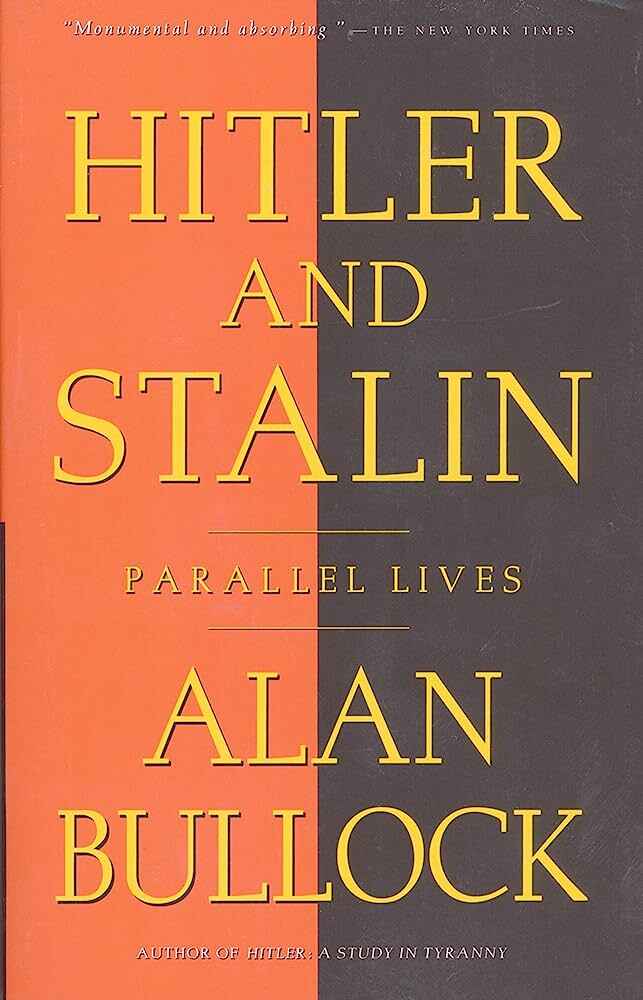
Or find a unique angle
If you don’t have a particular theme to explore, finding a distinct angle on your subject’s story can also help you distinguish your work from other biographies or existing works on the same subject.
Plenty of biographies have been published about The Beatles 一 many of which have different focuses and approaches:
- Philip Norman's Shout is sometimes regarded as leaning more towards a pro-Lennon and anti-McCartney stance, offering insights into the band's inner dynamics.
- Ian McDonald's Revolution in the Head closely examines their music track by track, shifting the focus back to McCartney as a primary creative force.
- Craig Brown's One Two Three Four aims to capture their story through anecdotes, fan letters, diary entries, and interviews.
- Mark Lewisohn's monumental three-volume biography, Tune In , stands as a testament to over a decade of meticulous research, chronicling every intricate detail of the Beatles' journey.
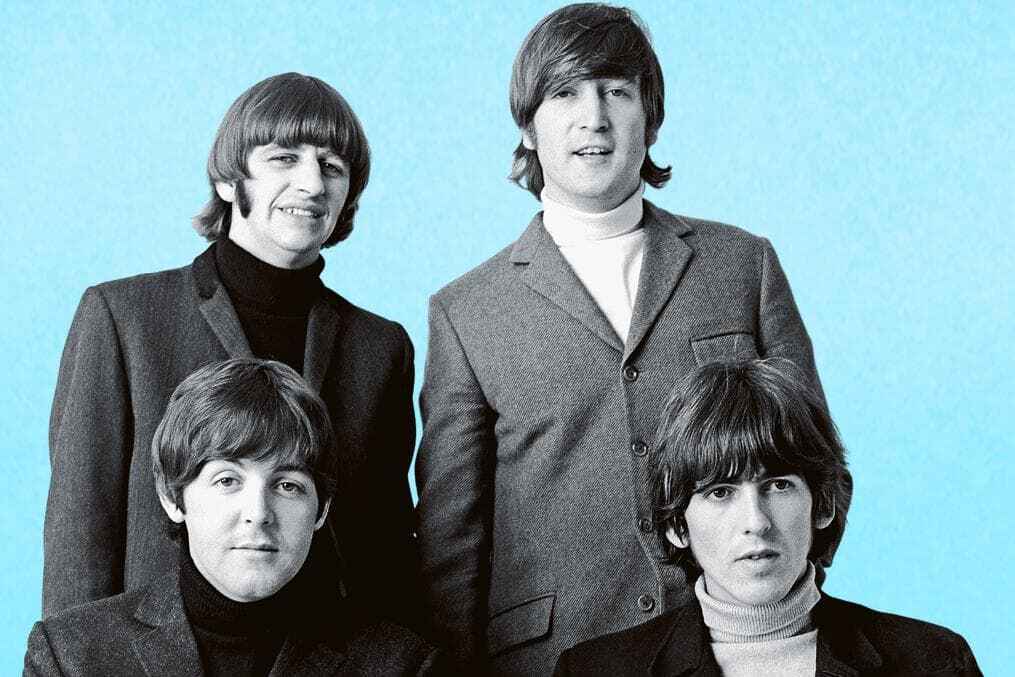
Finally, consider that biographies are often more than recounting the life of a person. Similar to how Dickens’ Great Expectations is not solely about a boy named Pip (but an examination and critique of Britain’s fickle, unforgiving class system), a biography should strive to illuminate a broader truth — be it social, political, or human — beyond the immediate subject of the book.
Once you’ve identified your main focus or angle, it’s time to write a great story.
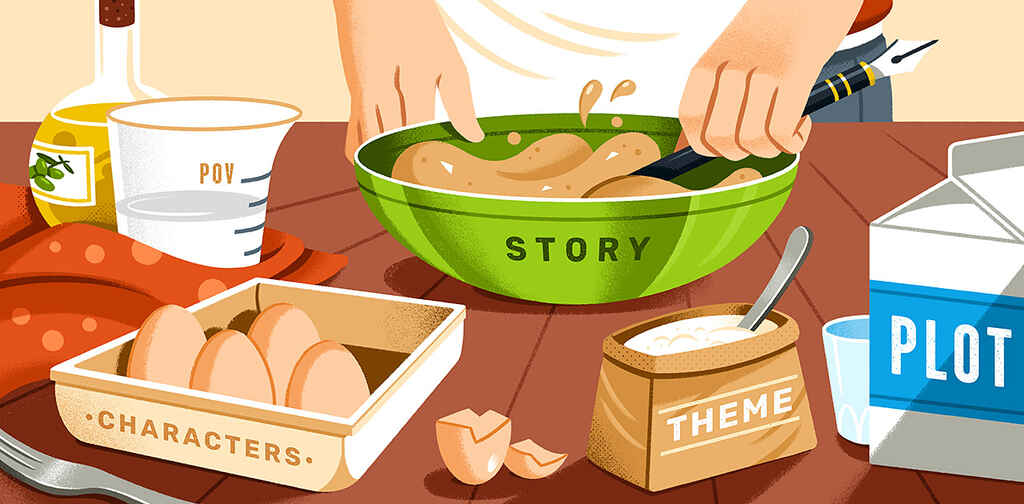
While biographies are often highly informative, they do not have to be dry and purely expository in nature . You can play with storytelling elements to make it an engaging read.
You could do that by thoroughly detailing the setting of the story , depicting the people involved in the story as fully-fledged characters , or using rising action and building to a climax when describing a particularly significant milestone of the subject’s life.
One common way to make a biography interesting to read is starting on a strong foot…
Hook the reader from the start
Just because you're honoring your character's whole life doesn't mean you have to begin when they said their first word. Starting from the middle or end of their life can be more captivating as it introduces conflicts and stakes that shaped their journey.
When he wrote about Christopher McCandless in Into the Wild , author Jon Krakauer didn’t open his subject’s childhood and abusive family environment. Instead, the book begins with McCandless hitchhiking his way into the wilderness, and subsequently being discovered dead in an abandoned bus. By starting in the middle of the action in medias res, Krakauer hooks the reader’s interest, before tracing back the causes and motivations that led McCandless to die alone in that bus in the first place.

You can bend the timeline to improve the reader’s reading experience throughout the rest of the story too…
Play with flashback
While biographies tend to follow a chronological narrative, you can use flashbacks to tell brief stories or anecdotes when appropriate. For example, if you were telling the story of footballer Lionel Messi, before the climax of winning the World Cup with Argentina, you could recall when he was just 13 years old, giving an interview to a local newspaper, expressing his lifelong dream of playing for the national team.
Used sparsely and intentionally, flashbacks can add more context to the story and keep the narrative interesting. Just like including dialogue does…
Reimagine conversations
Recreating conversations that your subject had with people around them is another effective way to color the story. Dialogue helps the reader imagine the story like a movie, providing a deeper sensory experience.

One thing is trying to articulate the root of Steve Jobs’ obsession with product design, another would be to quote his father , teaching him how to build a fence when he was young: “You've got to make the back of the fence just as good looking as the front of the fence. Even though nobody will see it, you will know. And that will show that you're dedicated to making something perfect.”
Unlike memoirs and autobiographies, in which the author tells the story from their personal viewpoint and enjoys greater freedom to recall conversations, biographies require a commitment to facts. So, when recreating dialogue, try to quote directly from reliable sources like personal diaries, emails, and text messages. You could also use your interview scripts as an alternative to dialogue. As Tom Bromley suggests, “If you talk with a good amount of people, you can try to tell the story from their perspective, interweaving different segments and quoting the interviewees directly.”

FREE COURSE
How to Write Believable Dialogue
Master the art of dialogue in 10 five-minute lessons.
These are just some of the story elements you can use to make your biography more compelling. Once you’ve finished your manuscript, it’s a good idea to ask for feedback.
If you’re going to publish your own biography, you’ll have to polish it to professional standards. After leaving your work to rest for a while, look at it with fresh eyes and edit your own manuscript eliminating passive voice, filler words, and redundant adverbs.

Then, have a professional editor give you a general assessment. They’ll look at the structure and shape of your manuscript and tell you which parts need to be expanded on or cut. As someone who edited and commissioned several biographies, Tom Bromley points out that a professional “will look at the sources used and assess whether they back up the points made, or if more are needed. They would also look for context, and whether or not more background information is needed for the reader to understand the story fully. And they might check your facts, too.”
In addition to structural editing, you may want to have someone copy-edit and proofread your work.

MEET EDITORS
Polish your book with expert help
Sign up, meet 1500+ experienced editors, and find your perfect match.
Importantly, make sure to include a bibliography with a list of all the interviews, documents, and sources used in the writing process. You’ll have to compile it according to a manual of style, but you can easily create one by using tools like EasyBib . Once the text is nicely polished and typeset in your writing applications , you can prepare for the publication process.
In conclusion, by mixing storytelling elements with diligent research, you’ll be able to breathe life into a powerful biography that immerses readers in another individual’s life experience. Whether that’ll spark inspiration or controversy, remember you could have an important role in shaping their legacy 一 and that’s something not to take lightly.
Continue reading
Recommended posts from the Reedsy Blog

100+ Character Ideas (and How to Come Up With Your Own)
Character creation can be challenging. To help spark your creativity, here’s a list of 100+ character ideas, along with tips on how to come up with your own.

How to Introduce a Character: 8 Tips To Hook Readers In
Introducing characters is an art, and these eight tips and examples will help you master it.

450+ Powerful Adjectives to Describe a Person (With Examples)
Want a handy list to help you bring your characters to life? Discover words that describe physical attributes, dispositions, and emotions.

How to Plot a Novel Like a NYT Bestselling Author
Need to plot your novel? Follow these 7 steps from New York Times bestselling author Caroline Leavitt.

How to Write an Autobiography: The Story of Your Life
Want to write your autobiography but aren’t sure where to start? This step-by-step guide will take you from opening lines to publishing it for everyone to read.
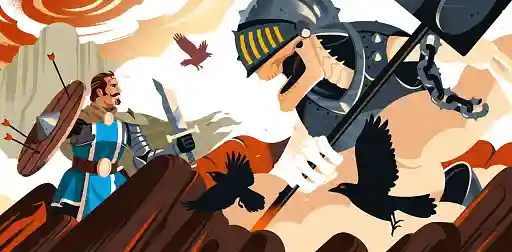
What is the Climax of a Story? Examples & Tips
The climax is perhaps a story's most crucial moment, but many writers struggle to stick the landing. Let's see what makes for a great story climax.
Join a community of over 1 million authors
Reedsy is more than just a blog. Become a member today to discover how we can help you publish a beautiful book.

We made a writing app for you
Yes, you! Write. Format. Export for ebook and print. 100% free, always.

1 million authors trust the professionals on Reedsy. Come meet them.
Enter your email or get started with a social account:
Is MasterClass right for me?
Take this quiz to find out.
How to Write a Short Bio: 7 Things to Put in Your Bio
Written by MasterClass
Last updated: Jan 21, 2022 • 4 min read
Whether for your company’s website or your own personal use, it's important to know how to write a short bio about yourself and your personal accomplishments. These little blurbs help you stand out from the crowd by showing what makes you a unique and qualified addition to the workforce.

- If the subject does not give you permission to write the biography, you may want to choose a different subject. If you decide to publish the biography without the subject’s permission, you may be susceptible to legal action by the subject.
- If the subject is no longer alive, you obviously do not need to ask permission to write about them.

- You may create research questions to help focus your research of the subject, such as, What do I find interesting about the subject? Why is this subject important to readers? What can I say that is new about the subject? What would I like to learn more about?

- For in person interviews, record them with a tape recorder or a voice recorder on your computer or phone.
- You may need to interview the subject and others several times to get the material you need.

- You may also want to visit areas where the subject made a major decision or breakthrough in their life. Being physically in the area can give you a sense of how the subject might have felt and help you write their experiences more effectively.

- When researching the time period ask yourself: What were the social norms of that time? What was going on economically and politically? How did the social and political climate affect the subject?

- You may also include historical events or moments that affected the subject on the timeline. For example, maybe there was a conflict or civil war that happened during the person’s life that affected their life.
Writing the Biography

- You may end up focusing on particular areas of the person’s life. If you do this, work through a particular period in the person’s life chronologically.

- For example, you may have a thesis statement about focusing on how the person impacted the civil rights movement in America in the 1970s. You can then make sure all your content relates back to this thesis.

- Flashbacks should feel as detailed and real as present day scenes. Use your research notes and interviews with the subject to get a good sense of their past for the flashbacks.
- For example, you may jump from the person’s death in the present to a flashback to their favorite childhood memory.

- For example, you may focus on the person’s accomplishments in the civil rights movement. You may write a whole section about their contributions and participation in major civil rights marches in their hometown.

- For example, you may notice that the person’s life is patterned with moments of adversity, where the person worked hard and fought against larger forces. You can then use the theme of overcoming adversity in the biography.

- For example, you may note how you see parallels in the person’s life during the civil rights movement with your own interests in social justice. You may also commend the person for their hard work and positive impact on society.
Polishing the Biography

- Revise the biography based on feedback from others. Do not be afraid to cut or edit down the biography to suit the needs of your readers.

- Having a biography riddled with spelling, grammar, and punctuation errors can turn off your readers and result in a poor grade if you are handing in the text for a class.

- If the biography is for a class, use MLA , APA , or Chicago Style citations based on the preferences of your instructor.
Biography Help

Community Q&A
- Be careful when publishing private or embarrassing information, especially if the person is not a celebrity. You may violate their "Right of Privacy" or equivalent. Thanks Helpful 31 Not Helpful 5
- Have the sources to back up your statements about the subject's life. Untruthful written statements can lead to litigation. If it is your opinion, be clear that it is such and not fact (although you can support your opinion with facts). Thanks Helpful 16 Not Helpful 15

You Might Also Like

- ↑ https://grammar.yourdictionary.com/writing/how-to-write-a-biography.html
- ↑ https://au.indeed.com/career-advice/career-development/how-to-write-a-bio
- ↑ https://www.writersdigest.com/writing-articles/3-tips-for-writing-successful-flashbacks
- ↑ https://www.grammarly.com/blog/how-to-write-bio/
- ↑ https://writingcenter.unc.edu/tips-and-tools/editing-and-proofreading/
- ↑ https://www.plagiarism.org/article/how-do-i-cite-sources
About This Article

Before you write a biography, gather as much information about the subject that you can from sources like newspaper articles, interviews, photos, existing biographies, and anything else you can find. Write the story of that person’s life, including as much supporting detail as you can, including information about the place and time where the person lived. Focus on major events and milestones in their life, including historical events, marriage, children, and events which would shape their path later in life. For tips from our reviewer on proofreading the biography and citing your sources, keep reading! Did this summary help you? Yes No
- Send fan mail to authors
Reader Success Stories
Jan 24, 2021
Did this article help you?
Janis Hendrick
Oct 10, 2018
Teresa Bradley
Sep 15, 2020
Apr 18, 2016
Latanya Foster
Apr 26, 2016

Featured Articles

Trending Articles

Watch Articles

- Terms of Use
- Privacy Policy
- Do Not Sell or Share My Info
- Not Selling Info
wikiHow Tech Help Pro:
Level up your tech skills and stay ahead of the curve
How to Write an Interesting Biography
- Homework Tips
- Learning Styles & Skills
- Study Methods
- Time Management
- Private School
- College Admissions
- College Life
- Graduate School
- Business School
- Distance Learning
- M.Ed., Education Administration, University of Georgia
- B.A., History, Armstrong State University
A biography is a written account of the series of events that make up a person's life. Some of those events are going to be pretty boring, so you'll need to try to make your account as interesting as possible!
Every student will write a biography at some point, but the level of detail and sophistication will differ. A fourth grade biography will be much different from a middle school-level biography or a high school or college-level biography.
However, each biography will include the basic details. The first information you should gather in your research will include biographical details and facts. You must use a trustworthy resource to ensure that your information is accurate.
Using research note cards , collect the following data, carefully recording the source for each piece of information:
Including Basic Details
- Date and place of birth and death
- Family information
- Lifetime accomplishments
- Major events of life
- Effects/impact on society, historical significance
While this information is necessary to your project, these dry facts, on their own, don't really make a very good biography. Once you've found these basics, you'll want to dig a little deeper.
You choose a certain person because you think he or she is interesting, so you certainly don't want to burden your paper with an inventory of boring facts. Your goal is to impress your reader!
Start off with great first sentence . It's a good idea to begin with a really interesting statement, a little-known fact, or really intriguing event.
You should avoid starting out with a standard but boring line like:
"Meriwether Lewis was born in Virginia in 1774."
Instead, try starting with something like this:
"Late one afternoon in October, 1809, Meriwether Lewis arrived at a small log cabin nestled deep in the Tennessee Mountains. By sunrise on the following day, he was dead, having suffered gunshot wounds to the head and chest.
You'll have to make sure your beginning is motivating, but it should also be relevant. The next sentence or two should lead into your thesis statement , or main message of your biography.
"It was a tragic end to a life that had so deeply affected the course of history in the United States. Meriwether Lewis, a driven and often tormented soul, led an expedition of discovery that expanded a young nation's economic potential, increased its scientific understanding, and enhanced its worldwide reputation."
Now that you've created an impressive beginning , you'll want to continue the flow. Find more intriguing details about the man and his work, and weave them into the composition.
Examples of Interesting Details:
- Some people believed that Lewis and Clark would encounter elephants in the western wilderness, having misunderstood the wooly mammoth bones discovered in the United States.
- The expedition resulted in the discovery and description of 122 new animal species and subspecies.
- Lewis was a hypochondriac.
- His death is still an unsolved mystery, although it was ruled a suicide.
You can find interesting facts by consulting diverse sources.
Fill the body of your biography with material that gives insight into your subject's personality. For instance, in a biography about Meriwether Lewis, you would ask what traits or events motivated him to embark on such a monumental exercise.
Questions to Consider in Your Biography:
- Was there something in your subject's childhood that shaped his/her personality?
- Was there a personality trait that drove him/her to succeed or impeded his progress?
- What adjectives would you use to describe him/her?
- What were some turning points in this life?
- What was his/her impact on history?
Be sure to use transitional phrases and words to link your paragraphs and make your composition paragraphs flow . It is normal for good writers to re-arrange their sentences to create a better paper.
The final paragraph will summarize your main points and re-assert your main claim about your subject. It should point out your main points, re-name the person you're writing about, but it should not repeat specific examples.
As always, proofread your paper and check for errors. Create a bibliography and title page according to your teacher's instructions. Consult a style guide for proper documentation.
- Famous People for Biography Topics
- How to Design a Book Cover
- How to Help Your 4th Grader Write a Biography
- Character Traits: Ideas for Your Short Story
- 5 Tips on How to Write a Speech Essay
- 10 Tips for the SAT Essay
- Writing a Paper about an Environmental Issue
- Writing the Parts of a Stage Play Script
- How to Use Libraries and Archives for Research
- Questions to Ask a College Representative
- How to Write a Graduation Speech as Valedictorian
- Tips to Write a Great Letter to the Editor
- How to Write and Structure a Persuasive Speech
- How to Write a Film Review
- 18 Ways to Practice Spelling Words
- How to Give an Impromptu Speech

IMAGES
VIDEO
COMMENTS
How do you write a strong one line biography? Here are examples from some of the world's most recognized names in tech.
Part 1 How to Write a Short Bio When writing a short bio, first focus on being concise and relevant. A short bio should be approximately 4-6 sentences or about 150 words. Be sure to highlight your achievements, experience, and expertise with confidence and clarity.
Explore 40 short professional bio examples, discover the purpose, content and format of a short professional bio and review four steps on how to write one.
Learn how to write a short professional bio that showcases your skills, achievements, and personality. Check out 20 inspiring examples from various fields.
Writing a short bio is an important part of introducing yourself to potential employers, clients or contacts. Your short bio has the potential to help you make positive impressions that can impact your professional development and success. If you are interested in learning how to write effective short bios, you'll need to know what to include and what an effective short bio should look like ...
Your short bio should include your brand, your accomplishments, and your values and goals. Your short bio should be one to three short paragraphs or four to eight sentences long. Knowing how to write a concise, informative, and interesting biography about yourself can help throughout various parts of the professional process.
With nine writing tips and three professional bio examples, you'll have all the tools you need to craft a bio that captures your audience's attention.
Writing a good short professional bio is more important than ever. Learn what to include and discover short professional bio examples to use as a guide.
Learn how to effectively summarize your career accomplishments with this guide to writing a short professional bio.
Writing a biography can be a rewarding endeavor, but it can also feel a bit daunting if you've never written one before. Whether you're capturing the life story of a famous person, a family member, or even yourself, creating a compelling biography involves a mix of thorough research, narrative skill, and a personal touch. So, how exactly do you write a successful biography? In this guide ...
A Twitter bio is super short, and you can only make a strong impression if you choose carefully what to write. If you have three sentences, for instance for an author bio, then you can say a little more. But be careful, the same rule applies as with the one-sentence Twitter bio.
Your professional bio gives the world a brief snapshot of you and your ideals. Learn how to write a powerful bio and find inspiration from these examples.
Resume bio: This is similar to a resume summary but will focus more on your top accomplishments and accolades. It'll typically be a short two to three sentence description of your professional skills, achievements, and career goals.
How to write a short bio When most people think of online bios, they probably can readily name a few common short bio examples first. Twitter, Instagram, Facebook, and Pinterest all have space for a short description of who you are and what you do. And you should make the most of the 1-2 lines you're afforded here. Keep your social media bios short, sweet, and only filled with the most ...
Biographies are how we learn information about another human being's life. Whether you want to start writing a biography about a famous person, historical figure, or an influential family member, it's important to know all the elements that make a biography worth both writing and reading.
2. Introduce yourself… like a real person. This is one of the most important pieces of understanding how to write a personal biography. Always start with your name. When many people start learning how to write a bio, they skip this important part. People need to know who you are before they learn what you do.
Only one question remains before you begin writing: what will be the main focus of your biography? 5. Identify a central thesis Think about why you're so drawn to your subject to dedicate years of your life to recounting their own. What aspect of their life do you want to highlight? Is it their evil nature, artistic genius, or visionary mindset?
Whether for your company's website or your own personal use, it's important to know how to write a short bio about yourself and your personal accomplishments. These little blurbs help you stand out from the crowd by showing what makes you a unique and qualified addition to the workforce.
Compelling biographies help us better connect with others while fostering empathy and understanding. Discover the steps to write one!
Writing a biography can be a fun challenge, where you are sharing the story of someone's life with readers. You may need to write a biography for a class or decide to write one as a personal project. Once you have identified the subject of...
Master the skill of biography writing with our comprehensive guide. Learn how to write a biography, bios, access examples, and classroom resources.
However, each biography will include the basic details. The first information you should gather in your research will include biographical details and facts. You must use a trustworthy resource to ensure that your information is accurate.